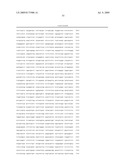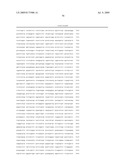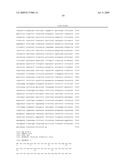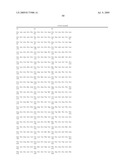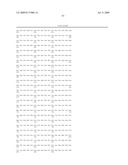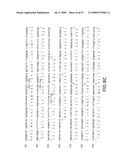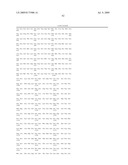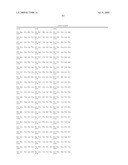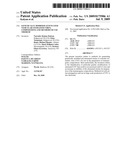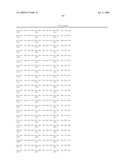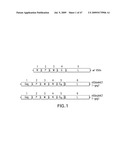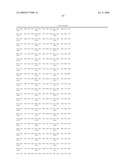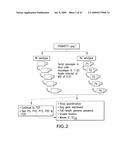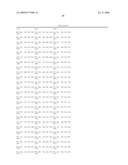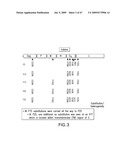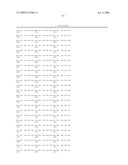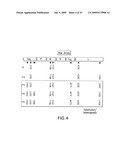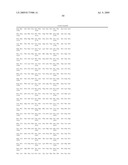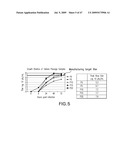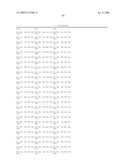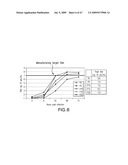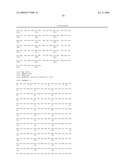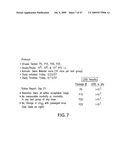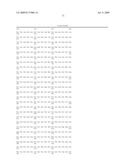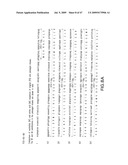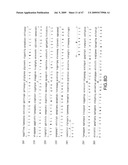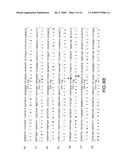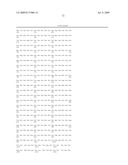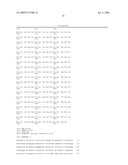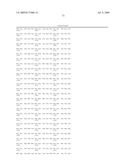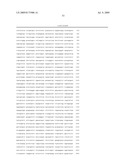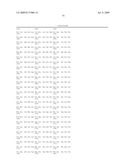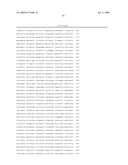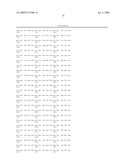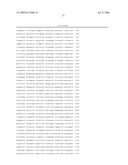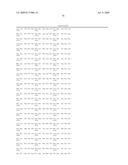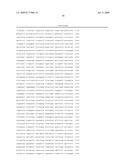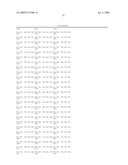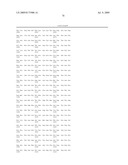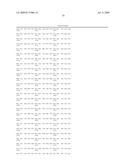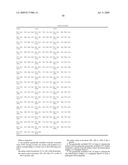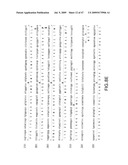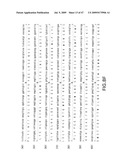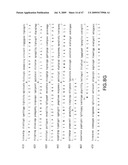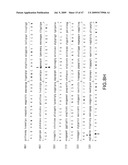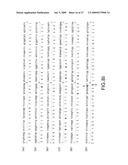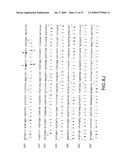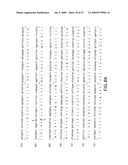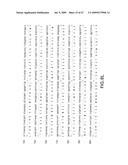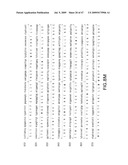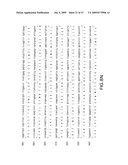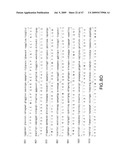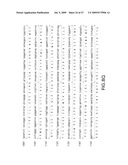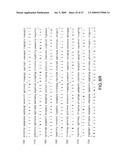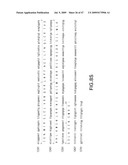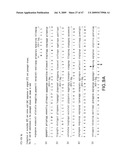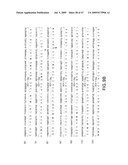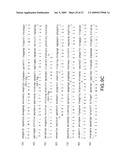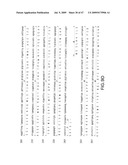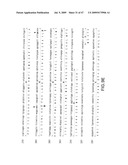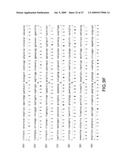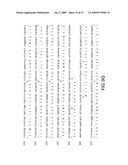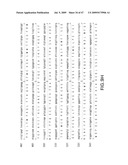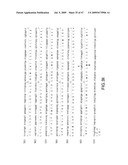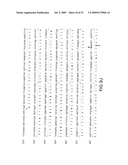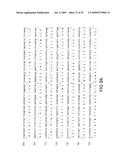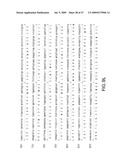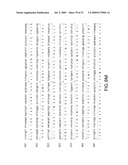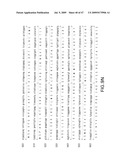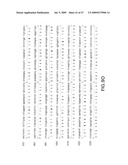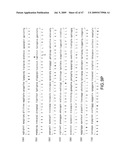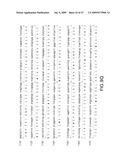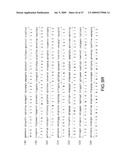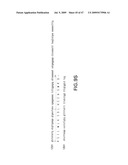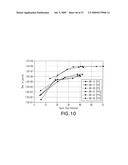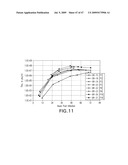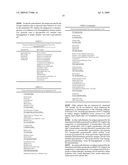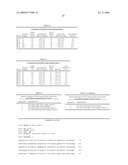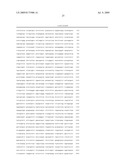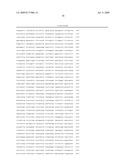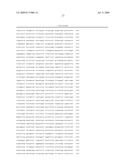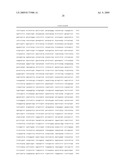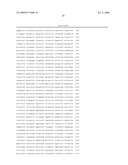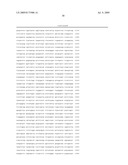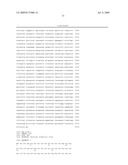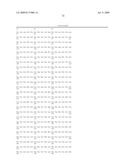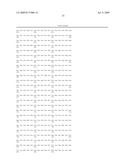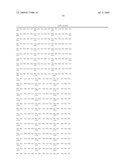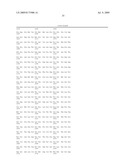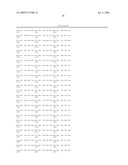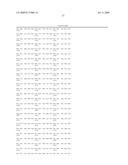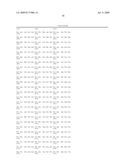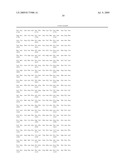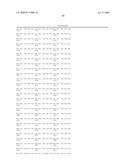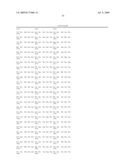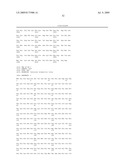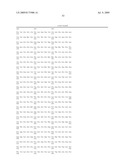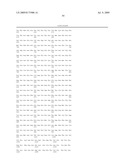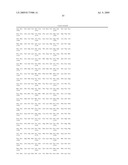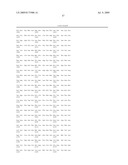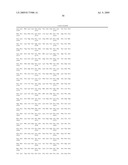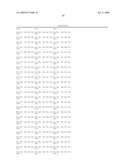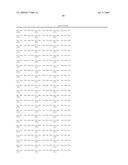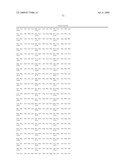Patent application title: Genetically Modified Attenuated Vesicular Stomatitis Virus, Compositions and Methods of use Thereof
Inventors:
Narender Kumar Kalyan (Ridgewood, NJ, US)
Irina Yurgelonis (Ridgewood, NJ, US)
Roger Michael Hendry (Atlanta, GA, US)
Mark William Cutler (Bloomingdale, NJ, US)
Kristen Elissa Syvertsen (Tarrytown, NY, US)
Assignees:
Wyeth
IPC8 Class: AA61K3912FI
USPC Class:
4242051
Class name: Antigen, epitope, or other immunospecific immunoeffector (e.g., immunospecific vaccine, immunospecific stimulator of cell-mediated immunity, immunospecific tolerogen, immunospecific immunosuppressor, etc.) virus or component thereof reassortant or deletion mutant virus
Publication date: 2009-07-09
Patent application number: 20090175906
Claims:
1. An isolated, genetically modified vesicular stomatitis virus (VSV)
having at least one amino acid mutation in a region corresponding to at
least one of the following positions:the amino acids at positions 119 or
142 of the M protein;the amino acids at positions 109, 224, 438, 477, or
481 of the G protein; andthe amino acids at positions 205, 220 or 1450 of
the L protein.
2. The genetically modified VSV of claim 1, wherein the nucleic acid encoding the genetically modified VSV further comprises a nucleic acid encoding at least one heterologous antigen, or a fragment thereof.
3. The genetically modified VSV of claim 1, wherein the one heterologous antigen, or a fragment thereof is from a pathogenic microorganism.
4. The genetically modified VSV of claim 3, wherein the pathogenic microorganism from which the nucleic acid encoding the heterologous antigen is obtained is selected from the group consisting of a virus, a bacterium, a protozoan and a fungus.
5. The genetically modified VSV of claim 4, wherein the heterologous antigen is selected from the group consisting of a human immunodeficiency virus (HIV) antigen, an HTLV antigen, an SIV antigen, an RSV antigen, a PIV antigen, an HSV antigen, a CMV antigen, an Epstein-Barr virus antigen, a Varicella-Zoster virus antigen, a mumps virus antigen, a measles virus antigen, an influenza virus antigen, a poliovirus antigen, a rhinovirus antigen, a hepatitis A virus antigen, a hepatitis B virus antigen, a hepatitis C virus antigen, a Norwalk virus antigen, a togavirus antigen, an alphavirus antigen, a rubella virus antigen, a rabies virus antigen, a Marburg virus antigen, an Ebola virus antigen, a papilloma virus antigen, a polyoma virus antigen, a metapneumovirus antigen, a coronavirus antigen, a Vibrio cholerae antigen, a Plasmodium falciparum antigen, a Plasmodium vivax antigen, a Plasmodium ovate antigen, a Plasmodium malariae antigen, a Plasmodium knowlesi antigen, a Streptococcus pneumoniae antigen, Streptococcus pyogenes antigen, a Helicobacter pylori antigen, a Streptococcus agalactiae antigen, a Neisseria meningitidis antigen, a Neisseria gonorrhoeae antigen, a Corynebacterium diphtheriae antigen, a Clostridium tetani antigen, a Bordetella pertussis antigen, a Haemophilus antigen, a Chlamydia antigen and an Escherichia coli antigen.
6. The genetically modified VSV of claim 5, wherein the heterologous antigen comprises an HIV protein.
7. The genetically modified VSV of claim 6, wherein the HIV protein is encoded by a gene selected from the group consisting of gag, env, pol, vif, nef, tat, vpr, rev and vpu.
8. The genetically modified VSV of claim 6, wherein the HIV protein is an HIV gag protein.
9. The genetically modified VSV of claim 8, wherein the HIV gag protein has at least one mutation at position 165, 270, 329, or 348.
10. The genetically modified VSV of claim 1, wherein the mutation comprises a conservative or non-conservative amino acid change.
11. The genetically modified VSV of claim 1, wherein the mutation is at either position 119 or 142 of the M protein or is at both positions 119 and 142 of the M protein.
12. The genetically modified VSV of claim 1, wherein the mutation of the amino acid at position 119 of the M protein is a T→N mutation and the mutation of the amino acid at position 142 of the M protein is a P→T mutation.
13. The genetically modified VSV of claim 1, wherein the mutation of the amino acids at position 109, 224, 438, 477 or 481 of the G protein is a K→N, N→T, S→I, A→V/G L, or V→I mutation, respectively.
14. The genetically modified VSV of claim 1, wherein the mutation of the amino acid at position 205, 220 or 1450 of the L protein is P→L, K→E, or L→I, respectively.
15. The genetically modified VSV of claim 9, wherein the mutation of amino acids at position 165, 270, 329 or 348 of the HIV gag protein is S→G, L→S, D→N or T→K, respectively.
16. The genetically modified VSV of claim 15, wherein the mutation in any one or more of the amino acids results in increased stability of the virus genotype and/or phenotype.
17. The genetically modified VSV of claim 16, wherein the mutation of any one or more of the amino acids further results in increased yield in virus production from a cell infected with said virus.
18. The genetically modified VSV of claim 1, further comprising at least two other mutations in its genome, the mutations selected from the group consisting of a temperature-sensitive mutation, a point mutation, a gene shuffling mutation, a G-stem mutation, a non-cytopathic M gene mutation, an ambisense RNA mutation, a truncated G gene mutation, a G gene insertion mutation and a gene deletion mutation.
19. A method for producing the genetically modified VSV of claim 1, the method comprising serial passaging of a VSV in a continuous mammalian cell line at a low multiplicity of infection (MOI) ranging from about 0.001 to about 0.1 plaque forming units (PFU)/ml for at least 5-15 passages, wherein the virus has a titer of at least 1.times.10.sup.6 PFU/ml and at least one or more of the mutations of any one of claims 1 through 14.
20. The method of claim 19, wherein the virus has a titer of at least 1.times.10.sup.7 PFU/ml.
21. The method of claim 20, wherein the cell line is a Vero, BHK, or 293 cell line.
22. The method of claim 21, wherein the method results in a 5 to 100 fold higher yield of virus compared to that obtained with a virus strain that has not been passaged for about 5 to 15 times at a low MOI ranging from about 0.001 to about 0.1 plaque forming units (PFU)/cell.
23. The method of claim 22, wherein the genetically modified VSV demonstrates an increase in stability of the virus genotype and/or phenotype.
24. An immunogenic composition comprising any one or more of the genetically modified VSV of claim 15 and a pharmaceutically acceptable carrier.
25. The immunogenic composition of claim 24, further comprising an adjuvant.
26. A method for protecting a mammal against infection with a pathogenic microorganism, the method comprising administering an immunologically effective amount of the genetically modified VSV of claim 15.
27. A method for protecting a mammal against infection with a pathogenic microorganism, the method comprising administering an immunologically effective amount of the immunogenic composition of claim 25.
28. A method for adapting a virus for growth in cell culture comprisinga. infecting the cell culture with the virus at a low multiplicity-of-infection (MOI) ranging from about 0.001 to about 0.1 plaque forming units (PFU) per cell;b. harvesting the cell culture medium containing the virus;c. clarifying the cell culture medium;d. freezing the cell culture medium; ande. repeating steps a) through d) for about 5 to about 15 times,wherein the method results in a 5 to 100 fold increase in virus production/yield and an increase in the stability of the virus genotype and phenotype characteristics.
29. The method of claim 28, wherein the virus is an attenuated virus.
30. The method of claim 29, wherein the method allows for maintaining any pre-existing mutation(s) associated with virus attenuation.
31. The method of claim 29, wherein the method allows for maintaining a low neurovirulence profile associated with virus attenuation.
32. The method of claim 28, wherein the method is used for large scale production of an immunogenic composition.
33. The method of claim 32, wherein the method results in a 5 to 100 fold higher yield of virus compared to that obtained with a virus strain that has not been passaged for about 5 to 15 times at a low multiplicity of infection ranging from about 0.001 to about 0.1 plaque forming units per cell.
34. The method of claim 30, wherein the pre-existing mutation(s) associated with virus attenuation is selected from the group consisting of a temperature-sensitive mutation, a point mutation, a gene shuffling mutation, a G-stem mutation, a non-cytopathic M gene mutation, an ambisense RNA mutation, a truncated G gene mutation, a G gene insertion mutation and a gene deletion mutation.
35. The method of claim 29, wherein the attenuated virus is a strain of vesicular stomatitis virus (VSV).
36. The method of claim 30, wherein the VSV has at least one amino acid mutation in a region corresponding to at least one of the following positions:the amino acids at positions 119 or 142 of the M protein;the amino acids at positions 109, 224, 438, 477, or 481 of the G protein; andthe amino acids at positions 205, 220 or 1450 of the L protein.
37. The method of claim 36, wherein the mutation comprises a conservative or non-conservative amino acid change.
38. The method of claim 36, wherein the mutation is at either position 119 or 142 of the M protein or is at both positions 119 and 142 of the M protein.
39. The method of claim 38, wherein the mutation of the amino acid at position 119 of the M protein is a T→N mutation and the mutation of the amino acid at position 142 of the M protein is a P→T mutation.
40. The method of claim 36, wherein the mutation of the amino acids at position 109, 224, 438, 477 or 481 of the G protein is a K→N, N→T, S→I, (A→V/G→L), or V→I mutation, respectively.
41. The method of claim 36, wherein the mutation of the amino acid at position 205, 220 or 1450 of the L protein is P→L, K→E, or L→I, respectively.
42. The method of claim 35, wherein the strain of VSV is selected from the Indiana strain or the New Jersey strain or Isfahan serotype or other vesiculoviruses.
43. The method of claim 36, wherein the strain of VSV contains a nucleic acid encoding at least one heterologous antigen.
44. The method of claim 43, wherein the heterologous antigen is obtained from a pathogenic microorganism selected from the group consisting of a virus, a bacterium, a protozoan and a fungus.
45. The method of claim 43, wherein the heterologous antigen is selected from the group consisting of a human immunodeficiency virus (HIV) antigen, an HTLV antigen, an SIV antigen, an RSV antigen, a PIV antigen, an HSV antigen, a CMV antigen, an Epstein-Barr virus antigen, a Varicella-Zoster virus antigen, a mumps virus antigen, a measles virus antigen, an influenza virus antigen, a poliovirus antigen, a rhinovirus antigen, a hepatitis A virus antigen, a hepatitis B virus antigen, a hepatitis C virus antigen, a Norwalk virus antigen, a togavirus antigen, an alphavirus antigen, a rubella virus antigen, a rabies virus antigen, a Marburg virus antigen, an Ebola virus antigen, a papilloma virus antigen, a polyoma virus antigen, a metapneumovirus antigen, a coronavirus antigen, a Vibrio cholerae antigen, a Plasmodium falciparum antigen, a Plasmodium vivax antigen, a Plasmodium ovale antigen, a Plasmodium malariae antigen, a Plasmodium knowlesi antigen, a Streptococcus pneumoniae antigen, Streptococcus pyogenes antigen, a Helicobacter pylori antigen, a Streptococcus agalactiae antigen, a Neisseria meningitidis antigen, a Neisseria gonorrhoeae antigen, a Corynebacterium diphtheriae antigen, a Clostridium tetani antigen, a Bordetella pertussis antigen, a Haemophilus antigen, a Chlamydia antigen, and an Escherichia coli antigen.
46. The method of claim 43, wherein the heterologous antigen comprises an HIV protein.
47. The method of claim 46, wherein the HIV protein is encoded by a gene selected from the group consisting of gag, env, pol, vif, nef, tat, vpr, rev and vpu.
48. The method of claim 46, wherein the HIV protein is an HIV gag protein.
49. The method of claim 48, wherein the HIV gag protein has at least one mutation at position 165, 270, 329 or 348.
50. The method of claim 49, wherein the mutation of the amino acid at position 165, 270, 329 or 348 of the HIV gag protein is S→G, L→S, D→N, or T→K, respectively.
Description:
CROSS-REFERENCE TO RELATED APPLICATIONS
[0001]This application claims priority to U.S. provisional application No. 61/015,868, filed on Dec. 21, 2007, which is incorporated herein by reference in its entirety.
FIELD OF THE INVENTION
[0003]The present invention relates generally to negative-strand RNA viruses. In particular, the invention relates to methods and compositions for adapting Vesicular Stomatitis Virus (VSV) particles to growth in cell culture for use in production.
BACKGROUND TO THE INVENTION
[0004]Vesicular stomatitis virus (VSV) is a prototypic virus of the Rhabdoviridae family, belonging to the order Mononegavirales, which includes single stranded, non-segmented, negative-sense RNA viruses with highly conserved gene order. The 11-kb VSV genome contains five genes encoding five viral proteins: the nucleocapsid protein (N), the phosphoprotein (P), the matrix protein (M), the attachment glycoprotein (G), and the RNA-dependent RNA polymerase (L). The gene order in the genome is 3'-N--P-M-G-L-5' and a number of studies have demonstrated that gene expression is obligatorily sequential from a single 3' promoter (Rose and Whitt, Rhabdoviridae: The Viruses and Their Replication. In "Fields Virology", 4th Edition Vol. 1. Lippincott and Williams and Wilkins, 1221-1244, 2001).
[0005]The N gene encodes the nucleocapsid protein responsible for encapsidating the genome while the P (phosphoprotein) and L (large) coding sequences specify subunits of the RNA-dependent RNA polymerase. The matrix protein (M) promotes virion maturation and lines the inner surface of the virus particle. VSV encodes a single envelope glycoprotein (G), which serves as the cell attachment protein, mediates membrane fusion, and is the target of neutralizing antibodies.
[0006]The two most common serotypes of VSV in the western hemisphere are designated as Indiana (VSVin) and New Jersey (VSVnj). In nature, VSV infects livestock causing a self-limiting disease. Although naturally occurring human infections with VSV are infrequent, cases of VSV infections have been reported for individuals directly exposed to infected livestock or within laboratory environments. VSV infection of humans is typically asymptomatic or results in a mild influenza-like illness (Fields, B. N., and K. Hawkins, N. Engl. J. Med. 277:989-94, 1967). Among small mammals, mice can easily be infected experimentally via a variety of inoculation routes and thus serve as an excellent small animal model for immunogenicity, pathogenicity and neurovirulence studies (Bruno-Lobo, et al. An. Microbiol. (Rio J.) 15:53-68, 1968; Bruno-Lobo, et al., An. Microbiol. (Rio J.) 15:69-80, 1968; Flanagan, E. B. et al. J. Virol. 77:5740-8, 2003; Wagner, R. R. Infect. Immun. 10:309-315, 1974; Huneycutt, et al. J. Virol. 67:6698-706, 1993).
[0007]In the past few years, VSV has demonstrated promise as a vector for immunogenic compositions containing a number of human pathogens including HIV, papilloma virus, RSV, hepatitis C virus and influenza virus. Numerous properties make VSV an attractive candidate vector for human use (Bukreyev, et al. J. Virol. 80:10293-306, 2006; Clarke, et al. Springer Semin Immunopathol. 28: 239-253, 2006). These properties include: 1) VSV is not a human pathogen; 2) there is little pre-existing immunity that might impede its use in humans; 3) VSV readily infects many cell types; 4) it propagates efficiently in cell lines suitable for manufacturing immunogenic compositions; 5) it is genetically stable; 6) methods exist by which recombinant virus can be produced; 7) VSV can accept one or more foreign gene inserts and direct high levels of expression upon infection; and 8) VSV infection is an efficient inducer of both cellular and humoral immunity. Such studies have been greatly facilitated by the advent of a reverse genetics technique that allows for easy recovery of rVSV from genomic cDNA (Lawson, et al. Proc Natl Acad Sci USA 92:4477-81, 1995; Schnell, et al. EMBO J. 13:4195-203, 1994). In addition, the relatively small and simple genome organization of VSV has proven amenable to foreign gene insertion, with the resulting viruses producing high levels of foreign protein. The first vectors were designed with foreign coding sequence inserted between the G and L genes along with the requisite intergenic transcriptional control elements. These prototype vectors were found to elicit potent immune responses against the foreign antigen and were well tolerated in the animal models in which they were tested (Grigera, et al. Virus Res 69:3-15, 2000; Kahn et al. J Virol 75:11079-87, 2001; Roberts, et al. J Virol 73:3723-32, 1999; Roberts, et al. J Virol 72:4704-11, 1998, Rose, et al. Cell 106:539-49, 2001; Rose, et al. J Virol 74:10903-10, 2000; Schlereth, et al. J Virol 74:4652-7, 2000). Notably, Rose et al. found that coadministration of two vectors, one encoding HIV-1 env and the other encoding SIV gag, produced immune responses in immunized macaques that protected against challenge with a pathogenic SHIV (Rose, et al. Cell 106:539-49, 2001). Most of these studies were conducted with prototypic VSV vectors that were derived from a wild type (wt) VSV backbone and were shown to be significantly attenuated compared to the wt VSV (Roberts, et al. J. Virol. 72: 4704-11, 1998). More recent studies showed that prototype VSV vectors, when evaluated in a non-human primate model for neurovirulence, caused a significant level of injury to neurological tissues, albeit at reduced levels compared to the wild type virus (Johnson, et al. Virol. 360, 36-49, 2007). These observations led to the conclusion that the prototype rVSV vector might not be adequately attenuated for use in humans.
[0008]The development of scaleable propagation methods that are compliant with regulations governing manufacture of immunogenic compositions for administration to humans remains a hurdle that must be addressed before clinical evaluation can be justified. When designing a vector for administration to humans, it is imperative that the mutations that result in virus attenuation are stable and that the yields of virus are sufficient for scaled-up production. A single human dose is expected to be at least 1×107 IUs, thus, manufacturing of a vector will be practical only if greater than 107 IUs are produced per ml of culture medium.
[0009]There is a need in the art for methods of adapting attenuated VSV particles for increased growth in cell culture, wherein the yields of attenuated VSV particles recovered are sufficient to be of use in large-scale manufacture. Desirably, such methods would employ cells qualified for commercial production. In addition, such methods should retain the original mutations that resulted in virus attenuation, while at the same time improving the yields to sufficient levels for scaled-up production.
[0010]The citation of any reference herein should not be deemed as an admission that such reference is available as prior art to the instant invention.
SUMMARY OF THE INVENTION
[0011]In accordance with the present invention, there is provided a process or a method for adaptation of a highly attenuated VSV recombinant to tissue culture conditions by continuous passaging at low multiplicity of infection (MOI) in Vero cells or in any susceptible cell substrate. The multiple serial passaging process results in genotypic changes characterized by progressive accrual of a number of nucleotide (NT) substitutions throughout the viral genome. Most of these nucleotide substitutions result in amino acid (AA) substitutions in the VSV proteins. This process resulted in phenotypic adaptation of the virus, accompanied by substantial improvements in virus yield. Passage in Vero cells is continued until genotypic and phenotypic stability is achieved, usually in 10 to 15 serial passages (P10-P15). Further passaging of the virus beyond P15 showed few or no additional substitutions and did not result in further enhancement of virus yields. This process results in substantial improvement in manufacturing yield as well as enhanced manufacturing consistency. The adaptive mutations did not substantially affect the neurovirulence (NV) of the passaged virus when tested in the highly sensitive mouse intracranial NV animal model
[0012]Accordingly, one aspect of the invention provides an isolated, genetically modified vesicular stomatitis virus (VSV) having at least one amino acid mutation in a region corresponding to at least one of the following positions:
[0013]the amino acids at positions 119 or 142 of the M protein;
[0014]the amino acids at positions 109, 224, 438, 477, or 481 of the G protein; and
[0015]the amino acids at positions 205, 220 or 1450 of the L protein.
[0016]In one embodiment of the invention, the nucleic acid encoding the genetically modified VSV further comprises a nucleic acid encoding at least one heterologous antigen, or a fragment thereof. It is envisioned that the one heterologous antigen, or a fragment thereof, is from a pathogenic microorganism. The pathogenic microorganism from which the nucleic acid encoding the heterologous antigen is obtained may be selected from the group consisting of a virus, a bacterium, a protozoan and a fungus. In one embodiment, the heterologous antigen may be selected from the group consisting of a human immunodeficiency virus (HIV) antigen, an HTLV antigen, an SIV antigen, an RSV antigen, a PIV antigen, an HSV antigen, a CMV antigen, an Epstein-Barr virus antigen, a Varicella-Zoster virus antigen, a mumps virus antigen, a measles virus antigen, an influenza virus antigen, a poliovirus antigen, a rhinovirus antigen, a hepatitis A virus antigen, a hepatitis B virus antigen, a hepatitis C virus antigen, a Norwalk virus antigen, a togavirus antigen, an alphavirus antigen, a rubella virus antigen, a rabies virus antigen, a Marburg virus antigen, an Ebola virus antigen, a papilloma virus antigen, a polyoma virus antigen, a metapneumovirus antigen, a coronavirus antigen, a Vibrio cholerae antigen, a Plasmodium falciparum antigen, a Plasmodium vivax antigen, a Plasmodium ovale antigen, a Plasmodium malariae antigen, a Plasmodium knowlesi antigen, a Streptococcus pneumoniae antigen, Streptococcus pyogenes antigen, a Helicobacter pylori antigen, a Streptococcus agalactiae antigen, a Neisseria meningitidis antigen, a Neisseria gonorrhoeae antigen, a Corynebacterium diphtheriae antigen, a Clostridium tetani antigen, a Bordetella pertussis antigen, a Haemophilus antigen, a Chlamydia antigen and an Escherichia coli antigen.
[0017]In one embodiment of the invention, the nucleic acid encoding the genetically modified VSV further comprises a nucleic acid encoding a heterologous antigen that is a human immunodeficiency virus (HIV) protein. In one embodiment, the HIV protein is encoded by a gene selected from the group consisting of gag, env, pol, vif, nef, tat, vpr, rev and vpu. In one embodiment, the HIV protein is an HIV gag protein.
[0018]In one embodiment, the HIV gag protein has at least one mutation at position 165, 270, 329, or 348.
[0019]In one embodiment, the genetically modified VSV has a mutation that comprises a conservative or non-conservative amino acid change.
[0020]In one embodiment, the genetically modified VSV has a mutation that is at either position 119 or 142 of the M protein or is at both positions 119 and 142 of the M protein. In one embodiment, the mutation of the amino acid at position 119 of the M protein is a T→N mutation and the mutation of the amino acid at position 142 of the M protein is a P→T mutation or a P→Q mutation.
[0021]In one embodiment, the genetically modified VSV has a mutation of the amino acids at position 109, 224, 438, 477 or 481 of the G protein that is a K N, N→T, S→I, A→V/G→L or V→I mutation, respectively.
[0022]In one embodiment, the genetically modified VSV has a mutation of the amino acid at position 205, 220 or 1450 of the L protein that is P→L, K→E, or L→I, respectively.
[0023]In one embodiment, the genetically modified VSV further comprises a nucleic acid molecule encoding the HIV gag protein, wherein the HIV gag protein has a mutation in at least one of the amino acids at position 165, 270, 329 or 348, wherein the mutation is S→G, L→S, D→N or T→K, respectively.
[0024]In one embodiment, the mutations noted above in the genetically modified VSV result in increased stability of the virus genotype and/or phenotype. In one embodiment, the mutations noted above in the genetically modified VSV further result in increased yield in virus production from a cell infected with the genetically modified VSV.
[0025]In one embodiment, the genetically modified VSV further comprises at least two other mutations in its genome. In one embodiment, the mutations may be selected from the group consisting of a temperature-sensitive mutation, a point mutation, a gene shuffling mutation, a G-stem mutation, a non-cytopathic M gene mutation, an ambisense RNA mutation, a truncated G gene mutation, a G gene insertion mutation and a gene deletion mutation.
[0026]A second aspect of the invention provides a method for producing the genetically modified VSV as described herein, the method comprising serial passaging of a VSV in a susceptible mammalian cell line at a low multiplicity of infection (MOI) ranging from about 0.001 to about 0.1 plaque forming units (PFU)/ml for at least 5-15 passages, wherein the virus has a titer of at least 1×106 PFU/ml and at least one or more of the mutations as described herein.
[0027]In one embodiment, the method described above results in a genetically modified and attenuated virus that has a titer of at least 1×107 PFU/ml.
[0028]In one embodiment, the method described above utilizes a susceptible cell line, that is, any cell line that is capable of being infected with the genetically modified VSV as described herein. For example, a susceptible cell line may include, but is not limited to, a Vero cell line, baby hamster kidney (BHK) cells, or a human embryonic kidney cell line, such as, a 293 cell line.
[0029]In one embodiment, the method described above results in a 5 to 100 fold higher yield of virus compared to that obtained with a virus strain that has not been passaged for about 5 to 15 times at a low MOI ranging from about 0.001 to about 0.1 plaque forming units (PFU)/ml.
[0030]In one embodiment, the method described above results in an increase in stability of the virus genotype and/or phenotype.
[0031]A third aspect of the invention provides an immunogenic composition comprising any one or more of the genetically modified VSV described above and a pharmaceutically acceptable carrier.
[0032]In one embodiment, the immunogenic composition further comprises an adjuvant.
[0033]A fourth aspect of the invention provides a method for protecting a mammal against infection with a pathogenic microorganism, the method comprising administering an immunologically effective amount of any one or more of the genetically modified VSV as described herein.
[0034]A fifth aspect of the invention provides a method for adapting a virus for growth in cell culture comprising [0035]a. infecting the cell culture with the virus at a low multiplicity-of-infection (MOI) ranging from about 0.001 to about 0.1 plaque forming units (PFU) per cell; [0036]b. harvesting the cell culture medium containing the virus; [0037]c. clarifying the cell culture medium; [0038]d. freezing the cell culture medium; and [0039]e. repeating steps a) through d) for about 5 to about 15 times, [0040]wherein the method results in a 5 to 100 fold increase in virus production/yield and an increase in the stability of the virus genotype and phenotype.
[0041]In one embodiment, the method described herein utilizes a virus that is an attenuated virus. In one embodiment, the method is adapted for large scale production of a viral immunogenic composition. In one embodiment, the method results in a 5 to 100 fold higher yield of virus compared to that obtained with a virus strain that has not been passaged for about 5 to 15 times at a low multiplicity of infection ranging from about 0.001 to about 0.1 plaque forming units per cell. In one embodiment, the method described above allows for maintaining any pre-existing mutation(s) associated with virus attenuation. The pre-existing mutation(s) associated with virus attenuation may be selected from the group consisting of a temperature-sensitive mutation, a point mutation, a gene shuffling mutation, a G-stem mutation, a non-cytopathic M gene mutation, an ambisense RNA mutation, a truncated G gene mutation, a G gene insertion mutation and a gene deletion mutation. In one embodiment, the method allows for maintaining a low neurovirulence profile associated with virus attenuation. In one embodiment, the attenuated virus used in the methods described above is a strain of vesicular stomatitis virus (VSV). In one embodiment, the methods described above utilize a genetically modified VSV that has at least one amino acid mutation in a region corresponding to at least one of the following positions: [0042]the amino acids at positions 119 or 142 of the M protein; [0043]the amino acids at positions 109, 224, 438, 477, or 481 of the G protein; and [0044]the amino acids at positions 205, 220 or 1450 of the L protein.
[0045]In one embodiment, the method described herein utilizes a Vesicular Stomatitis Virus that has a mutation that comprises a conservative or non-conservative amino acid change. In one embodiment, the mutation may be at either position 119 or 142 of the VSV M protein or is at both positions 119 and 142 of the M protein. In one embodiment, the mutation of the amino acid at position 119 of the M protein is a T→N mutation and the mutation of the amino acid at position 142 of the M protein is a P→T or a P→Q mutation.
[0046]In one embodiment, the mutation may be at position 109, 224, 438, 477 or 481 of the VSV G protein and may be a K→N, N→T, S→I, A→V/G→L, or V→I mutation, respectively.
[0047]In one embodiment, the mutation may be at position 205, 220 or 1450 of the VSV L p
[0048]In one embodiment of the invention, the methods described herein utilize a strain of VSV that may be selected from an Indiana serotype (ATCC, VR-1238), a New Jersey serotype (ATCC, VR-1239), an Isfahan serotype (PMID: 192094), a Chandipura serotype (ATCC, VR-476) or other vesiculoviruses.
[0049]In one embodiment of the invention, the methods described herein utilize a strain of VSV that contains a nucleic acid encoding at least one heterologous antigen. The heterologous antigen is obtained from a pathogenic microorganism selected from the group consisting of a virus, a bacterium, a protozoan and a fungus. The heterologous antigen may be selected from the group consisting of a human immunodeficiency virus (HIV) antigen, an HTLV antigen, an SIV antigen, an RSV antigen, a PIV antigen, an HSV antigen, a CMV antigen, an Epstein-Barr virus antigen, a Varicella-Zoster virus antigen, a mumps virus antigen, a measles virus antigen, an influenza virus antigen, a poliovirus antigen, a rhinovirus antigen, a hepatitis A virus antigen, a hepatitis B virus antigen, a hepatitis C virus antigen, a Norwalk virus antigen, a togavirus antigen, an alphavirus antigen, a rubella virus antigen, a rabies virus antigen, a Marburg virus antigen, an Ebola virus antigen, a papilloma virus antigen, a polyoma virus antigen, a metapneumovirus antigen, a coronavirus antigen, a Vibrio cholerae antigen, a Plasmodium falciparum antigen, a Plasmodium vivax antigen, a Plasmodium ovale antigen, a Plasmodium malariae antigen, a Plasmodium knowlesi antigen, a Streptococcus pneumoniae antigen, Streptococcus pyogenes antigen, a Helicobacter pylori antigen, a Streptococcus agalactiae antigen, a Neisseria meningitidis antigen, a Neisseria gonorrhoeae antigen, a Corynebacterium diphtheriae antigen, a Clostridium tetani antigen, a Bordetella pertussis antigen, a Haemophilus antigen, a Chlamydia antigen, and an Escherichia coli antigen.
[0050]In one embodiment, the heterologous antigen comprises an HIV protein. In one embodiment, the HIV protein is encoded by a gene selected from the group consisting of gag, env, pol, vif, nef, tat, vpr, rev and vpu. In one embodiment, the HIV protein is an HIV gag protein. In one embodiment, the HIV gag protein has at least one mutation at position 165, 270, 329 or 348.
[0051]In one embodiment, the mutation of the amino acid at position 165, 270, 329 or 348 of the HIV gag protein is S→G, L→S, D→N, or T→K, respectively.
BRIEF DESCRIPTION OF THE DRAWINGS
[0052]FIG. 1: Schematic genomic organization of wt VSV and attn VSVN4CT1-gag1 (IN and NJ serotypes).
[0053]FIG. 2: Outline of the experimental protocol used to serially passage virus in Vero cells. The viruses at every 5th passage were analyzed by indicated assays.
[0054]FIG. 3: Adaptive amino acid substitutions accrued in IN serotype of attenuated VSV (rVSVinN4CT1-gag1) virus following serial passage in Vero cells.
[0055]FIG. 4: Adaptive amino acid substitutions accrued in NJ serotype of attenuated VSV (rVSVnjN4CT1-gag1) virus following serial passage in Vero cells.
[0056]FIG. 5: Effect of passage levels on growth kinetics of IN serotype of attenuated rVSVinN4CT1-gag1 virus. Serial passage resulted in a significant increase in yields that exceeded the manufacturing target of ≧107 PFU/ml. There was no significant change in growth after passage 15.
[0057]FIG. 6: Effect of passage levels on growth kinetics of NJ serotype of attenuated rVSVnjN4CT1-gag1 virus.
[0058]FIG. 7: Results of neurovirulence (NV) testing of rVSVinN4CT1-gag1 passaged viruses P0 to P25 in the mouse intracranial (IC) LD50 animal model as described in Cooper et al., J Virology, 82, 207-29, 2008.
[0059]FIG. 8A-8L: Comparison of the nucleotide (NT) and amino acid (AA) sequences of original (passage 0 or P0) viruses and passage 25 of VSV Indiana serotype. The NT and AA substitutions in the passaged virus are shown in bold.
[0060]FIG. 9A-9M: Comparison of the nucleotide (NT) and amino acid (M) sequences of original (passage 0 or P0) viruses and passage 25 of VSV New Jersey serotype. The NT and AA substitutions in the passaged virus are shown in bold.
[0061]FIG. 10: Growth Kinetics of VSVinN4CT1-gag1 Bioreactor Runs, Using Low and High Passage Virus
[0062]FIG. 11: Growth Kinetics of VSVnjN4CT1-gag1 Bioreactor Runs, Using Low and High Passage Virus
DETAILED DESCRIPTION OF THE INVENTION
[0063]Before the present methods and treatment methodology are described, it is to be understood that this invention is not limited to particular methods, and experimental conditions described, as such methods and conditions may vary. It is also to be understood that the terminology used herein is for purposes of describing particular embodiments only, and is not intended to be limiting.
[0064]As used in this specification and the appended claims, the singular forms "a", "an", and "the" include plural references unless the context clearly dictates otherwise. Thus, for example, references to "the method" includes one or more methods, and/or steps of the type described herein and/or which will become apparent to those persons skilled in the art upon reading this disclosure and so forth.
[0065]Accordingly, in the present application, there may be employed conventional molecular biology, microbiology, and recombinant DNA techniques within the skill of the art. Such techniques are explained fully in the literature. See, e.g., Sambrook, Fritsch & Maniatis, Molecular Cloning: A Laboratory Manual, Second Edition (1989) Cold Spring Harbor Laboratory Press, Cold Spring Harbor, N.Y. (herein "Sambrook et al., 1989"); DNA Cloning: A Practical Approach, Volumes I and II (D. N. Glover ed. 1985); Oligonucleotide Synthesis (M. J. Gait ed. 1984); Nucleic Acid Hybridization (B. D. Hames & S. J. Higgins eds. (1985)); Transcription And Translation (B. D. Hames & S. J. Higgins, eds. (1984)); Animal Cell Culture (R. I. Freshney, ed. (1986)); Immobilized Cells And Enzymes (IRL Press, (1986)); B. Perbal, A Practical Guide To Molecular Cloning (1984); F. M. Ausubel et al. (eds.), Current Protocols in Molecular Biology, John Wiley & Sons, Inc. (1994).
[0066]Although any methods and materials similar or equivalent to those described herein can be used in the practice or testing of the invention, the preferred methods and materials are now described. All publications mentioned herein are incorporated by reference in their entirety.
DEFINITION
[0067]The terms used herein have the meanings recognized and known to those of skill in the art, however, for convenience and completeness, particular terms and their meanings are set forth below.
[0068]The term "about" means within 20%, preferably within 10%, and more preferably within 5%.
[0069]The term "adjuvant" refers to a compound or mixture that enhances the immune response to an antigen. An adjuvant can serve as a tissue depot that slowly releases the antigen and also as a lymphoid system activator that non-specifically enhances the immune response (Hood et al., Immunology, Second Ed., 1984, Benjamin/Cummings: Menlo Park, Calif., p. 384). Depending on the circumstances, a primary challenge with an antigen alone, in the absence of an adjuvant, may fail to elicit a sufficient humoral or cellular immune response. A number of cytokines or lymphokines have been shown to have immune modulating activity, and thus are useful as adjuvants, including, but not limited to, the interleukins 1-α, 1-β, 2, 4, 5, 6, 7, 8, 10, 12 (see, e.g., U.S. Pat. No. 5,723,127), 13, 14, 15, 16, 17 and 18 (and its mutant forms); the interferons-α, β and γ; granulocyte-macrophage colony stimulating factor (GM-CSF) (see, e.g., U.S. Pat. No. 5,078,996 and ATCC Accession Number 39900); macrophage colony stimulating factor (M-CSF); granulocyte colony stimulating factor (G-CSF); and the tumor necrosis factors α and β. Still other adjuvants that are useful with the immunogenic compositions described herein include chemokines, including without limitation, MCP-1, MIP-1α, MIP-1β, and RANTES; adhesion molecules, such as a selectin, e.g., L-selectin, P-selectin and E-selectin; mucin-like molecules, e.g., CD34, GlyCAM-1 and MadCAM-1; a member of the integrin family such as LFA-1, VLA-1, Mac-1 and p150.95; a member of the immunoglobulin superfamily such as PECAM, ICAMs, e.g., ICAM-1, ICAM-2 and ICAM-3, CD2 and LFA-3; co-stimulatory molecules such as CD40 and CD40L; growth factors including vascular growth factor, nerve growth factor, fibroblast growth factor, epidermal growth factor, B7.2, PDGF, BL-1, and vascular endothelial growth factor; receptor molecules including Fas, TNF receptor, Flt, Apo-1, p55, WSL-1, DR3, TRAMP, Apo-3, AIR, LARD, NGRF, DR4, DR5, KILLER, TRAIL-R2, TRICK2, and DR6; and Caspase (ICE).
[0070]Suitable adjuvants used to enhance an immune response further include, without limitation, MPL® (3-O-deacylated monophosphoryl lipid A, Corixa, Hamilton, Mont.), which is described in U.S. Pat. No. 4,912,094. Also suitable for use as adjuvants are synthetic lipid A analogs or aminoalkyl glucosamine phosphate compounds (AGP), or derivatives or analogs thereof, which are available from Corixa (Hamilton, Mont.), and which are described in U.S. Pat. No. 6,113,918. One such AGP is 2-[(R)-3-Tetradecanoyloxytetradecanoylamino]ethyl 2-Deoxy-4-O-phosphono-3-O--[(R)-3-tetradecanoyoxytetradecanoyl]-2-[(R)-3-- tetradecanoyloxytetradecanoyl-amino]-b-D-glucopyranoside, which is also known as 529 (formerly known as RC529). This 529 adjuvant is formulated as an aqueous form (AF) or as a stable emulsion (SE).
[0071]Still other adjuvants include muramyl peptides, such as N-acetyl-muramyl-L-threonyl-D-isoglutamine (thr-MDP), N-acetyl-normuramyl-L-alanine-2-(1'-2' dipalmitoyl-sn-glycero-3-hydroxyphosphoryloxy)-ethylamine (MTP-PE); oil-in-water emulsions, such as MF59 (International PCT Publication No. WO 90/14837) (containing 5% Squalene, 0.5% Tween 80, and 0.5% Span 85 (optionally containing various amounts of MTP-PE) formulated into submicron particles using a microfluidizer such as Model 110Y microfluidizer (Microfluidics, Newton, Mass.)), and SAF (containing 10% Squalene, 0.4% Tween 80, 5% pluronic-blocked polymer L121, and thr-MDP, either microfluidized into a submicron emulsion or vortexed to generate a larger particle size emulsion); incomplete Freund's adjuvant (IFA); aluminum salts (alum), such as aluminum hydroxide, aluminum phosphate, aluminum sulfate; Amphigen; Avridine; L121/squalene; D-lactide-polylactide/glycoside; pluronic polyols; killed Bordetella; saponins, such as Stimulon® QS-21 (Antigenics, Framingham, Mass.), described in U.S. Pat. No. 5,057,540, ISCOMATRIX (CSL Limited, Parkville, Australia), described in U.S. Pat. No. 5,254,339, and immunostimulating complexes (ISCOMS); Mycobacterium tuberculosis; bacterial lipopolysaccharides; synthetic polynucleotides such as oligonucleotides containing a CpG motif (e.g., U.S. Pat. No. 6,207,646); IC-31 (Intercell AG, Vienna, Austria), described in European Patent Nos. 1,296,713 and 1,326,634; a pertussis toxin (PT) or mutant thereof, a cholera toxin or mutant thereof (e.g., International PCT Publication Nos. WO00/18434, WO02/098368 and WO02/098369); or an E. coli heat-labile toxin (LT), particularly LT-K63, LT-R72, PT-K9/G129; see, e.g., International PCT Publication Nos. WO 93/13302 and WO 92/19265.
[0072]The term "antigen" refers to a compound, composition, or immunogenic substance that can stimulate the production of antibodies or a T-cell response, or both, in an animal, including compositions that are injected or absorbed into an animal. The immune response may be generated to the whole molecule, or to a portion of the molecule (e.g., an epitope or hapten). The term may be used to refer to an individual macromolecule or to a homogeneous or heterogeneous population of antigenic macromolecules. An antigen reacts with the products of specific humoral and/or cellular immunity. The term "antigen" broadly encompasses moieties including proteins, polypeptides, antigenic protein fragments, nucleic acids, oligosaccharides, polysaccharides, organic or inorganic chemicals or compositions, and the like. The term "antigen" includes all related antigenic epitopes. Epitopes of a given antigen can be identified using any number of epitope mapping techniques, well known in the art. See, e.g., Epitope Mapping Protocols in Methods in Molecular Biology, Vol. 66 (Glenn E. Morris, Ed., 1996) Humana Press, Totowa, N.J. For example, linear epitopes may be determined by e.g., concurrently synthesizing large numbers of peptides on solid supports, the peptides corresponding to portions of the protein molecule, and reacting the peptides with antibodies while the peptides are still attached to the supports. Such techniques are known in the art and described in, e.g., U.S. Pat. No. 4,708,871; Geysen et al. (1984) Proc. Natl. Acad. Sci. USA 81:3998-4002; Geysen et al. (1986) Molec. Immunol. 23:709-715, all incorporated herein by reference in their entireties. Similarly, conformational epitopes are readily identified by determining spatial conformation of amino acids such as by, e.g., x-ray crystallography and 2-dimensional nuclear magnetic resonance. See, e.g., Epitope Mapping Protocols, supra. Furthermore, for purposes of the present invention, an "antigen" can also be used to refer to a protein that includes modifications, such as deletions, additions and substitutions (generally conservative in nature, but they may be non-conservative), to the native sequence, so long as the protein maintains the ability to elicit an immunological response. These modifications may be deliberate, as through site-directed mutagenesis, or through particular synthetic procedures, or through a genetic engineering approach, or may be accidental, such as through mutations of hosts, which produce the antigens. Furthermore, the antigen can be derived or obtained from any virus, bacterium, parasite, protozoan, or fungus, and can be a whole organism. Similarly, an oligonucleotide or polynucleotide, which expresses an antigen, such as in nucleic acid immunization applications, is also included in the definition. Synthetic antigens are also included, for example, polyepitopes, flanking epitopes, and other recombinant or synthetically derived antigens (Bergmann et al. (1993) Eur. J. Immunol. 23:2777 2781; Bergmann et al. (1996) J. Immunol. 157:3242 3249; Suhrbier, A. (1997) Immunol. and Cell Biol. 75:402 408; Gardner et al. (1998) 12th World AIDS Conference, Geneva, Switzerland, Jun. 28 Jul. 3, 1998).
[0073]The term "attenuated" refers to a strain of pathogen whose pathogenicity has been reduced so that it will initiate an immune response without producing the specific disease. An attenuated strain of a virus is less virulent than the parental strain from which it is derived. Conventional means are used to introduce attenuating mutations to generate a modified virus, such as chemical mutagenesis during virus growth in cell cultures to which a chemical mutagen has been added. An alternative means of introducing attenuating mutations comprises making pre-determined mutations using site-directed mutagenesis. One or more mutations may be introduced. These viruses are then screened for attenuation of their biological activity in cell culture and/or in an animal model. If the attenuated phenotype of the rescued virus is present, challenge experiments can be conducted with an appropriate animal model. Non-human primates can serve as an appropriate animal model for the pathogenesis of human disease. These primates are first immunized with the attenuated, recombinantly-produced virus, then challenged with the wild-type form of the virus.
[0074]The terms "cell", "host cell", "cell culture" and the like as used herein are intended to include any individual cell or cell culture which can be or have been recipients for viruses, vectors or the incorporation of exogenous nucleic acid molecules, polynucleotides and/or proteins. It is also intended to include progeny of a single cell. However, the progeny may not necessarily be completely identical (in morphology or in genomic or total DNA complement) to the original parent cell due to natural, accidental, or deliberate mutation. The cells are preferably eukaryotic, but may be prokaryotic and include, but are not limited to, bacterial cells, yeast cells, animal cells, and mammalian cells (e.g., murine, rat, simian or human).
[0075]The term "clarifying", as used herein, refers to an early step in virus purification, whereby the cells and cellular debris is removed after infection of cells or a cell culture with the virus of the present invention. For example, an early step in virus purification involves "clarifying" the cell culture medium to remove cell debris using a method such as low speed centrifugation (≦10,000 RPM) or filtration. The virus present in the supernatant is then isolated and purified using methods known to those skilled in the art, such as high speed centrifugation (eg. 100,000×g) through a sucrose cushion or isolation through an ion exchange column, such as that described in U.S. Patent Publication 20070249019.
[0076]It is noted that in this disclosure, terms such as "comprises", "comprised", "comprising", "contains", "containing" and the like can have the meaning attributed to them in U.S. patent law; eg., they can mean "includes", "included", "including" and the like. Terms such as "consisting essentially of" and "consists essentially of" have the meaning attributed to them in U.S. patent law, eg., they allow for the inclusion of additional ingredients or steps that do not detract from the novel or basic characteristics of the invention, ie., they exclude additional unrecited ingredients or steps that detract from novel or basic characteristics of the invention, and they exclude ingredients or steps of the prior art, such as documents in the art that are cited herein or are incorporated by reference herein, especially as it is a goal of this document to define embodiments that are patentable, eg., novel, nonobvious, inventive, over the prior art, eg., over documents cited herein or incorporated by reference herein. And, the terms "consists of" and "consisting of" have the meaning ascribed to them in U.S. patent law; namely, that these terms are closed ended.
[0077]A "conservative amino acid substitution" refers to the substitution of one or more of the amino acid residues of a protein with other amino acid residues having similar physical and/or chemical properties. Substitutes for an amino acid within the sequence may be selected from other members of the class to which the amino acid belongs. For example, the nonpolar (hydrophobic) amino acids include alanine, leucine, isoleucine, valine, proline, phenylalanine, tryptophan and methionine. Amino acids containing aromatic ring structures are phenylalanine, tryptophan, and tyrosine. The polar neutral amino acids include glycine, serine, threonine, cysteine, tyrosine, asparagine, and glutamine. The positively charged (basic) amino acids include arginine, lysine and histidine. The negatively charged (acidic) amino acids include aspartic acid and glutamic acid. Such alterations will not be expected to affect apparent molecular weight as determined by polyacrylamide gel electrophoresis, or isoelectric point. Particularly preferred substitutions are: Lys for Arg and vice versa such that a positive charge may be maintained; Glu for Asp and vice versa such that a negative charge may be maintained; Ser for Thr such that a free--OH can be maintained; and Gln for Asn such that a free NH2 can be maintained.
[0078]The terms "culture fluid", "cell culture fluid", "cell culture media", "media" and/or "bioreactor fluid" are used interchangeably, and refer to the media or solution in which the cell culture is grown.
[0079]"Encoded by" or "encoding" refers to a nucleic acid sequence which codes for a polypeptide sequence, wherein the polypeptide sequence contains an amino acid sequence of at least 3 to 5 amino acids, more preferably at least 8 to 10 amino acids, and even more preferably at least 15 to 20 amino acids, a polypeptide encoded by the nucleic acid sequences. Also encompassed are polypeptide sequences, which are immunologically identifiable with a polypeptide encoded by the sequence. Thus, an antigen "polypeptide," "protein," or "amino acid" sequence may have at least 70% similarity, preferably at least about 80% similarity, more preferably about 90-95% similarity, and most preferably about 99% similarity, to a polypeptide or amino acid sequence of an antigen.
[0080]"Fragment" refers to either a protein or polypeptide comprising an amino acid sequence of at least 4 amino acid residues (preferably, at least 10 amino acid residues, at least 15 amino acid residues, at least 20 amino acid residues, at least 25 amino acid residues, at least 40 amino acid residues, at least 50 amino acid residues, at least 60 amino residues, at least 70 amino acid residues, at least 80 amino acid residues, at least 90 amino acid residues, at least 100 amino acid residues, at least 125 amino acid residues, or at least 150 amino acid residues) of the amino acid sequence of a parent protein or polypeptide, or a nucleic acid comprising a nucleotide sequence of at least 10 base pairs (preferably at least 20 base pairs, at least 30 base pairs, at least 40 base pairs, at least 50 base pairs, at least 50 base pairs, at least 100 base pairs, at least 200 base pairs) of the nucleotide sequence of the parent nucleic acid. Any given fragment may or may not possess a functional activity of the parent nucleic acid or protein or polypeptide.
[0081]A "gene" as used in the context of the present invention is a sequence of nucleotides in a nucleic acid molecule (chromosome, plasmid, etc.) with which a genetic function is associated. A gene is a hereditary unit, for example of an organism, comprising a polynucleotide sequence (e.g., a DNA sequence for mammals) that occupies a specific physical location (a "gene locus" or "genetic locus") within the genome of an organism. A gene can encode an expressed product, such as a polypeptide or a polynucleotide (e.g., tRNA). Alternatively, a gene may define a genomic location for a particular event/function, such as the binding of proteins and/or nucleic acids (e.g., phage attachment sites), wherein the gene does not encode an expressed product. Typically, a gene includes coding sequences, such as polypeptide encoding sequences, and non-coding sequences, such as promoter sequences, poly-adenylation sequences, transcriptional regulatory sequences (e.g., enhancer sequences). Many eucaryotic genes have "exons" (coding sequences) interrupted by "introns" (non-coding sequences). In certain cases, a gene may share sequences with another gene(s) (e.g., overlapping genes). The term "gene" may or may not include regulatory DNA sequences, such as promoter sequences, which determine for example the conditions under which the gene is expressed. Some genes, which are not structural genes, may be transcribed from DNA to RNA, but are not translated into an amino acid sequence. Other genes may function as regulators of structural genes or as regulators of DNA transcription.
[0082]As defined herein, the terms "gene shuffling", "shuffled gene", "shuffled", "shuffling", "gene rearrangement" and "gene translocation" are used interchangeably, and refer to a change (mutation) in the order of the wild-type VSV genome. As defined herein, a wild-type VSV genome has the following gene order: 3'-NPMGL-5'.
[0083]The term "genetically modified" generally refers to the introduction of one or more mutations into the virus genome by any means known to those skilled in the art. However, while certain "genetic modifications" may be made by specific deletions, insertions, or substitutions, or by transfer of genetic material into the viral genome using standard genetic engineering techniques, certain genetic modifications of the VSV genome in the present invention occurred by continuous passage of an attenuated VSV at a low multiplicity of infection. This serial passage at low MOI resulted in the progressive accrual of a number of nucleotide substitutions throughout the viral genome and also resulted in amino acid substitutions in the VSV proteins. These "genetically modified" VSV particles were shown to be adapted for increased growth in cells, but without increased neuropathology in small animal models for neurovirulence. In the present invention, "low passage virus", "passage 0" or "P0", and "original virus" are used interchangeably and represent the rVSVN4CT1gag1 virus that served as the starting material for the genetically modified virus of the current invention. In some cases, particularly in the bioreactor runs, these also include viruses passaged 1 to 3 times to indicate low passage viruses. "High passage virus", "passaged virus", "genetically modified virus", "tissue culture-adapted" or "cell-adapted virus" are used interchangeably and represent virus that has been passaged more than 5 times, generally 5 to 25 times, preferably 15 times.
[0084]The term "growing" or "growth" as used herein refers to the in vitro propagation of virus in cells of various kinds. The growing/growth of virus in cells in the laboratory involves inoculating the cells with the virus, followed by incubating to allow virus production and then harvesting the cell culture medium containing the virus. Virus-infected cells are normally grown in a growth medium within culture vessels (such as flasks or dishes for adherent cells or constantly moving bottles or flasks for cells in suspension) and the cultures are maintained in cell incubators with constant temperature, humidity and gas composition. However, culture conditions can vary depending on the cell type and can be altered to induce changes in the cells or to support or enhance virus production by the cells.
[0085]The term "harvesting", as used herein, refers to the collection of cells or cell culture medium in preparation for isolation and purification of virus following the infection of a cell or cell line with any of the virus strains or serotypes described herein.
[0086]The term "heterologous" refers to a combination of elements not naturally occurring in a virus or cell. For example, heterologous DNA refers to the DNA not naturally located in the cell, or in a chromosomal site of the cell. The heterologous DNA may include a gene foreign to the cell. The term "heterologous antigen" as used herein is an antigen encoded in a nucleic acid sequence, wherein the antigen is either not from the organism, or is not encoded in its normal position or its native form. A heterologous expression regulatory element is an element operatively associated with a different gene than the one it is operatively associated within nature.
[0087]The term "immunogenic composition" relates to any pharmaceutical composition containing an antigen, eg. a microorganism, which composition can be used to elicit an immune response in a mammal. The immune response can include a T cell response, a B cell response, or both a T cell and B cell response. The composition may serve to sensitize the mammal by the presentation of antigen in association with MHC molecules at the cell surface. In addition, antigen-specific T-lymphocytes or antibodies can be generated to allow for the future protection of an immunized host. An "immunogenic composition" may contain a live, attenuated, or killed/inactivated formulation comprising a whole microorganism or an immunogenic portion derived therefrom that induces either a cell-mediated (T cell) immune response or an antibody-mediated (B cell) immune response, or both, and may protect the animal from one or more symptoms associated with infection by the microorganism, or may protect the animal from death due to the infection with the microorganism.
[0088]An "immunologically effective amount" or an "immunogenically effective amount" as used herein refers to the amount of antigen or formulation sufficient to elicit an immune response, either a cellular (T cell) or humoral (B cell or antibody) response, as measured by standard assays known to one skilled in the art. For example, with respect to the present invention, an "immunologically effective amount" is a minimal protection dose (titer) of ≧5.0 to 7.0 Log10 pfu/mL. The effectiveness of an antigen as an immunogen, can be measured either by proliferation assays, by cytolytic assays, such as chromium release assays to measure the ability of a T cell to lyse its specific target cell, or by measuring the levels of B cell activity by measuring the levels of circulating antibodies specific for the antigen in serum. Furthermore, the level of protection of the immune response may be measured by challenging the immunized host with the antigen that has been injected. For example, if the antigen to which an immune response is desired is a virus or a tumor cell, the level of protection induced by the "immunologically effective amount" of the antigen is measured by detecting the percent survival or the percent mortality after viral, bacterial, protozoal, or fungal challenge of the animals.
[0089]The term "isolated" or "purified" means that the material is removed from its original environment (e.g., the natural environment if it is naturally occurring). For example, an "isolated" or "purified" peptide or protein is substantially free of cellular material or other contaminating proteins from the cell or tissue source from which the protein is derived, or substantially free of chemical precursors or other chemicals when chemically synthesized. In the present invention, the virus is isolated or purified from the infected cell or from cellular debris, so that it is provided in a form useful in the manufacture of an immunogenic composition. The language "substantially free of cellular material" includes preparations of a virus, or a polypeptide/protein in which the virus, or the polypeptide/protein is separated from cellular components of the cells from which it is isolated or recombinantly produced. Thus, a virus, or a polypeptide/protein that is substantially free of cellular material includes preparations of the virus or polypeptide/protein having less than about 30%, 20%, 10%, 5%, 2.5%, or 1%, (by dry weight) of contaminating protein. When the virus or polypeptide/protein is recombinantly produced, it is also preferably substantially free of culture medium, i.e., culture medium represents less than about 20%, 10%, 5%, 1%, 0.5%, or 0.2% of the volume of the protein preparation. When polypeptide/protein is produced by chemical synthesis, it is preferably substantially free of chemical precursors or other chemicals, i.e., it is separated from chemical precursors or other chemicals which are involved in the synthesis of the protein. Accordingly, such preparations of the polypeptide/protein have less than about 30%, 20%, 10%, 5% (by dry weight) of chemical precursors or compounds other than polypeptide/protein fragment of interest. An "isolated" or "purified" nucleic acid molecule is one which is separated from other nucleic acid molecules which are present in the natural source of the nucleic acid molecule. Moreover, an "isolated" nucleic acid molecule, such as a cDNA molecule or an RNA molecule, can be substantially free of other cellular material, or culture medium when produced by recombinant techniques, or substantially free of chemical precursors or other chemicals when chemically synthesized.
[0090]The term "multiplicity of infection" or "MOI" refers to the average number of viral particles that infects a single cell. The "MOI" is calculated by dividing the total number of viral plaque forming units (PFU) with the total number of cells being infected.
[0091]As defined hereinafter, the terms "mutation class", "mutation classes" or "classes of mutation" are used interchangeably, and refer to mutations known in the art, when used singly, to attenuate VSV. For example, a "mutation class" of the invention includes, but is not limited to, a VSV temperature-sensitive N gene mutation (hereinafter, "N.sub.(ts)"), a temperature-sensitive L gene mutation (hereinafter, "L.sub.(ts)"), a point mutation, a G-stem mutation (hereinafter, "G.sub.(stem)"), a non-cytopathic M gene mutation (hereinafter, "M.sub.(ncp)"), a gene shuffling or rearrangement mutation, a truncated G gene mutation (hereinafter, "G.sub.(ct)"), an ambisense RNA mutation, a G gene insertion mutation, a gene deletion mutation and the like. As defined hereinafter, a "mutation" includes mutations known in the art as insertions, deletions, substitutions, gene rearrangement or shuffling modifications.
[0092]A "non-conservative amino acid substitution" refers to the substitution of one or more of the amino acid residues of a protein with other amino acid residues having dissimilar physical and/or chemical properties, using the characteristics defined above.
[0093]As used herein, the phrase "nucleic acid" or "nucleic acid molecule" refers to DNA, RNA, as well as any of the known base analogs of DNA and RNA or chimeras formed therefrom. Thus, a "nucleic acid" or a "nucleic acid molecule" refers to the phosphate ester polymeric form of ribonucleosides (adenosine, guanosine, uridine or cytidine; "RNA molecules") or deoxyribonucleosides (deoxyadenosine, deoxyguanosine, deoxythymidine, or deoxycytidine; "DNA molecules") in either single stranded form, or a double-stranded helix. Double stranded DNA-DNA, DNA-RNA and RNA-RNA helices are possible. The term nucleic acid molecule, and in particular DNA or RNA molecule, refers only to the primary and secondary structure of the molecule, and does not limit it to any particular tertiary forms. Thus, this term includes double-stranded DNA found, inter alia, in linear or circular DNA molecules (e.g., restriction fragments), plasmids, and chromosomes. In discussing the structure of particular double-stranded DNA molecules, sequences may be described herein according to the normal convention of giving only the sequence in the 5N to 3N direction along the nontranscribed strand of DNA (i.e., the strand having a sequence homologous to the mRNA). A "recombinant DNA molecule" is a DNA molecule that has undergone a molecular biological manipulation.
[0094]The term "pathogenic" refers to the ability of any agent of infection, such as a bacterium or a virus, to cause disease. A "non-pathogenic" microorganism refers to a microorganism that lacks the disease causing characteristics for the "pathogenic" strains of a microorganism.
[0095]The term "pharmaceutically acceptable carrier" means a carrier approved by a regulatory agency of a Federal, a state government, or other regulatory agency, or listed in the U.S. Pharmacopeia or other generally recognized pharmacopeia for use in animals, including humans as well as non-human mammals. The term "carrier" refers to a diluent, adjuvant, excipient, or vehicle with which the pharmaceutical composition is administered. Such pharmaceutical carriers can be sterile liquids, such as water and oils, including those of petroleum, animal, vegetable or synthetic origin, such as peanut oil, soybean oil, mineral oil, sesame oil and the like. Water is a preferred carrier when the pharmaceutical composition is administered intravenously. Saline solutions and aqueous dextrose and glycerol solutions can also be employed as liquid carriers, particularly for injectable solutions. Suitable pharmaceutical excipients include starch, glucose, lactose, sucrose, gelatin, malt, rice, flour, chalk, silica gel, sodium stearate, glycerol monostearate, talc, sodium chloride, dried skim milk, glycerol, propylene, glycol, water, ethanol and the like. The composition, if desired, can also contain minor amounts of wetting or emulsifying agents, or pH buffering agents. These compositions can take the form of solutions, suspensions, emulsion, tablets, pills, capsules, powders, sustained release formulations and the like. The composition can be formulated as a suppository, with traditional binders and carriers such as triglycerides. Oral formulation can include standard carriers such as pharmaceutical grades of mannitol, lactose, starch, magnesium stearate, sodium saccharine, cellulose, magnesium carbonate, etc. Examples of suitable pharmaceutical carriers are described in "Remington's Pharmaceutical Sciences" by E. W. Martin. The formulation should suit the mode of administration.
[0096]The term "plaque" or "viral plaque" refers to a clear, often round patch of lysed cells in an otherwise opaque layer of a cell culture. A "plaque-forming unit" or "PFU" refers to the average number of infectious viral particles per unit volume. For example, if a virus solution has 100 PFU/ml, this means that every one milliliter of this virus solution has 100 virus particles that can each form a plaque. PFU/ml is the conventional means to refer to a concentration of a plaque forming virus preparation. However, PFU is generally used interchangeably with "infectious unit" or "IU" and represents units of infectious virus in a virus preparation.
[0097]The term "protecting" refers to shielding eg. a mammal, from infection or a disease, by inducing an immune response to a particular pathogen. Such protection is generally achieved following treating a mammal with an immunogenic composition. The protection provided need not be absolute, i.e., the infection need not be totally prevented or eradicated, if there is a statistically significant improvement compared with a control population of mammals, e.g. infected animals not administered the immunogenic compositions. Protection may be achieved by mitigating the severity or rapidity of onset of symptoms of the infection.
[0098]The terms "protein", "polypeptide" and "peptide" refer to a polymer of amino acid residues and are not limited to a minimum length of the product. Thus, peptides, oligopeptides, dimers, multimers, and the like, are included within the definition. Both full-length proteins and fragments thereof are encompassed by the definition. The terms also include modifications, such as deletions, additions and substitutions (generally conservative in nature, but which may be non-conservative), to a native sequence, preferably such that the protein maintains the ability to elicit an immunological response within an animal to which the protein is administered. Also included are post-expression modifications, eg. glycosylation, acetylation, phosphorylation and the like. The term "amino acid" refers to either natural and/or unnatural or synthetic amino acids, including both the D or L optical isomers, and amino acid analogs. The one letter and three letter codes for each of the natural amino acids are known to those skilled in the art.
[0099]Methods of producing recombinant RNA virus are referred to in the art as "rescue" or "reverse genetics" methods. Exemplary rescue methods for VSV are described in U.S. Pat. No. 6,033,886, U.S. Pat. No. 6,596,529 and WO 2004/113517, each incorporated herein by reference. The transcription and replication of negative-sense, single stranded, non-segmented, RNA viral genomes are achieved through the enzymatic activity of a multimeric protein complex acting on the ribonucleoprotein core (nucleocapsid). Naked genomic RNA cannot serve as a template. Instead, these genomic sequences are recognized only when they are entirely encapsidated by the N protein into the nucleocapsid structure. It is only in that context that the genomic and antigenomic terminal promoter sequences are recognized to initiate the transcriptional or replication pathways.
[0100]As defined hereinafter, the term "synergistic" attenuation refers to a level of VSV attenuation which is greater than additive. For example, a synergistic attenuation of VSV according to the present invention comprises combining at least two classes of mutation in the same VSV genome, thereby resulting in a reduction of VSV pathogenicity much greater than an additive attenuation level observed for each VSV mutation class alone. Thus, in certain embodiments, a synergistic attenuation of VSV is defined as a LD50 at least greater than the additive attenuation level observed for each mutation class alone (i.e., the sum of the two mutation classes), wherein attenuation levels (i.e., the LD50) are determined in a small animal neurovirulence model. Examples of synergistic attenuation of VSV are described in WO 2005/098009, incorporated herein by reference.
[0101]A VSV "temperature-sensitive" ("ts") mutation, as defined hereinafter, is a mutation in the VSV genome, which restricts VSV growth at a non-permissive temperature. For example, a VSV ts mutant of the invention grows normally and to high titer at the permissive temperature (e.g., 31° C.), but their growth or reproduction is restricted at non-permissive temperatures (e.g., 37° C. or 39° C.).
[0102]The term "immunogenic composition" refers to pharmaceutical compositions that induce an immune response in an animal. An immunogenic composition may protect the animal from disease or possible death due to an infection, and may or may not include one or more additional components that enhance the immunological activity of the active component. An immunogenic composition may additionally comprise further components typical to immunogenic compositions, including, for example, an adjuvant or an immunomodulator. The immunogenically active component of an immunogenic composition may comprise complete live organisms in either their original form, or as attenuated organisms, or organisms inactivated by appropriate methods in a killed or inactivated immunogenic compositions, or subunit immunogenic compositions comprising one or more immunogenic components of the virus, or genetically engineered, mutated or cloned immunogenic compositions prepared by methods known to those skilled in the art. An immunogenic composition may comprise one or simultaneously more than one of the elements described above.
General Description
[0103]In accordance with the present invention, there is provided a process or a method for adaptation of a highly attenuated recombinant VSV to tissue culture conditions by continuous passaging at low multiplicity of infection (MOI) in Vero cells or in any susceptible cell substrate. The multiple serial passaging process results in genotypic changes characterized by progressive accrual of a number of nucleotide substitutions throughout the viral genome. Most of these nucleotide substitutions result in amino acid (AA) substitutions in the VSV proteins. This process resulted in phenotypic adaptation of the virus, accompanied by substantial improvements in virus yield. Passage in Vero cells is continued until genotypic and phenotypic stability is achieved, usually in 10 to 15 serial passages (P10-P15). Further passaging of the virus beyond P15 showed few or no additional substitutions and did not result in further enhancement of virus yields. This process results in substantial improvement in manufacturing yield as well as enhanced manufacturing consistency. The adaptive mutations did not substantially affect the neurovirulence (NV) of the passaged virus when tested in the highly sensitive mouse intracranial NV animal model.
[0104]In accordance with U.S. Patent Publication No. 2007/0218078A1, a highly attenuated VSV vector expressing the HIV-1 gag gene was generated, rVSVN4CT1-gag1, which was made by combining three virus attenuating approaches: insertion of HIV-1 gag gene in the first position of the genome (gag1), thereby shifting all VSV genes from the 3'-promoter by one position, translocation of VSV N gene to the 4th position (N4) and use of a VSV G with its cytoplasmic tail truncated to 1 amino acid (CT1) (Schnell, et al. The EMBO Journal 17:1289-1296, 1998). Compared to the prototypic rVSV, this vector displayed a marked increase in attenuation in vitro as characterized by smaller plaque phenotype, delayed growth kinetics and greatly reduced peak titers in cell culture. A similar pattern of attenuation was displayed when tested in a highly sensitive murine intracranial (IC) animal model, which showed differences in LD50 of many orders of magnitude between the prototypic and attenuated VSV (Cooper et al, J. Virology, 82:207-229, 2008). In addition, compared to prototypic VSV, the attenuated virus displayed minimal to undetectable neuropathology in non-human primates. Although this vector induces potent immune responses in mice and macaques that were comparable to those obtained with the prototype vector, it replicates poorly in cell culture making it suboptimal for scale up and manufacturing.
[0105]Based on the encouraging preclinical safety and immunogenicity profile, this vector would make a promising vector candidate for testing in humans. Two factors that are critical for testing of this vector in humans are the stability of the three attenuating mutations noted above and the increased manufacturing yields. In the present study, genetic stability studies were conducted, which consisted of serial passages of rVSV vectors in Vero cells. Viruses were passaged in Vero cells at low multiplicity of infection (MOI, 0.01). The data obtained from the viruses passaged 25 times revealed that while all three vector-attenuating mutations were retained, additional amino acids (AA) substitutions appeared as early as passage 5 (P5). As viruses were passaged further, mutations were fixed by passage 15 (P15). In addition, growth kinetics of the passaged viruses in Vero cells showed progressive improvement in virus yields up to P15, suggesting that accrual of AA substitutions represented continuing adaptation of virus to Vero cells. No further enhancement in virus yields was seen after P15. Results from the growth kinetics with passaged viruses indicated that the virus yield with P15 virus was 5- to 100-fold higher than that obtained with P0 (See FIGS. 3-6).
[0106]Accordingly, this invention demonstrates that P15 viruses exhibit genotypic and phenotypic stability and grow to levels suitable for large-scale manufacturing of clinical trial material suitable for toxicological and clinical evaluation.
Suitable Cells for Growth/Propagation of VSV
[0107]Suitable host cells for use within the invention are capable of supporting a productive infection of the genetically modified attenuated VSV, and will permit expression of the requisite vectors and their encoded products necessary to support viral production. Examples of host cells for use in the methods of the present invention include, but are not limited to, Vero cells, baby hamster kidney cells (BHK), and human embryonic kidney (HEK) cells, such as 293 cells. Any other cell that is susceptible to infection with the genetically modified attenuated VSV strains or serotypes described herein, may be used in the methods of the invention.
Production of VSV in a Mammalian Cell Culture
[0108]The production of VSV in mammalian cell culture is well known to one of skill in the art, and generally includes infecting the cell culture (host cell) with VSV, growing the VSV in cell culture and harvesting the cell culture at the appropriate time. Because VSV is secreted from the host cell into the media, the VSV product is collected from the cell culture fluid.
[0109]The production of VSV from mammalian cell culture employs suitable mammalian cell cultures used to propagate (or grow) VSV, which are known in the art. Such cell cultures include, but are not limited to, human embryonic kidney (HEK) cells such as HEK 293 cells, African green monkey kidney (AGMK) cells such as Vero cells, Chinese hamster ovary (CHO) cells and baby hamster kidney (BHK) cells.
[0110]Additionally, cell culture materials, methods and techniques are well known to one of skill in the art. For example, a recombinant VSV seed stock is used to infect a confluent host cell population or a host cell population at a certain density (e.g., a Vero cell culture) in a bioreactor at a given multiplicity of infection; the VSV is grown in cell culture for a given time and temperature; and the nascent VSV progeny harvested in the cell culture fluid. As defined hereinafter, the terms "culture fluid", "cell culture fluid", "cell culture media", "media" and/or "bioreactor fluid" are used interchangeably, and refer to the media or solution in which the cell culture is grown.
Purification of VSV from a Mammalian Cell Culture
[0111]The processes for purifying VSV from cell culture fluid of a mammalian cell culture infected with VSV are generally known to one skilled in the art. For example, as described in Miller et al. (Protein Expression and Purification, Vol. 33, Issue 1, January 2004, pp. 92-103), culture supernatant containing the virus may be collected and subjected to low-speed centrifugation (eg. 1000×g) to remove cells and debris, followed by high speed centrifugation (eg. 100,000×g) over a 20% sucrose cushion to remove the virus.
[0112]Another method for purification of VSV from cell culture is described in U.S. Patent Publication 2007/0249019. Briefly, this procedure includes the steps of (a) primary clarification, (b) secondary clarification, (c) anion exchange membrane adsorption, (d) tangential flow filtration and (e) filtration. More particularly, such steps comprise (a) clarifying the cell culture fluid by low-speed centrifugation, (b) further clarifying the supernatant by filtration through a 0.2 to 0.45 micron filter, (c) purifying the VSV filtered solution on an anion exchange membrane adsorber, (d) buffer exchanging and concentrating the VSV by tangential flow filtration (TFF) and (e) a final filtration of the VSV retentate through a 0.2 to 0.22 micron filter. The purification process steps (a) through (e) above are performed at room temperature.
Clarification Procedures
Primary Clarification
[0113]Also described in U.S. Patent Publication 2007/0249019 is a method for primary clarification of the cell culture fluid to isolate and purify the virus. For example, the cell culture fluid of a mammalian cell culture infected with VSV may be clarified by low-speed centrifugation (or alternatively, by depth filtration) and the VSV recovered in the supernatant, also referred to herein as "primary clarification" of the cell culture fluid. In certain embodiments, primary clarification of the cell culture fluid is conducted at room temperature.
[0114]The centrifugation methods and equipment used in the primary clarification of the cell culture fluid are well known to one of skill in the art. As defined hereinafter, "low-speed" centrifugation is a centrifugation speed at or below 10,000 rpm.
[0115]As stated above, the cell culture fluid of a mammalian cell culture infected with VSV may be alternatively clarified by depth filtration (i.e., instead of low-speed centrifugation). Depth filtration can be used when low-speed centrifugation is omitted from primary clarification of step (a). Depth filtration (in contrast to surface filtration) generally refers to a "thick" filter that captures contaminants within its structure. Depth filtration materials and methods are well known to one of skill in the art. For example, the filter material is typically composed of a thick and fibrous cellulosic structure with inorganic filter aids such as diatomaceous earth particles embedded in the openings of the fibers. This filter material has a large internal surface area, which is key to particle capture and filter capacity. Such depth filtration modules contains pores of from 1.0 micron to 4.5 micron. Exemplary depth filtration modules include, but are not limited to, Whatman® Polycap®. HD modules (Whatman Inc.; Florham Park, N.J.), Sartorius Sartoclear® P modules (Sartorius Corp.; Edgewood, N.Y.) and Millipore® Millistak+.® HC modules (Millipore; Billerica, Mass.). The cell culture fluid may be clarified via depth filtration (performed at room temperature) and the VSV is recovered in the filtrate.
Secondary Clarification
[0116]Also described in U.S. Patent Publication 2007/0249019 is a method for secondary clarification of the cell culture fluid to isolate and purify the virus. After primary clarification via centrifugation (or depth filtration), the VSV supernatant (or filtrate) is further clarified by filtration, or microfiltration, through a 0.2 to 0.25 micron filter and recovery of the VSV in the filtered solution. The microfiltration may be performed at room temperature, as defined above. Filtration/Microfiltration media are available in a wide variety of materials and methods of manufacture, which are known to one of skill in the art. Exemplary microfiltration filter units include, but are not limited to, Millipore Millex.®.-GV filter units (Millipore; Billerica, Mass.), Millipore Millex.®-GP filter units, Pall Supor® filter units (Pall Corp.; East Hills, N.Y.), Sartorius Sartobran® filter units (Sartorius Corp.; Edgewood, N.Y.) and Sartorius Sartopore® 2 filter units. In certain embodiments, these filtration units posses filters of a size between 0.2 to 0.45 microns. The filtered VSV is recovered in the filtered solution.
Anion Exchange Membrane Adsorption
[0117]Once the VSV has been recovered after clarification, the VSV may be further purified on an anion exchange membrane adsorber. Membrane adsorber materials are well known to one of skill in the art and available from vendors such as Sartorius Corp. (Edgewood, N.Y.), Pall Corp. (East Hills, N.Y.) and Sigma-Aldrich Corp. (St. Louis, Mo.). Exemplary anion exchange membrane adsorbers include, but are not limited to a Sartobind® Q membrane adsorber (Sartorius Corp.) and a Mustang® Q membrane adsorber (Pall Corp.). In one particular embodiment, the anion exchange membrane adsorber is a Pall Mustang® Q membrane adsorber. In general, methods and buffers known from conventional ion exchange chromatography can be directly applied to membrane adsorber chromatography, which are known to one of skill in the art. In certain embodiments, the anion exchange membrane adsorber chromatography is performed at room temperature, as defined above.
[0118]Thus, the VSV may be purified via an anion exchange membrane adsorber, wherein the VSV filtered solution from the secondary clarification is loaded onto the anion exchange membrane adsorber equilibrated with a first pH buffered salt solution (also referred to as an "equilibration buffer" or VSV "binding buffer"). The VSV is eluted from the anion exchange membrane adsorber with a second pH buffered salt solution ("the elution buffer") and the eluted VSV fractions are recovered (e.g., see U.S. Patent Publication 2007/0249019).
[0119]The first pH buffered salt solution or equilibration buffer may be an NaCl or KCL salt solution. The NaCl or KCl may be present in solution at an ionic strength between about at least 0.1 M to about 0.4 M, including fractional ionic strengths therebetween. The buffer solution may be a phosphate buffer, a N-2-Hydroxyethylpiperazine-N'-2-ethanesulfonic acid (HEPES) buffer or a Tris(hydroxymethyl)aminomethane (TRIS) buffer. These buffers may have a pH between about 6.0 to about 8.0.
[0120]The equilibration buffer may further comprise about 1% sucrose to about 5% sucrose. The second pH buffered salt solution (the "elution buffer") may also comprise the same buffering components as the first (equilibration) buffer. The elution buffer may further comprise about 1% sucrose to about 5% sucrose.
[0121]To elute the VSV from the membrane, the salt (NaCl or KCl) concentration (ionic strength) of the elution buffer may be increased by linear gradient or in a single step elution process (also described in U.S. Patent Publication 2007/0249019). Both steps are equally effective at eluting VSV from the anion exchange membrane adsorber. The ionic strength of the NaCl in the second pH buffered salt solution should be between 0.5 M to 0.75 M.
[0122]The ionic strength of the NaCl in the second pH buffered salt solution should be linearly increased from 0.001 M to 0.75 M at an elution flow rate of about 10 CV/minute to 30 CV/minute.
Tangential Flow Filtration (TFF)
[0123]Following VSV purification by anion exchange membrane adsorber chromatography, the VSV may be further purified by tangential flow filtration (TFF). In general, TFF is a pressure driven process that uses a membrane(s) to separate components in a liquid solution (or suspension), wherein a fluid (the feed flow) is pumped tangentially along the surface of the membrane and an applied pressure serves to force a "portion" of the fluid through the membrane to the filtrate side (of the membrane). TFF may be performed at room temperature. In this process, the buffer is exchanged and the VSV is concentrated. The TFF step may comprise concentrating the VSV recovered from the anion exchange membrane adsorption step at least 5 times, followed by at least one buffer exchange.
[0124]TFF materials (e.g., hollow fiber, spiral-wound, flat plate) and methods (e.g., ultrafiltration (UF), diafiltration (DF), microfiltration) are well known to one of skill in the art. The TFF membrane may have a 300 to 750 kDa molecular weight cutoff.
[0125]The buffer used in the buffer exchange of the TFF may be a phosphate buffer, HEPES buffer or TRIS buffer as described above. However, the buffer may have a concentration of about 5 mM to 15 mM, including mM concentrations therebetween. The buffer exchange buffer may further comprise 0.10 M to 0.20 M NaCl and 3.5% to 4.5% sucrose.
[0126]The VSV fractions from the anion exchange membrane adsorber purification may be pooled, and the pooled solution concentrated and the buffer exchanged by TFF using a hollow fiber TFF membrane cartridge with a molecular weight cut-off of about 750 kDa (GE Healthcare Bio-Sciences Corp.; Piscataway, N.J.).
Filtration
[0127]In the method described in U.S. Patent Publication 2007/0249019, the last process step in virus purification is a final microfiltration of the VSV retentate from the TFF, wherein the retentate is filtered through a 0.2 to 0.25 micron filter, as described above for secondary clarification via microfiltration.
Recombinant or Genetically Modified Vesicular Stomatitis Virus (VSV)
[0128]The VSV, as described herein, may be obtained and purified from mammalian cell culture by employing any of the purification methods described above. By "improved purity" is meant that the purified VSV is at least 90.0% free of cell culture protein and nucleic acid contaminants and preferably 99.0% to 99.8% free of cell culture protein and nucleic acid contaminants.
[0129]In particular embodiments, the VSV purified from cell culture fluid of a mammalian cell culture by any of the processes described above is a recombinant or genetically modified and/or attenuated VSV. Methods of producing recombinant RNA viruses, such as VSV, are well known and referred to in the art as "rescue" or "reverse genetics" methods. Exemplary rescue methods for VSV include, but are not limited to, the methods described in U.S. Pat. No. 6,033,886 and U.S. Pat. No. 6,168,943, each incorporated herein by reference. Additional techniques for conducting rescue of viruses, such as VSV, are described in U.S. Pat. No. 6,673,572 and WO 2004/113517, which are hereby incorporated by reference.
[0130]The VSV may be a VSV of a specified serotype. In certain embodiments, the purified VSV is an Indiana serotype, a New Jersey serotype, an Isfahan serotype, a Chandipura serotype, or other vesiculoviruses. In certain embodiments the VSV may contain sequences from more than one such serotype.
[0131]VSV vectors (and immunogenic compositions thereof often comprise one or more attenuating mutations within the VSV genome. In certain embodiments, the purified VSV has a genomic sequence comprising at least one mutation, which attenuates the pathogenicity of VSV. In other embodiments, the purified VSV has a genomic sequence comprising at least two mutations, which attenuate the pathogenicity of VSV. For example, an attenuated VSV may comprise two or more known attenuating mutations, such as the attenuating mutations set forth in International Application No. PCT/US2005/011499 (International Publication No. WO 2005/098009), and U.S. Patent Publication number 2007/0218078A1, incorporated herein by reference. For example, known VSV attenuating mutations include, but are not limited to, gene shuffling mutations (including gene shuffles of the VSV genes forming the VSV genome and designated N, P, M, G and L), G protein insertional mutations, G protein truncation mutations, temperature sensitive (ts) mutations (and other point mutations), non-cytopathic M gene mutations, G-stem mutations, ambisense RNA mutations and gene deletion mutations, each of which are set forth in detail in International Publication No. WO 2005/098009. Thus, in certain embodiments, the purified VSV comprises one or more attenuating mutations, including, without limitation, a temperature-sensitive (ts) mutation, a point mutation, a gene shuffling mutation, a G-stem mutation, a non-cytopathic M gene mutation, an ambisense RNA mutation, a truncated G gene mutation, a G gene insertion mutation and a gene deletion mutation.
[0132]In certain embodiments, the VSV purified by any of the purification processes described above has one or more mutations that result in virus attenuation, and one or more mutations that result in increased growth and an increase yield of virus from mammalian cells or cell lines. For example, the present invention provides a process or a method for adaptation of a highly attenuated VSV recombinant to tissue culture conditions by continuous passaging at low multiplicity of infection (MOI) in Vero cells or in any susceptible cell substrate. The multiple serial passaging process results in genotypic changes characterized by progressive accrual of a number of nucleotide (NT) substitutions throughout the viral genome. Most of these nucleotide substitutions result in amino acid (AA) substitutions in the VSV proteins. The process described herein resulted in phenotypic adaptation of the virus, accompanied by substantial improvements in virus yield. Passage in Vero cells was continued until genotypic and phenotypic stability was achieved, usually in 10 to 15 serial passages (P10-P15). Further passaging of the virus beyond P15 showed few or no additional substitutions and did not result in further enhancement of virus yields. This process results in substantial improvement in manufacturing yield as well as enhanced manufacturing consistency. The adaptive mutations did not substantially affect the neurovirulence (NV) of the passaged virus when tested in the highly sensitive mouse intracranial NV animal model.
[0133]One embodiment of the invention provides an isolated, genetically modified vesicular stomatitis virus (VSV) having at least one amino acid mutation in a region corresponding to at least one of the following positions: [0134]the amino acids at positions 119 or 142 of the M protein; [0135]the amino acids at positions 109, 224, 438, 477, or 481 of the G protein; and [0136]the amino acids at positions 205, 220 or 1450 of the L protein.
[0137]In certain embodiments, the mutation is at either position 119 or 142 of the M protein or is at both positions 119 and 142 of the M protein. In other certain embodiments, the mutation of the amino acid at position 119 of the M protein is a T→N mutation and the mutation of the amino acid at position 142 of the M protein is a P→T mutation or a P→Q mutation.
[0138]In one embodiment, the mutation of the amino acids at position 109, 224, 438, 477 or 481 of the G protein is a K→N, N→T, S→I, A→V/G→L or V→I mutation, respectively.
[0139]In one embodiment, the mutation of the amino acid at position 205, 220 or 1450 of the L protein is P→L, K→E, or L→I, respectively.
[0140]In certain embodiments, the genetically modified and attenuated VSV as described herein has a genomic sequence comprising one or more foreign or heterologous (or foreign) polynucleotide sequences, such as a foreign RNA open reading frame (ORF). The heterologous polynucleotide sequences can vary as desired, and include, but are not limited to, a gene encoding a cytokine (such as an interleukin), a gene encoding T-helper epitope, a gene encoding a CTL epitope, a gene encoding an adjuvant and a gene encoding a co-factor, a gene encoding a restriction marker, a gene encoding a therapeutic protein or a protein of a different microbial pathogen (e.g. virus, bacterium, parasite or fungus), especially proteins capable of eliciting desirable immune responses. For example, the heterologous polynucleotide sequences encoding a protein of a different microbial pathogen may be one or more of a HIV gene, a HTLV gene, a SIV gene, a RSV gene, a PIV gene, a HSV gene, a CMV gene, an Epstein-Barr virus gene, a Varicella-Zoster virus gene, a mumps virus gene, a measles virus gene, an influenza virus gene, a poliovirus gene, a rhinovirus gene, a hepatitis A virus gene, a hepatitis B virus gene, a hepatitis C virus gene, a Norwalk virus gene, a togavirus gene, an alphavirus gene, a rubella virus gene, a rabies virus gene, a Marburg virus gene, an Ebola virus gene, a papilloma virus gene, a polyoma virus gene, a metapneumovirus gene, a coronavirus gene, a Vibrio cholerae gene, a Streptococcus pneumoniae gene, Streptococcus pyogenes gene, a Helicobacter pylori gene, a Streptococcus agalactiae gene, a Neisseria meningitidis gene, a Neisseria gonorrhoeae gene, a Corynebacterium diphtheriae gene, a Clostridium tetani gene, a Bordetella pertussis gene, a Haemophilus gene, a Chlamydia gene, and a Escherichia coli gene. In certain embodiments, the purified VSV comprises an HIV gene sequence, wherein the HIV sequence is selected from the group consisting of gag, env, pol, vif, nef, tat, vpr, rev or vpu. In one specific embodiment, the HIV gene is gag or env.
[0141]In certain other embodiments, the purified VSV contains both at least one attenuating mutation and at least one heterologous protein as described above. In other certain embodiments, the VSV immunogenic composition is a genetically modified VSV comprising two attenuating mutations and an orf encoding the HIV-1 gag protein. In one embodiment, the genetically modified VSV further comprises a nucleic acid molecule encoding the HIV gag protein, wherein the HIV gag protein has a mutation in at least one of the amino acids at position 165, 270, 329 or 348, wherein the mutation is S→G, L→S, D→N or T→K, respectively.
[0142]In other embodiments, the genetically modified VSV described herein encodes the HIV gag gene, wherein the gag gene is inserted into the VSV genome at position one (3'-gag1-NPMGL-5'), position two (3'-N-gag2-PMGL-5'), position three (3'-NP-gag3-MGL-5'), position four (3'-NPM-gag4-GL-5'), position five (3'-NPMG-gag5-L-5') or position six (3'-NPMGL-gag6-5'). In other embodiments, the VSV described herein encodes the HIV env gene, wherein the env gene is inserted into the VSV genome at position one (3'-env1-NPMGL-5'), position two (3'-N-env2-PMGL-5'), position three (3'-NP-env3-MGL-5'), position four (3'-NPM-env4-GL-5'), position five (3'-NPMG-env5-L-5') or position six (3'-NPMGL-env6-5').
[0143]One of skill in the art would understand from the above description that a variety of genetic modifications in the VSV genome occurred during serial passage of the virus at low MOI in cell culture. These genetic modifications resulted in an increase in viral yield from infected cells. Moreover, there were no other genotypic or phenotypic changes to the virus and no alterations in virus attenuation. These genetic modifications proved to be of significant benefit in terms of increasing the viral yield to a level useful for scale-up in viral vector production.
[0144]The invention described hereinafter addresses a need in the art for vesicular stomatitis virus (VSV) vectors having significantly attenuated pathogenicity in mammals, particularly attenuated neuropathogenicity as revealed in animal neurovirulence models. As described above, VSV has many characteristics, which make it a suitable vector for immunogenic compositions. For example, VSV infection of humans is uncommon and is either asymptomatic or characterized by mild flu-like symptoms that resolve in three to eight days without complications, and as such, VSV is not considered a human pathogen. Other characteristics of VSV that render it an attractive vector include: (a) the ability to replicate robustly in cell culture; (b) the inability to either integrate into host cell DNA or undergo genetic recombination; (c) the existence of multiple serotypes, allowing the possibility for prime-boost immunization strategies; (d) foreign genes of interest can be inserted into the VSV genome and expressed abundantly by the viral transcriptase; (e) the development of a highly specialized system for the rescue of infectious virus from a cDNA copy of the virus genome (U.S. Pat. No. 6,033,886; U.S. Pat. No. 6,168,943) and (f) pre-existing immunity to VSV in the human population is infrequent.
Attenuated Vesicular Stomatitis Viruses
[0145]In certain embodiments, an attenuated VSV for use in the present invention comprises one or more mutations from the classes of mutations listed below. Moreover, these attenuated viruses are further genetically modified using the methods of the present invention, eg. serial passage for about 5 to 15 times using a low MOI. This method results in retention of the attenuated genotype and phenotype, yet provides for further genetic modifications as described herein, which result in a VSV that is better adapted for growth in cell culture. The higher virus yields achieved by use of these viruses makes them excellent candidates for vector production.
A. Vesicular Stomatitis Virus Mutation Classes
[0146]In one embodiment, a genetically modified VSV vector of the invention comprises at least two different classes of mutations in its genome. As noted previously, the terms "mutation class", "mutation classes" or "classes of mutation" are used interchangeably, and refer to mutations known in the art, when used singly, to attenuate VSV. For example, a "mutation class" of the invention includes, but is not limited to, a VSV temperature-sensitive N gene mutation (hereinafter, "N.sub.(ts)"), a temperature-sensitive L gene mutation (hereinafter, "L.sub.(ts)"), a point mutation, a G-stem mutation (hereinafter, "G.sub.(stem)"), a non-cytopathic M gene mutation (hereinafter, "M.sub.(ncp)"), a gene shuffling or rearrangement mutation, a truncated G gene mutation (hereinafter, "G.sub.(ct)"), an ambisense RNA mutation, a G gene insertion mutation, a gene deletion mutation and the like. As defined hereinafter, a "mutation" includes mutations known in the art as insertions, deletions, substitutions, gene rearrangement or shuffling modifications.
[0147]Furthermore, as noted previously, the term "synergistic" attenuation refers to a level of VSV attenuation, which is greater than additive. For example, a synergistic attenuation of VSV comprises combining at least two classes of mutation in the same VSV genome, thereby resulting in a reduction of VSV pathogenicity much greater than an additive attenuation level observed for each VSV mutation class alone. Thus, in certain embodiments, a synergistic attenuation of VSV is defined as a LD50 at least greater than the additive attenuation level observed for each mutation class alone (i.e., the sum of the two mutation classes), wherein attenuation levels (i.e., the LD50) are determined in a small animal neurovirulence model.
[0148]By way of a non-limiting example, if equation (1) describes an "additive attenuation" of VSV:
Δa.sub.LD50+Δb.sub.LD50=x.sub.LD50; (1)
[0149]wherein Δa.sub.LD50 is the LD50 of a VSV having a first mutation class in its genome, Δb.sub.LD50 is the LD50 of a VSV having a second mutation class in its genome and x.sub.LD50 is the sum of Δa.sub.LD50 and Δb.sub.LD50; then a VSV "synergistic attenuation" of the invention, having a LD50 at least greater than the additive attenuation level observed for each mutation class alone, is described by equation (2):
Δa,b.sub.LD50>(Δa.sub.LD50+Δb.sub.LD50); (2)
[0150]wherein Δa,b.sub.LD50 is the LD50 of a VSV having a combination of two mutation classes in its genome, Δa.sub.LD50 is the LD50 of a VSV having a first mutation class in its genome and Δb.sub.LD50 is the LD50 of a VSV having a second mutation class in its genome. Thus, in certain embodiments, the synergy of VSV attenuation (i.e., two mutation classes in the same VSV genome) is described relative to the LD50 of two VSV constructs (each VSV construct having a single mutation class in its genome), wherein the synergistic attenuation of the VSV having two mutation classes in its genome is defined as a LD50 at least greater than the additive LD50 of the two VSV constructs having a single mutation class in their genome.
[0151]In certain other embodiments, the synergy of VSV attenuation is described relative to the LD50 of a wild-type VSV. Thus, in one embodiment, a synergistic attenuation of VSV is defined as a LD50 that is at least greater than the LD50 of wild-type VSV, wherein the LD50 is determined in an animal neuroviruience model. In one embodiment, a synergistic attenuation of VSV is defined as a LD50 that is at least 10-fold greater than the LD50 of wild-type VSV, wherein the LD50 is determined in an animal neurovirulence model. In another embodiment, a synergistic attenuation of VSV is defined as a LD50 that is at least 100-fold greater than the LD50 of wild-type VSV, wherein the LD50 is determined in an animal neurovirulence model. In another embodiment, a synergistic attenuation of VSV is defined as a LD50 that is at least 1,000-fold greater than the LD50 of wild-type VSV, wherein the LD50 is determined in an animal neurovirulence model. In yet other embodiments, a synergistic attenuation of VSV is defined as a LD50 that is at least 10,000-fold greater than the LD50 of wild-type VSV, wherein the LD50 is determined in an animal neurovirulence model. In certain other embodiments, a synergistic attenuation of VSV is defined as a LD50 that is at least 100,000-fold greater than the LD50 of wild-type VSV, wherein the LD50 is determined in an animal neurovirulence model. The determination of a 50% lethal dose (LD50) for a particular VSV vector is readily determined by a person of skill in the art using known testing methods and animal models.
Gene Shuffling Mutations
[0152]In certain embodiments, a genetically modified VSV of the invention comprises a gene shuffling mutation in its genome. As defined herein, the terms "gene shuffling", "shuffled gene", "shuffled", "shuffling", "gene rearrangement" and "gene translocation" are used interchangeably, and refer to a change (mutation) in the order of the wild-type VSV genome. As defined herein, a wild-type VSV genome has the following gene order: 3'-NPMGL-5'.
[0153]It is known in the art, that the position of a VSV gene relative to the 3' promoter determines the level of expression and virus attenuation (U.S. Pat. No. 6,596,529 and Wertz et al., 1998, each specifically incorporated herein by reference). There is a gradient of expression, with genes proximal to the 3' promoter expressed more abundantly than genes distal to the 3' promoter. The nucleotide sequences encoding VSV G, M, N, P and L proteins are known in the art (Rose and Gallione, 1981; Gallione et al., 1981). For example, U.S. Pat. No. 6,596,529 describes gene shuffling mutations in which the gene for the N protein is translocated (shuffled) from its wild-type promoter-proximal first position to successively more distal positions on the genome, in order to successively reduce N protein expression (e.g., 3'-PNMGL-5',3'-PMNGL-5',3'-PMGNL-5', referred to as N2, N3 and N4, respectively). Thus, in certain embodiments, a genetically modified VSV comprises a gene shuffling mutation in its genome. In one class of mutation, in one particular embodiment, a genetically modified VSV comprises a gene shuffling mutation comprising a translocation of the N gene (e.g., 3'-PNMGL-5' or 3'-PMNGL-5').
[0154]It should be noted herein, that the insertion of a foreign nucleic acid sequence (e.g., HIV gag) into the VSV genome 3' to any of the N, P, M, G or L genes, effectively results in a "gene shuffling mutation" as defined above. For example, when the HIV gag gene is inserted into the VSV genome at position one (e.g., 3'-gag1-NPMGL-5'), the N, P, M, G and L genes are each moved from their wild-type positions to more distal positions on the genome. Thus, in certain embodiments of the invention, a gene shuffling mutation includes the insertion of a foreign nucleic acid sequence into the VSV genome 3' to any of the N, P, M, G or L genes (e.g., 3'-gag1-NPMGL-5', 3'-N-gag2-PMGL-5', 3'-NP-gag3-MGL-5', etc.)
G Protein Insertion and Truncation Mutants
[0155]In certain other embodiments, a genetically modified VSV of the invention comprises a mutated G gene, wherein the encoded G protein is truncated at its cytoplasmic domain (carboxy-terminus), also referred to as the "cytoplasmic tail region" of the G protein. It is known in the art that G gene mutations which truncate the carboxy-terminus of the cytoplasmic domain influence VSV budding and attenuate virus production (Schnell, et al. The EMBO Journal 17(5):1289-1296, 1998; Roberts, et al. J Virol, 73:3723-3732, 1999). The cytoplasmic domain of wild-type VSV G protein comprises twenty-nine amino acids (RVGIHLCIKLKHTKKRQIYTDIEMNRLGK--COOH; SEQ ID NO:1).
[0156]In certain embodiments, a truncated VSV G gene of the invention encodes a G protein in which the last twenty-eight carboxy-terminal amino acid residues of the cytoplasmic domain are deleted (retaining only arginine from the twenty-nine amino acid wild-type cytoplasmic domain of SEQ ID NO:1). In certain other embodiments, a truncated VSV G gene of the invention encodes a G protein in which the last twenty carboxy-terminal amino acid residues of the cytoplasmic domain are deleted (relative to the twenty-nine amino acid wild-type cytoplasmic domain of SEQ ID NO:1).
[0157]In certain other embodiments, a truncated VSV G gene of the invention encodes a G protein comprising a single amino acid in its cytoplasmic domain (cytoplasmic tail region), wherein the single amino acid is any naturally occurring amino acid. In still other embodiments, a truncated VSV G gene of the invention encodes a G protein comprising nine amino acids in its cytoplasmic domain (cytoplasmic tail region), wherein the nine amino acids are any naturally occurring amino acids. In certain other embodiments, a mutated VSV gene of the invention encodes a G protein containing an insertion representing a foreign epitope. Such mutants are known in the art (e.g., see Schlehuber and Rose, 2003).
[0158]As defined herein, a G gene mutant encoding a G protein in which the last twenty-eight carboxy-terminal amino acid residues of the cytoplasmic domain are deleted, relative to the wild-type sequence of SEQ ID NO: 1, is designated "G.sub.(ct-1)", or simply as "CT1", wherein the cytoplasmic domain of the G.sub.(ct-1) has an amino acid sequence of (R--COOH). As defined herein, a G gene mutant encoding a G protein in which the last twenty carboxy-terminal amino acid residues of the cytoplasmic domain are deleted, relative to the wild-type sequence of SEQ ID NO:1, is designated "G.sub.(ct-9)", wherein the cytoplasmic domain of the G.sub.(ct-9), or simply as "CT9", has an amino acid sequence of (RVGIHLCIK--COOH; SEQ ID NO:2). Thus, in certain embodiments of the invention, a genetically modified VSV of the invention comprises a mutated G gene, wherein the encoded G protein is a G.sub.(ct-1) or G.sub.(ct-9).
Temperature Sensitive and Other Point Mutations
[0159]A VSV "temperature-sensitive" ("ts") mutation, as defined hereinafter, is a mutation in the VSV genome which restricts VSV growth at a non-permissive temperature. For example, a VSV ts mutant of the invention grows normally and to high titer at the permissive temperature (e.g., 31° C.), but their growth or reproduction is restricted at non-permissive temperatures (e.g., 37° C. or 39° C.). The generation of ts mutants by chemical and site directed mutagenesis are well known in the art (e.g., see Pringle, 1970; Li et al., 1988); and numerous ts mutants have been characterized and described (e.g., see Flamand and Pringle, 1971; Flamand and Bishop, 1973; Printz and Wagner, 1971; Gopalakrishna and Lenard, 1985; Pringle et al., 1981; Morita et al., 1987; Li et al., 1988; Rabinowitz et al., 1977; Lundh et al., 1988; Dal Canto et al., 1976; Rabinowitz et al., 1976). In certain embodiments, a genetically modified VSV of the invention comprises a ts mutation in its genome, wherein the ts mutation is one or more mutations of a nucleic acid sequence encoding the G, M, N, P or L protein.
[0160]As defined herein, a ts mutation of any one the VSV G, M, N, P or L genes is a separate "mutation class" of the invention. For example, in certain embodiments of the invention, a genetically modified VSV comprising at least two different classes of mutations in its genome (wherein the two mutations synergistically attenuate VSV pathogenicity) comprises one or more ts N gene mutation(s) (hereinafter, "N.sub.(ts)") as a first class of mutation and one or more ts L gene mutation(s) (hereinafter, "L.sub.(ts)") as a second class of mutation. As a non-limiting example, a genetically modified VSV comprising a genome such as 3'-N.sub.(ts)PMGL.sub.(ts)-5' comprises two classes of mutations (i.e., (1) an N.sub.(ts) gene mutation and (2) an L.sub.(ts) gene mutation) and a genetically modified VSV comprising a genome such as 3'-gag1-N.sub.(ts)PMGL.sub.(ts)-5' comprises three classes of mutations (i.e., (1) an N.sub.(ts) gene mutation, (2) an L.sub.(ts) gene mutation and (3) by way gag1 insertion, a gene shuffling mutation).
[0161]In certain other embodiments, a genetically modified VSV of the invention comprises a point mutation in its genome, wherein the point mutation is one or more mutations of a nucleic acid sequence encoding the G, M, N, P or L protein, wherein the mutation confers an attenuating phenotype such as cold-adaptation, decreased fusion or cytopathogenic efficiency (e.g., see Fredericksen and Whitt, 1998; Ahmed and Lyles, 1997). For example, Fredericksen and Whitt (1998) describe three attenuating point mutations of the G gene (e.g., D137-L, E139-L or DE-SS) which have a shifted pH threshold for fusion activity. Ahmed and Lyles (1997) described an attenuating point mutation of the M gene (N163D) that was highly defective in inhibition of host gene expression and was turned over more rapidly than wild-type M protein. Thus, in certain embodiments, a genetically modified VSV of the invention comprises one or more point mutations in its genome.
Non-Cytopathic M Gene Mutations
[0162]In certain other embodiments, a genetically modified VSV of the invention comprises a non-cytopathic mutation in the M gene. The VSV (Indiana serotype) M gene encodes a 229 amino acid M (matrix) protein, wherein the first thirty amino acids of the NH2-terminus comprise a PPPY motif. It was demonstrated by Jayakar et al. (J. Virology, 74: 9818-27, (2000)), that mutations in the PPPY motif (e.g., APPY, AAPY, PPAY, APPA, MPA and PPPA) reduce virus yield by blocking a late stage in virus budding. Thus, in certain embodiments, a genetically modified VSV of the invention comprises a non-cytopathic mutation in the M gene, wherein the mutation is in the PPPY motif of the encoded M protein.
[0163]It has recently been reported that the M mRNA further encodes two additional proteins, referred to as M2 and M3 (Jayakar and Whitt, J. Virology, 76:8011-18, 2002). The M2 and M3 proteins are synthesized from downstream methionines in the same reading frame that encodes the 229 amino acid M protein (referred to as M1), and lack the first thirty-two (M2 protein) or fifty (M3 protein) amino acids of the M1 protein. It has been observed that cells infected with a recombinant VSV that expresses the M protein, but not M2 and M3, exhibit a delayed onset of cytopathic effect (in certain cell types), yet produce a normal virus yield. Thus, in certain embodiments, a genetically modified VSV of the invention comprises a non-cytopathic mutation in the M gene, wherein the M gene mutation results in a virus that does not express the M2 or M3 protein (e.g., see Jayakar and Whitt, 2002).
G-Stem Mutations
[0164]In certain embodiments, a genetically modified VSV of the invention comprises a mutation in the G gene, wherein the encoded G protein has a mutation in the membrane-proximal stem region of the G protein ectodomain, referred to as G-stem protein. The G-stem region comprises amino acid residues 421 through 462 of the G protein. Recent studies have demonstrated the attenuation of VSV via insertion and/or deletion (e.g., truncation) mutations in the G-stem of the G protein (Robinson and Whitt, J. Virol., 74, 2239-46, 2000; Jeetendra et al., J. Virol, 76, 12300-311, 2002; Jeetendra et al., J. Virol, 77, 12807-18, 2003). Thus, in certain embodiments, a genetically modified VSV comprises a G-stem insertion, deletion, substitution or a combination thereof. In one particular embodiment, a genetically modified VSV vector of the invention comprising a G-stem mutation (and immunogenic compositions thereof, comprises a genome of 3'-gag1-NPMG.sub.(stem)L-5'.
Ambisense RNA Mutations
[0165]In certain embodiments, a genetically modified VSV of the invention comprises an ambisense RNA mutation, in which the 5' antigenome promoter (AGP) is replaced with a copy of the 3' genome promoter (GP). The 5' AGP of VSV, as well as other nonsegmented, negative strand RNA viruses, acts as a strong replication promoter while the 3' GP acts as a transcription promoter and a weak replication promoter. In the normal course of VSV infection, there is a 3- to 4-fold predominance of genome copies over antigenome copies; this ratio is even higher for rabies virus, another member of the Rhabdovirus family (Finke and Conzelmann, J. Virology, 73(5):3818-25, 1999). Previous work with rabies virus demonstrated that replacing the 5' AGP with a copy of the GP (known as an ambisense RNA mutation) led to equal levels of genome and antigenome RNA copies within infected cells. In addition, a foreign gene was expressed from the copy of the GP placed at the 5' end of the genome. When serially passaged in cultured cells, the rabies virus containing the ambisense RNA mutation consistently replicated to 10- to 15-fold lower titers than a recombinant wild type rabies virus (Finke and Conzelmann, J. Virology, 73(5):3818-25, 1999). Such a mutation is used in VSV vectors to both attenuate the virus replication and express foreign genes. Thus, in certain embodiments, a genetically modified VSV comprises an ambisense RNA mutation.
Gene Deletions
[0166]In certain other embodiments, a genetically modified VSV of the invention comprises a virus in which a VSV gene (such as G or M) is deleted from the genome. For example, Roberts et al. (J. Virol., 73, 3723-32, 1999) described a VSV vector in which the entire gene encoding the G protein was deleted (AG) and substituted with influenza hemagglutinin (HA) protein, wherein the VSV vector (AG-HA) demonstrated attenuated pathogenesis.
B. Methods for Generating Further Genetic Modifications of Attenuated VSV
[0167]In certain embodiments, the invention is directed to a genetically modified VSV comprising at least two different classes of mutations set forth below. Any of these genetically modified and attenuated VSV may be further genetically modified by the methods described in the present invention. That is, any of these attenuated VSV may be serially passaged in susceptible cells or cell lines for about 5 to 15 times at a low multiplicity of infection ranging from about 0.001 to about 0.1 PFU per cell and their genomes analyzed for the presence of at least one of the mutations described herein.
[0168]Accordingly, in one aspect of the invention, a method is provided for adapting a virus for growth in cell culture comprising the following steps: [0169]a) infecting the cell culture with the virus at a low multiplicity-of-infection (MOI) ranging from about 0.001 to about 0.1 plaque forming units (PFU) per cell; [0170]b) harvesting the cell culture medium containing the virus; [0171]c) clarifying the cell culture medium; [0172]d) freezing the cell culture medium; and [0173]e) repeating steps a) through d) for about 5 to about 15 times.
[0174]The use of this method results in a 5 to 100 fold increase in virus production/yield and an increase in the stability of the virus genotype and phenotype characteristics, as compared to the virus production or yield using the VSV that has not been passaged at a low MOI for about 5 to 15 times at a low MOI of about 0.001 to about 0.1 PFU per cell.
[0175]The use of such method results in a genetically modified vesicular stomatitis virus (VSV) having at least one amino acid mutation in a region corresponding to at least one of the following positions: [0176]the amino acids at positions 119 or 142 of the M protein; [0177]the amino acids at positions 109, 224, 438, 477, or 481 of the G protein; and [0178]the amino acids at positions 205, 220 or 1450 of the L protein.
[0179]In one embodiment, the genetically modified VSV produced by the methods of the invention has a mutation that comprises a conservative or non-conservative amino acid change.
[0180]In one embodiment, the genetically modified VSV produced by the methods of the invention has a mutation at either position 119 or 142 of the M protein or at both positions 119 and 142 of the M protein. In one embodiment, the mutation of the amino acid at position 119 of the M protein is a T→N mutation and the mutation of the amino acid at position 142 of the M protein is a P→T mutation or a P→Q mutation.
[0181]In one embodiment, the genetically modified VSV produced by the methods of the invention has a mutation of the amino acids at position 109, 224, 438, 477 or 481 of the G protein that is a K→N, N→T, S→I, A→V/G→L or V→I mutation, respectively.
[0182]In one embodiment, the genetically modified VSV produced by the methods of the invention has a mutation of the amino acid at position 205, 220 or 1450 of the L protein that is P→L, K→E, or L→I, respectively.
[0183]In one embodiment, the genetically modified VSV produced by the methods of the invention further comprises a nucleic acid molecule encoding the HIV gag protein, wherein the HIV gag protein has a mutation in at least one of the amino acids at position 165, 270, 329 or 348, wherein the mutation is S→G, L→S, D→N or T→K, respectively.
[0184]In one embodiment, the mutations noted above in the genetically modified VSV produced by the methods of the invention result in increased stability of the virus genotype and/or phenotype and further result in increased yield in virus production from a cell infected with the genetically modified VSV.
[0185]In one embodiment, the genetically modified VSV produced by the methods of the invention further comprises at least two other mutations in its genome, selected from any of those described above. In one embodiment, the mutations may be selected from the group consisting of a temperature-sensitive mutation, a point mutation, a gene shuffling mutation, a G-stem mutation, a non-cytopathic M gene mutation, an ambisense RNA mutation, a truncated G gene mutation, a G gene insertion mutation and a gene deletion mutation.
[0186]In one embodiment, the methods described herein utilize a virus that is an attenuated virus. In one embodiment, the methods for producing the genetically modified virus is adapted for large scale production of a viral vector or immunogenic composition. In one embodiment, the method results in a 5 to 100 fold higher yield of virus compared to that obtained with a virus strain that has not been passaged for about 5 to 15 times at a low multiplicity of infection ranging from about 0.001 to about 0.1 plaque forming units per cell. In one embodiment, the method described above allows for maintaining any pre-existing mutation(s) associated with virus attenuation. The pre-existing mutation(s) associated with virus attenuation may be selected from a temperature-sensitive mutation, a point mutation, a gene shuffling mutation, a G-stem mutation, a non-cytopathic M gene mutation, an ambisense RNA mutation, a truncated G gene mutation, a G gene insertion mutation and a gene deletion mutation. In one embodiment, the method allows for maintaining a low neurovirulence profile associated with virus attenuation. In one embodiment, the attenuated virus used in the methods described above is a strain of vesicular stomatitis virus (VSV).
C. Recombinant Vesicular Stomatitis Virus Vectors
[0187]In certain embodiments, the invention provides a recombinant VSV vector comprising at least two different classes of mutations in its genome and at least one foreign RNA sequence inserted as a separate transcriptional unit into or replacing a region of the VSV genome non-essential for replication. This recombinant VSV vector may be further genetically modified to contain at least one of the modifications described above, which results in adaptation of the virus to growth in cell culture, thus increasing the yield of virus per cell.
[0188]Methods of producing recombinant RNA virus are referred to in the art as "rescue" or "reverse genetics" methods. Exemplary rescue methods for VSV are described in U.S. Pat. No. 6,033,886, U.S. Pat. No. 6,596,529 and WO 2004/113517, each incorporated herein by reference. The transcription and replication of negative-sense, single stranded, non-segmented, RNA viral genomes are achieved through the enzymatic activity of a multimeric protein complex acting on the ribonucleoprotein core (nucleocapsid). Naked genomic RNA cannot serve as a template. Instead, these genomic sequences are recognized only when they are entirely encapsidated by the N protein into the nucleocapsid structure. It is only in that context that the genomic and antigenomic terminal promoter sequences are recognized to initiate the transcriptional or replication pathways.
[0189]A cloned DNA equivalent of the VSV genome is placed between a suitable DNA-dependent RNA polymerase promoter (e.g., the T7 RNA polymerase promoter) and a self-cleaving ribozyme sequence (e.g., the hepatitis delta ribozyme), which is inserted into a suitable transcription vector (e.g., a propagatable bacterial plasmid). This transcription vector provides the readily manipulable DNA template from which the RNA polymerase (e.g., T7 RNA polymerase) can faithfully transcribe a single-stranded RNA copy of the VSV antigenome (or genome) with the precise, or nearly precise, 5' and 3' termini. The orientation of the VSV genomic DNA copy and the flanking promoter and ribozyme sequences determine whether antigenome or genome RNA equivalents are transcribed. Also required for rescue of new VSV progeny are the VSV-specific trans-acting support proteins needed to encapsidate the naked, single-stranded VSV antigenome or genome RNA transcripts into functional nucleocapsid templates: the viral nucleocapsid (N) protein, the polymerase-associated phosphoprotein (P) and the polymerase (L) protein. These proteins comprise the active viral RNA-dependent RNA polymerase which must engage this nucleocapsid template to achieve transcription and replication.
[0190]Thus, a genetically modified and attenuated VSV of the invention, comprising at least two different classes of mutations in its genome (e.g., see Section A), is produced according to rescue methods known in the art. For example, a genetically modified VSV vector comprising at least two different classes of mutations in its genome is generated using (1) a transcription vector comprising an isolated nucleic acid molecule which comprises a polynucleotide sequence encoding a genome or antigenome of a VSV and (2) at least one expression vector which comprises at least one isolated nucleic acid molecule encoding the trans-acting N, P and L proteins necessary for encapsidation, transcription and replication; in a host cell under conditions sufficient to permit the co-expression of these vectors and the production of the recombinant VSV. Any suitable VSV strain or serotype may be used according to the present invention, including, but not limited to, VSV Indiana, VSV New Jersey, VSV Chandipura, VSV Glasgow, and the like.
[0191]In addition to polynucleotide sequences encoding attenuated forms of VSV, the polynucleotide sequence may also encode one or more heterologous (or foreign) polynucleotide sequences or open reading frames (ORFs). The heterologous polynucleotide sequences can vary as desired, and include, but are not limited to, a co-factor, a cytokine (such as an interleukin), a T-helper epitope, a CTL epitope, a restriction marker, an adjuvant, or a protein of a different microbial pathogen (e.g. virus, bacterium, parasite or fungus), especially proteins capable of eliciting desirable immune responses. In certain embodiments, a heterologous ORF contains an HIV gene (e.g., gag, env, pol, vif, net, tat, vpr, rev or vpu). In one particular embodiment, the HIV gene is gag, wherein the gag gene is inserted into the VSV genome at position one (3'-gag1-NPMGL-5') or at position five (3'-NPMG-gag5-L-5'). In another embodiment, the heterologous polynucleotide sequence further encodes a cytokine, such as interleukin-12, which are selected to improve the prophylactic or therapeutic characteristics of the recombinant VSV.
[0192]In certain embodiments, a genetically modified and attenuated VSV of the invention is mutated by conventional means, such as chemical mutagenesis. For example, during virus growth in cell cultures, a chemical mutagen is added, followed by: (a) selection of virus that has been subjected to passage at suboptimal temperature in order to select temperature-sensitive and/or cold adapted mutations, (b) identification of mutant virus that produce small plaques in cell culture, and (c) passage through heterologous hosts to select for host range mutations. In other embodiments, attenuating mutations comprise making predetermined mutations using site-directed mutagenesis and then rescuing virus containing these mutations. As set forth previously, a genetically modified VSV of the invention comprises at least two classes of mutation in its genome. In certain embodiments, one or more classes of mutation further comprises multiple mutations, such as a G-stem mutation class having a double mutation (e.g., a deletion, insertion, substitution, etc.), a triple mutation and the like. These attenuated VSV vectors are then screened for attenuation of their virulence in an animal model.
[0193]The typical (although not necessarily exclusive) circumstances for rescue include an appropriate mammalian cell milieu in which T7 polymerase is present to drive transcription of the antigenomic (or genomic) single-stranded RNA from the viral genomic cDNA-containing transcription vector. Either co-transcriptionally or shortly thereafter, this viral antigenome (or genome) RNA transcript is encapsidated into functional templates by the nucleocapsid protein and engaged by the required polymerase components produced concurrently from co-transfected expression plasmids encoding the required virus-specific trans-acting proteins. These events and processes lead to the prerequisite transcription of viral mRNAs, the replication and amplification of new genomes and, thereby, the production of novel VSV progeny, i.e., rescue.
[0194]The transcription vector and expression vector are typically plasmid vectors designed for expression in the host cell. The expression vector which comprises at least one isolated nucleic acid molecule encoding the trans-acting proteins necessary for encapsidation, transcription and replication expresses these proteins from the same expression vector or at least two different vectors. These vectors are generally known from the basic rescue methods, and they need not be altered for use in the improved methods of this invention.
[0195]Additional techniques for conducting rescue of viruses such as VSV, are described in U.S. Pat. No. 6,673,572 and U.S. Published Patent Application US20060153870, which are hereby incorporated by reference.
[0196]The host cells used in the rescue of VSV are those which permit the expression from the vectors of the requisite constituents necessary for the production of recombinant VSV. Such host cells can be selected from a prokaryotic cell or a eukaryotic cell, and preferably a vertebrate cell. In general, host cells are derived from a human cell, such as a human embryonic kidney cell (e.g., 293). Vero cells, as well as many other types of cells are also used as host cells. The following are non-limiting examples of suitable host cells: (1) Human Diploid Primary Cell Lines (e.g. WI-38 and MRC5 cells); (2) Monkey Diploid Cell Line (e.g. FRhL-Fetal Rhesus Lung cells); (3) Quasi-Primary Continues Cell Line (e.g. AGMK-African green monkey kidney cells); (4) Human 293 cells and (5) other potential cell lines, such as, CHO, MDCK (Madin-Darby Canine Kidney), primary chick embryo fibroblasts. In certain embodiments, a transfection facilitating reagent is added to increase DNA uptake by cells. Many of these reagents are known in the art (e.g., calcium phosphate). Lipofectace (Life Technologies, Gaithersburg, Md.) and Effectene (Qiagen, Valencia, Calif.) are common examples. Lipofectace and Effectene are both cationic lipids. They both coat DNA and enhance DNA uptake by cells. Lipofectace forms a liposome that surrounds the DNA while Effectene coats the DNA but does not form a liposome. Alternatively, the plasmid DNA uptake can also be enhanced by electroporation of the cells, whereby a high voltage current is applied across cuvette containing cells and DNA for milliseconds.
[0197]The rescued attenuated VSV is then tested for its desired phenotype (temperature sensitivity, cold adaptation, plaque morphology, and transcription and replication attenuation), first by in vitro means. The mutations are also tested using a minireplicon system where the required trans-acting encapsidation and polymerase activities are provided by wild-type or modified helper viruses, or by plasmids expressing the N, P and different L genes harboring gene-specific attenuating mutations. The attenuated VSV is also tested in vivo for synergistic attenuation in an animal neurovirulence model. For example, mouse and/or ferret models are established for detecting neurovirulence. Briefly, groups of ten mice are injected intra-cranially (IC) with each of a range of virus concentrations that span the anticipated LD50 dose (a dose that is lethal for 50% of animals). For example, IC inoculations with virus at 102, 103, 104 and 105 pfu are used where the anticipated LD50 for the virus is in the range 103-104 pfu. Virus formulations are prepared by serial dilution of purified virus stocks in PBS. Mice are then injected through the top of the cranium with the requisite dose, in 50-100 μl of PBS. Animals are monitored daily for weight loss, morbidity and death. The LD50 for a virus vector is then calculated from the cumulative death of mice over the range of concentrations tested.
Heterologous Nucleic Acid Sequences and Antigens
[0198]In certain embodiments, the invention provides synergistically attenuated and genetically modified VSV (using the serial passage methods of the present invention at a low MOI) further comprising a foreign RNA sequence as a separate transcriptional unit inserted into or replacing a site of the genome nonessential for replication, wherein the foreign RNA sequence (which is in the negative sense) directs the production of a protein capable of being expressed in a host cell infected by VSV. This recombinant genome is originally produced by insertion of foreign DNA encoding the protein into the VSV cDNA. In certain embodiments, any DNA sequence which encodes an immunogenic antigen, which produces prophylactic or therapeutic immunity against a disease or disorder, when expressed as a fusion or non-fusion protein in a recombinant synergistically attenuated VSV of the invention, alone or in combination with other antigens expressed by the same or a different VSV, is isolated and incorporated in the VSV vector for use in the immunogenic compositions of the present invention.
[0199]In certain embodiments, expression of an antigen by a synergistically attenuated and further genetically modified (using the methods of the invention) recombinant VSV induces an immune response against a pathogenic microorganism. For example, an antigen may display the immunogenicity or antigenicity of an antigen found on bacteria, parasites, viruses, or fungi which are causative agents of diseases or disorders. In one embodiment, antigens displaying the antigenicity or immunogenicity of an antigen of a human pathogen or other antigens of interest are used.
[0200]To determine immunogenicity or antigenicity by detecting binding to antibody, various immunoassays known in the art are used, including but not limited to, competitive and non-competitive assay systems using techniques such as radioimmunoassays, ELISA (enzyme linked immunosorbent assay), "sandwich" immunoassays, immunoradiometric assays, gel diffusion precipitin reactions, immunodiffusion assays, in situ immunoassays (using colloidal gold, enzyme or radioisotope labels, for example), western blots, immunoprecipitation reactions, agglutination assays (e.g., gel agglutination assays, hemagglutination assays), complement fixation assays, immunofluorescence assays, protein A assays, and immunoelectrophoresis assays, neutralization assays, etc. In one embodiment, antibody binding is measured by detecting a label on the primary antibody. In another embodiment, the primary antibody is detected by measuring binding of a secondary antibody or reagent to the primary antibody. In a further embodiment, the secondary antibody is labeled. Many means are known in the art for detecting binding in an immunoassay. In one embodiment for detecting immunogenicity, T cell-mediated responses are assayed by standard methods, e.g., in vitro or in vivo cytotoxicity assays, tetramer assays, elispot assays or in vivo delayed-type hypersensitivity assays.
[0201]Parasites and bacteria expressing epitopes (antigenic determinants) that are expressed by synergistically attenuated VSV (wherein the foreign RNA directs the production of an antigen of the parasite or bacteria or a derivative thereof containing an epitope thereof) include but are not limited to those listed in Table 1.
[0202]In another embodiment, the antigen comprises an epitope of an antigen of a nematode, to protect against disorders caused by such worms. In another embodiment, any DNA sequence which encodes a Plasmodium epitope, which when expressed by a recombinant VSV, is immunogenic in a vertebrate host, is isolated for insertion into VSV (-) DNA according to the present invention. The species of Plasmodium which serve as DNA sources include, but are not limited to, the human malaria parasites P. falciparum, P. malariae, P. ovale, P. vivax, and the animal malaria parasites P. berghei, P. yoelii, P. knowlesi, and P. cynomolgi. In yet another embodiment, the antigen comprises a peptide of the α-subunit of Cholera toxin.
[0203]Viruses expressing epitopes that are expressed by synergistically attenuated VSV (wherein the foreign RNA directs the production of an antigen of the virus or a derivative thereof comprising an epitope thereof) include, but are not limited to, those listed in Table 2, which lists such viruses by family for purposes of convenience and not limitation.
[0204]In specific embodiments, the antigen encoded by the foreign sequences that is expressed upon infection of a host by the attenuated VSV, displays the antigenicity or immunogenicity of an influenza virus hemagglutinin; human respiratory syncytial virus G glycoprotein (G); measles virus hemagglutinin or herpes simplex virus type-2 glycoprotein gD.
TABLE-US-00001 TABLE 1 Parasites and Bacteria Expressing Epitopes That can be expressed by VSV PARASITES BACTERIA plasmodium spp. Vibrio cholerae Eimeria spp. Streptococcus pneumoniae Nematodes Streptococcus agalactiae Schistosoma Streptococcus pyogenes Leishmania Neisseria meningitidis Neisseria gonorrhoeae Corynebacterium diphtheriae Staphylococcus aureus Staphylococcus epidermidis Clostridium tetani Bordetella pertussis Haemophilus spp. (e.g., influenzae) Chlamydia spp. Enterotoxigenic Escherichia coli Helicobacter pylori mycobacteria
TABLE-US-00002 TABLE 2 Viruses Expressing Epitopes that can be expressed by VSV I. Picornaviridae Enteroviruses Poliovirus Coxsackievirus Echovirus Rhinoviruses Hepatitis A Virus II. Caliciviridae Norwalk group of viruses III. Togaviridae and Flaviviridae Togaviruses (e.g., Dengue virus) Alphaviruses Flaviviruses (e.g., Hepatitis C virus) Rubella virus IV. Coronaviridae Coronaviruses V. Rhabdoviridae Rabies virus VI. Filoviridae Marburg viruses Ebola viruses VII. Paramyxoviridae Parainfluenza virus Mumps virus Measles virus Respiratory syncytial virus Metapneumovirus VIII. Orthomyxoviridae Orthomyxoviruses (e.g., Influenza virus) IX. Bunyaviridae Bunyaviruses X. Arenaviridae Arenaviruses XI. Reoviridae Reoviruses Rotaviruses Orbiviruses XII. Retroviridae Human T Cell Leukemia Virus type I Human T Cell Leukemia Virus type II Human Immunodeficiency Viruses (e.g., type I and type II Simian Immunodeficiency Virus Lentiviruses XIII. Papovaviridae Polyomaviruses Papillomaviruses XIV. Parvoviridae Parvoviruses XV. Herpesviridae Herpes Simplex Viruses Epstein-Barr virus Cytomegalovirus Varicella-Zoster virus Human Herpesvirus-6 human herpesvirus-7 Cercopithecine Herpes Virus 1 (B virus) XVI. Poxviridae Poxviruses XVIII. Hepadnaviridae Hepatitis B virus XIX. Adenoviridae
[0205]Other antigens that are expressed by attenuated VSV include, but are not limited to, those displaying the antigenicity or immunogenicity of the following antigens: Poliovirus I VP1; envelope glycoproteins of HIV I; Hepatitis B surface antigen; Diphtheria toxin; streptococcus 24M epitope, SpeA, SpeB, SpeC or C5a peptidase; and gonococcal pilin.
[0206]In other embodiments, the antigen expressed by the attenuated and further genetically modified VSV displays the antigenicity or immunogenicity of pseudorabies virus g50 (gpD), pseudorabies virus II (gpB), pseudorabies virus gill (gpC), pseudorabies virus glycoprotein H, pseudorabies virus glycoprotein E, transmissible gastroenteritis glycoprotein 195, transmissible gastroenteritis matrix protein, swine rotavirus glycoprotein 38, swine parvovirus capsid protein, Serpulina hydrodysenteriae protective antigen, Bovine Viral Diarrhea glycoprotein 55, Newcastle Disease Virus hemagglutinin-neuraminidase, swine flu hemagglutinin, or swine flu neuraminidase.
[0207]In certain embodiments, an antigen expressed by the attenuated and further genetically modified VSV displays the antigenicity or immunogenicity of an antigen derived from a canine or feline pathogen, including, but not limited to, feline leukemia virus, canine distemper virus, canine adenovirus, canine parvovirus and the like.
[0208]In certain other embodiments, the antigen expressed by the attenuated and further genetically modified VSV displays the antigenicity or immunogenicity of an antigen derived from Serpulina hyodysenteriae, Foot and Mouth Disease Virus, Hog Cholera Virus, swine influenza virus, African Swine Fever Virus, Mycoplasma hyopneumoniae, infectious bovine rhinotracheitis virus (e.g., infectious bovine rhinotracheitis virus glycoprotein E or glycoprotein G), or infectious laryngotracheitis virus (e.g., infectious laryngotracheitis virus glycoprotein G or glycoprotein 1).
[0209]In another embodiment, the antigen displays the antigenicity or immunogenicity of a glycoprotein of La Crosse Virus, Neonatal Calf Diarrhea Virus, Venezuelan Equine Encephalomyelitis Virus, Punta Toro Virus, Murine Leukemia Virus or Mouse Mammary Tumor Virus.
[0210]In other embodiments, the antigen displays the antigenicity or immunogenicity of an antigen of a human pathogen, including but not limited to human herpesvirus, herpes simplex virus-1, herpes simplex virus-2, human cytomegalovirus, Epstein-Barr virus, Varicella-Zoster virus, human herpesvirus-6, human herpesvirus-7, human influenza virus, human immunodeficiency virus (type 1 and/or type 2), rabies virus, measles virus, hepatitis B virus, hepatitis C virus, Plasmodium falciparum, and Bordetella pertussis.
[0211]Potentially useful antigens or derivatives thereof for use as antigens expressed by attenuated VSV are identified by various criteria, such as the antigen's involvement in neutralization of a pathogen's infectivity, type or group specificity, recognition by patients' antisera or immune cells, and/or the demonstration of protective effects of antisera or immune cells specific for the antigen.
[0212]In another embodiment, foreign RNA of the attenuated VSV directs the production of an antigen comprising an epitope, which when the attenuated VSV is introduced into a desired host, induces an immune response that protects against a condition or disorder caused by an entity containing the epitope. For example, the antigen can be a tumor specific antigen or tumor-associated antigen, for induction of a protective immune response against a tumor (e.g., a malignant tumor). Such tumor-specific or tumor-associated antigens include, but are not limited to, KS 1/4 pan-carcinoma antigen; ovarian carcinoma antigen (CA125); prostatic acid phosphate; prostate specific antigen; melanoma-associated antigen p97; melanoma antigen gp75; high molecular weight melanoma antigen and prostate specific membrane antigen.
[0213]The foreign DNA encoding the antigen, that is inserted into a non-essential site of the attenuated VSV DNA, optionally further comprises a foreign DNA sequence encoding a cytokine capable of being expressed and stimulating an immune response in a host infected by the attenuated VSV. For example, such cytokines include but are not limited to interleukins 1α, 1β, 2, 4, 5, 6, 7, 8, 10, 12, 13, 14, 15, 16, 17 and 18, interferon-α, interferon-β, interferon-γ, granulocyte colony stimulating factor, granulocyte macrophage colony stimulating factor and the tumor necrosis factors α and β.
Immunogenic and Pharmaceutical Compositions
[0214]In certain embodiments, the invention is directed to an immunogenic composition comprising an immunogenic dose of a genetically modified VSV vector comprising at least two different classes of mutations in its genome and at least one foreign RNA sequence inserted into or replacing a region of the VSV genome non-essential for replication, wherein the two mutations synergistically attenuate VSV pathogenicity. The genetically modified VSV may be further adapted for growth in cell culture by passaging the virus for about 5 to 15 passages at a low MOI as described herein and this further genetically modified and attenuated VSV may be used to prepare the immunogenic compositions.
[0215]The synergistically attenuated and genetically modified VSV vectors of the invention are formulated for administration to a mammalian subject (e.g., a human). Such compositions typically comprise the VSV vector and a pharmaceutically acceptable carrier. As used hereinafter the language "pharmaceutically acceptable carrier" is intended to include any and all solvents, dispersion media, coatings, antibacterial and antifungal agents, isotonic and absorption delaying agents, and the like, compatible with pharmaceutical administration. The use of such media and agents for pharmaceutically active substances is well known in the art. Except insofar as any conventional media or agent is incompatible with the VSV vector, such media are used in the immunogenic compositions of the invention. Supplementary active compounds may also be incorporated into the compositions.
[0216]Thus, a VSV immunogenic composition of the invention is formulated to be compatible with its intended route of administration. Examples of routes of administration include parenteral (e.g., intravenous, intradermal, subcutaneous, intramuscular, intraperitoneal) and mucosal (e.g., oral, rectal, intranasal, buccal, vaginal, respiratory). Solutions or suspensions used for parenteral, intradermal, or subcutaneous application include the following components: a sterile diluent such as water for injection, saline solution, fixed oils, polyethylene glycols, glycerine, propylene glycol or other synthetic solvents; antibacterial agents such as benzyl alcohol or methyl parabens; antioxidants such as ascorbic acid or sodium bisulfite; chelating agents such as ethylenediaminetetraacetic acid; buffers such as acetates, citrates or phosphates and agents for the adjustment of tonicity such as sodium chloride or dextrose. The pH is adjusted with acids or bases, such as hydrochloric acid or sodium hydroxide. The parenteral preparation can be enclosed in ampoules, disposable syringes or multiple dose vials made of glass or plastic.
[0217]Pharmaceutical compositions suitable for injectable use include sterile aqueous solutions (where water soluble) or dispersions and sterile powders for the extemporaneous preparation of sterile injectable solutions or dispersion. For intravenous administration, suitable carriers include physiological saline, bacteriostatic water, Cremophor EL® (BASF, Parsippany, N.J.) or phosphate buffered saline (PBS). In all cases, the composition must be sterile and should be fluid to the extent that easy syringability exists. It must be stable under the conditions of manufacture and storage and must be preserved against the contaminating action of microorganisms such as bacteria and fungi. The carrier is a solvent or dispersion medium containing, for example, water, ethanol, polyol (e.g., glycerol, propylene glycol, and liquid polyethylene glycol, and the like), and suitable mixtures thereof. The proper fluidity is maintained, for example, by the use of a coating such as lecithin, by the maintenance of the required particle size in the case of dispersion and by the use of surfactants. Prevention of the action of microorganisms is achieved by various antibacterial and antifungal agents, for example, parabens, chlorobutanol, phenol, ascorbic acid, and the like. In many cases, it is preferable to include isotonic agents, for example, sugars, polyalcohols such as mannitol, sorbitol, sodium chloride in the composition. Prolonged absorption of the injectable compositions is brought about by including in the composition an agent which delays absorption, for example, aluminum monostearate and gelatin.
[0218]Sterile injectable solutions are prepared by incorporating the VSV vector in the required amount (or dose) in an appropriate solvent with one or a combination of ingredients enumerated above, as required, followed by filtered sterilization. Generally, dispersions are prepared by incorporating the active compound into a sterile vehicle which contains a basic dispersion medium and the required other ingredients from those enumerated above. In the case of sterile powders for the preparation of sterile injectable solutions, the preferred methods of preparation are vacuum drying and freeze-drying which yields a powder of the active ingredient plus any additional desired ingredient from a previously sterile-filtered solution thereof.
[0219]For administration by inhalation, the compounds are delivered in the form of an aerosol spray from pressured container or dispenser which contains a suitable propellant (e.g., a gas such as carbon dioxide, or a nebulizer). Systemic administration can also be by mucosal or transdermal means. For mucosal or transdermal administration, penetrants appropriate to the barrier to be permeated are used in the formulation. Such penetrants are generally known in the art, and include, for example, for mucosal administration, detergents, bile salts, and fusidic acid derivatives. Mucosal administration is accomplished through the use of nasal sprays or suppositories. The compounds are also prepared in the form of suppositories (e.g., with conventional suppository bases such as cocoa butter and other glycerides) or retention enemas for rectal delivery.
[0220]In certain embodiments, it is advantageous to formulate oral or parenteral compositions in dosage unit form for ease of administration and uniformity of dosage. Dosage unit form as used hereinafter refers to physically discrete units suited as unitary dosages for the subject to be treated; each unit containing a predetermined quantity of active compound calculated to produce the desired therapeutic effect in association with the required pharmaceutical carrier. The specification for the dosage unit forms of the invention are dictated by and directly dependent on the unique characteristics of the active compound and the particular therapeutic effect to be achieved, and the limitations inherent in the art of compounding such an active compound for the treatment of individuals.
[0221]All patents and publications cited herein are hereby incorporated by reference.
[0222]The production of VSV vectored immunogenic compositions generally includes infecting a suitable cell culture (host) with recombinant VSV, growing VSV in cell culture, harvesting the cell culture fluid at the appropriate time and purifying the VSV from the cell culture fluid. The use of VSV vectors, and immunogenic compositions thereof, in clinical applications will require VSV samples (or doses) of appropriate purity in order to comply with safety regulations of the various drug safety authorities around the world (e.g., the Food and Drug Administration (FDA), the European Medicines Agency (EMEA), the Canadian Health Products and Food Branch (HPFB), etc.).
[0223]However, it is typically difficult to separate VSV from the cell culture contaminants (e.g., cell culture impurity proteins and DNA) and obtain VSV of appropriate purity and yield using the currently available VSV purification processes (e.g., purification via sucrose gradient centrifugation). For example, using the currently available purification processes, there is typically an inverse relationship between the purity and recovery (percent yield) of VSV samples, thereby making it difficult to manufacture sufficient quantities of purified VSV. Additionally, in today's bioreactor-based processes, increased cell concentrations and longer culture times result in higher VSV titers, with concomitant increases in cell debris and concentrations of organic constituents in the bioreactor fluid, further complicating VSV purification processes.
[0224]Sucrose gradient ultracentrifugation has been the standard method for virus purification (including VSV purification) since 1964 (Yamada et al., 2003 BioTechniques, 34(5):1074-1078, 1080; Brown et al., 1967 J. Immun., 99(1):171-7; Robinson et al., 1965 Proc. Natl. Acad. Sci., USA, 54(1):137-44; Nishimura et al., 1964 Japan. J. Med. Sci. Biol., 17(6):295-305). However, as virus concentrations increase, concomitant increases in cell debris, host DNA and protein impurities also occur, which are very difficult to remove at higher concentrations via sucrose gradient ultracentrifugation. In addition, sucrose gradient ultracentrifugation is extremely costly to scale-up. Concentration and purification of VSV by polyethylene glycol (PEG) precipitation (McSharry et al., 1970 Virol., 40(3):745-6) has similar problems of high impurity levels.
[0225]Relatively high quality virus has been obtained via size exclusion chromatography (Transfiguracion et al., 2003 Human Gene Ther., 14(12):1139-1153; Vellekamp, et al., 2001 Human Gene Ther., 12(15):1923-36; Rabotti et al., 1971 Comptes Rendus des Seances de l'Academie des Sciences, Serie D: Sciences Naturelles, 272(2):343-6; Jacoli et al., 1968 Biochim. Biophys. Acta, Genl Subj., 165(2):99-302). However, due to process cost and operating difficulty, it is generally not feasible for large-scale virus production. Affinity chromatography, such as heparin (Zolotukhin et al., 1999 Gene Ther., 6(6):973-985), lectin (Kaarsnaes et al., 1983 J. Chromatog., 266:643-9; Kristiansen et al., 1976 Prot. Biol. Fluids, 23:663-5) and Matrex® Cellufine® sulfate (Downing et al., 1992 J. Virol. Meth., 38(2):215-228), has found some application in virus purification. Heparin and lectin are generally not preferred (or used) for cGMP virus production due to possible leaching problems, which would require additional tests prior to product release.
[0226]Affinity purification of virus using Matrex® Cellufine®sulfate is an unresolved issue, due to efficiency of virus purification, virus quality and column regeneration. For VSV purification, very large affinity columns are needed (e.g., 0.2 L Matrex® Cellufine® sulfate resin per liter of cell culture; Wyeth Vaccine unpublished results). Low virus yield was observed when purified via ion exchange chromatography, either alone, or in combination with other types of traditional chromatographic techniques used in virus purification (International Patent Publication No. WO2006/011580; Specht et al., 2004 Biotech. Bioeng., 88(4):465-173; Yamada et al., 2003, cited above; Vellekamp et al., 2001 cited above; Zolotukhin et al., 1999, cited above; (International Patent Publication No. WO1997/06243; Kaarsnaes et al., 1983, cited above).
EXAMPLES
[0227]The following examples demonstrate certain aspects of the present invention. However, it is to be understood that these examples are for illustration only and do not purport to be wholly definitive as to conditions and scope of this invention. It should be appreciated that when typical reaction conditions (e.g., temperature, reaction times, etc.) have been given, the conditions both above and below the specified ranges can also be used, though generally less conveniently. All parts and percents referred to herein are on a weight basis and all temperatures are expressed in degrees centigrade unless otherwise specified.
Example 1
Virus Passage Study with the VSV Indiana (IN) and VSV New Jersey (NJ) Serotype
[0228]FIG. 1 illustrates the genomic organization of wt VSV and attn VSVN4CT1-gag1. FIG. 2 is an outline of the experimental protocol used to serially passage virus in Vero cells. The viruses at every fifth passage were analyzed by indicated assays. FIG. 8A-8L shows the comparison of the nucleotide (NT) and amino acid (AA) sequences of original (passage 0 or P0) viruses and passage 25 of VSV Indiana serotype. The NT and AA substitutions in the passaged virus are shown in bold. FIG. 9A through 9M shows the comparison of the nucleotide (NT) and amino acid (AA) sequences of original (passage 0 or P0) viruses and passage 25 of VSV New Jersey serotype. The NT and AA substitutions in the passaged virus are shown in bold. These sequences are summarized in Table 5 and in the sequence listing.
[0229]The attenuated rVSV.sub.INN4CT1Gag1 was used as the starting material for passaging in Vero stationary culture. Vero cells in T25 flasks were inoculated with the attenuated virus at a multiplicity of infection of 0.01 in DMEM (serum-free, antibiotic-free). The flasks were incubated at 32° C. for 2 to 3 days when the viral cytopathic effect (CPE) was evident in 90-100% of the cell monolayers. The culture medium was harvested, clarified by low speed centrifugation (1500 rpm, 10 min). After addition of 1× Sucrose Phosphate (SP) buffer (final concentration), the clarified virus was flash-frozen in a dry-ice ethanol bath and stored at ≦-60° C. This virus was labeled as passage 1 or P1 of rrVSV.sub.INN4CT1Gag. This virus was similarly used to inoculate fresh T25 flasks of Vero cells at moi of 0.01 to produce P2. This process, called serial passaging, was repeated 25 times to make P1 to P25 viruses. At each passage, the virus was titered by infectivity assay performed on a Vero monolayer.
[0230]Accrual of amino acid substitutions following serial passages using the VSVin serotype is shown in FIG. 3. Growth kinetics of the passaged VSVin virus at MOI of 0.01 in Vero cells is shown in FIG. 5.
[0231]Accrual of amino acid substitutions following serial passages using the VSVnj serotype is shown in FIG. 4. Growth kinetics of the passaged VSVnj virus at MOI of 0.01 in Vero cells is shown in FIG. 6.
Example 2
Production of Recombinant VSVN4CT1GAG1
[0232]The tissue culture-adapted San Juan strain of the VSV Indian serotype (VSVin) and its corresponding genomic cDNA were provided by Dr. John K. Rose of Yale University, New Haven, Conn. and were used in the derivation of the rVSVN4CT1gag1 recombinants.
[0233]A detailed procedure for preparation of rVSVinN4CT1gag1 plasmid DNA has been described earlier (Clarke et al., J Virology, 81, 2056-64, 2007 and Cooper et al., J Virology, 82:207-29, 2008). The analogous NJ serotype glycoprotein vector, rVSVnjN4CT1gag1 was generated by replacing the Gin gene with truncated form of the Gnj gene and has been described in Cooper et al, 2008. FIG. 1 depicts schematically the order of viral genes within viral genomes for the attenuated VSV recombinants derived from wt VSV.
[0234]Infectious virus was recovered from genomic cDNA following transfection of Vero cells with the viral genome plasmid containing full-length genome and the five expression plasmids individually encoding the VSV N, P, L, M and G proteins. Expression from these plasmids is under the control of the T7 RNA polymerase promoter. The polymerase was supplied by electroporation of a plasmid encoding the T7 RNA polymerase under control of the human cytomegalovirus immediate early promoter/enhancer region. Rescued rVSV was purified by clonal isolation 3 to 4 times and amplified by passage in Vero cells 3 times. Virus rescue and all subsequent purification and amplification were performed in Vero cells. Fetal bovine serum (FBS) used in rescue of virus was of New Zealand origin. All steps after rescue were performed in serum-free medium (DMEM). All steps after clonal purification were performed in serum-free, antibiotic-free medium (DMEM).
[0235]Briefly, approximately 2.0×107 Vero cells from a T150 flask were placed in a tube containing 10 μg of the rVSV.sub.INN4CT1Gag1 full-length viral cDNA plasmid and five support plasmids encoding the VSV N, P, L, M, and G proteins under control of the T7 promoter (10, 4, 1, 1, 2 μg, respectively). A seventh plasmid was added at 50 μg to supply T7 RNA polymerase; this plasmid is controlled by cellular RNA polymerase II. The suspension was subjected to electroporation and the cells were resuspended and transferred to a T150 flask. The flask was incubated at 37° C. for 3 hours; heat shocked at 43° C. for 5 hours and then incubated overnight at 37° C. Medium was replaced the following day and the flask was incubated at 32° C. on the second day. The flask was inspected each business day for signs of CPE. The flasks showing signs of CPE were followed until they achieved 80-100% CPE. At this point, the medium containing rescued virus (rescue supernatant) was harvested, supplemented with 1×SP1 as a virus stabilizer, flash-frozen and stored at ≦-60° C. All rescue supernatants were screened for Gag expression by Western blot analysis using Gag-specific monoclonal antibodies; the rescued viruses showing Gag expression were subjected to viral genomic sequencing. One or more viral clones of each serotype having correct sequences were chosen for further plaque purification and amplification.
[0236]The virus plaquing was performed on Vero cells in six-well plates with agar overlay in DMEM with Gentamicin and without serum. The rescue supernatant containing infectious virus was diluted in DMEM so as to achieve ≦5 plaques per well. A number of well-isolated plaques were picked, suspended in DMEM and subjected to two to three additional rounds of plaque purification. The lead plaque from the fourth cloning was picked and suspended in DMEM and was then used for three successive virus amplifications on Vero cells in 6-well plates, T25 flasks and T150 flasks, respectively. Amplification was performed using DMEM without serum and without antibiotics. The recombinant virus obtained by this processed was termed as low passage virus and was used for further passaging in Vero cells for cell adaptation as described below.
Example 3
Experimental Protocol for Serial Passaging
[0237]Low passage VSV recombinants (P0) for each serotype were passaged 25 successive times on Vero cell monolayer in T-25 flasks as shown in FIG. 2. The Vero cells grown in serum-free medium were infected with virus at multiple of infection (MOI) of ˜0.01 and incubated in 32° C./5% CO2 incubator until extensive CPE is visible, usually in 48 to 72 hours post-infection. After each amplification, the virus culture was clarified by centrifugation at low speed and stabilized with 1×SP Sucrose phosphate buffer. The 10×SP contains per liter of potassium phosphate, dibasic, 12.2 gm; potassium phosphate, monobasic, 5.17 gm; sucrose, 746.2 gm). Virus cultures from passages 1 to 25 were titered by plaque assay as described earlier (Clarke et al., J. Virol., 81: 2056-64, 2007. Nucleotide sequencing was performed for every fifth passage.
Example 4
Mice IC LD50 Study Results
Mouse IC LD50 Studies
[0238]Young mice are highly sensitive to infection with VSV following intracranial inoculation (IC) causing rapid morbidity and mortality. The mouse IC LD50 neurovirulence animal model has been shown to be highly sensitive and capable of discriminating changes in virulence of VSV recombinants (Clarke et al, J. Virol., 81, 2056-64, 2007). Thus the mice receiving wt VSVin lost weight dramatically and died 2 to 4 days postinoculation with LD50 of 1 to 2 pfu. Viruses containing either CT truncations or gene shuffles, on the other hand, were shown to be more attenuated than the wt VSV with LD50 of 12 to 21 pfu (Clarke et al, J. Virol., 81, 2056-64, 2007). However, a dramatic decrease in virulence was seen when CT1 mutation was combined with gene shuffles (N4 and or gag1) mutations. For example, low passage rVSVinN4CT1gag1 exhibited extremely low level of virulence with LD50 of >107 pfu, the highest dose tested in this animal model. The mice inoculated with this virus initially lost 10 to 20% of their weight post inoculation, but recovered to normal weight in ˜2 to 3 weeks. Similar results were seen with NJ serotype of the virus (Cooper et al., J Virology, 82, 207-29, 2008).
[0239]The Vero-adapted VSVN4CT1gag1 of this invention at passage 15 to 25 for each serotypes (IN and NJ) were tested in the murine IC LD50 animal model; no increase in virulence was seen, with LD50 of >107 pfu for all passaged viruses as shown in FIG. 7. These results showed that the adaptive mutations accrued in viruses passaged in cell cultures did not impact on the virulence of the virus. The low virulence, along with their enhanced replication to high titers make the passaged viruses suitable for testing in human clinical trial.
Method
[0240]The experimental details for the mouse IC LD50 studies are given in Clarke et al. (Clarke et al, J. Virol., 81, 2056-64, 2007) and Cooper et al. (Cooper et al., J Virology, 82, 207-29, 2008). Five-week old female Swiss Webster mice were anesthetized and injected IC with 10-fold dilutions of virus in 30 μl volume (10 animals per dilution, with dilutions made to range around the anticipated LD50). Weight and health status were recorded daily for two weeks. Mice becoming either bilaterally paralyzed or showing significant signs of distress or severe illness were sacrificed and recorded as succumbing to VSV disease. The LD50 was determined by the method of Reed and Muench, (Am. J. Hyg. 27, 493-97, 1938).
SUMMARY
[0241]Compared to early passage rVSVN4CT1-gag1 viruses (P0), the serially passaged P15 viruses grew to much higher titers. This facilitated large scale manufacturing of clinical trial material (CTM). In addition, the stabilization of adaptive mutations by P15 provided viruses with manufacturing lot-to-lot consistency during CTM production. Moreover, the safety profile of the passaged viruses remained unchanged as tested by the murine IC LD50 animal model, thereby maintaining suitability for clinical evaluation.
Example 5
Scale-Up of Vectored HIV
[0242]A 10-L bioreactor (8-L working volume) containing Cytodex I microcarriers at 7.5 grams/L was inoculated with Vero cells at approximately 5×105 cells/mL. The bioreactor was perfused with 0.5 culture volumes per day of Gibco VP-SFM media (with or without phenol red) at 37° C. After 70-90 hours or when the cell density was ≧2×106 cells/mL, the culture was infected at an MOI of 0.001 at 32° C. with either low-passage (≦P5) or high-passage (P15) VSV N4CT1-gag1 virus. The cultures were sampled 2-3 times daily and ultimately harvested at 48-60 hours post-infection.
[0243]Scaling-up the Indiana serotype to 10-liter bioreactors, both low-passage (≦P5) and high-passage (P15) virus was tested. Bioreactor runs X-BRN10-VSV-14, 17, and 28 were completed using low-passage virus material (solid lines) to infect the cultures. Bioreactor runs X-BRN10-VSV-31, 33 and 34 were completed using high-passage Research Virus Seed (dashed lines). The growth kinetics for each run are shown in FIG. 10. The passage number of the virus is indicated in brackets in the legend of the figure.
[0244]For both the high- and low-passage runs, each set of runs is consistent with each other. The high-passage bioreactor runs produced up to two logs higher titers than the low-passage runs. Based upon the growth kinetics of the high-passage material, the harvest time was determined to be approximately 48 hours post-infection.
[0245]Scaling-up the New Jersey serotype to 10-liter bioreactors, again both low-passage (≦P5) and high-passage (P15) virus was tested. Bioreactor runs X-BRN10-VSV-15, 18, 19, 20, 22 and 23 were completed using low-passage virus material (solid lines) to infect the cultures. Bioreactor runs X-BRN10-VSV-36, and 37 were completed using high-passage Research Virus Seed (dashed lines). The growth kinetics for each run is shown in FIG. 11.
[0246]There were fewer differences between low-passage and high-passage runs for the New Jersey construct than were observed for the Indiana construct. Based upon the growth kinetics of the high passage material, the harvest time for VSVnjN4CT1-gag1 was determined to be approximately 48 hours post-infection, as was the case for VSVinN4CT1-gag1. In conclusion, the P15 N4CT1-gag1 resulted in ˜35-fold increase in bioreactor titers and a 45-fold increase in the number of virus particles produced per cell for Indiana and ˜5-fold increase in bioreactor titers and a 7-fold increase in the number of virus particles produced per cell for New Jersey. (See Tables 3 and 4)
TABLE-US-00003 TABLE 3 Comparison of VSVinN4CT1-gag1 Bioreactor Runs Culture Time of Number of Volume Cell Density @ Harvest Harvest Titer Virus Particles Run ID Passages (liters) Infection (cells/ml) (hpi) (pfu/ml @ 50 hpi) Per Cell BR-14 P1 8.0 2.96 × 106 48 1.20 × 106 0.4 BR-17 P2 8.0 3.07 × 106 50 2.55 × 106 0.8 BR-28 P3 7.0 2.78 × 106 47 1.84 × 106 0.7 BR-31 P16 8.0 2.25 × 106 88 8.51 × 107 37.8 BR-33 P16 8.0 2.24 × 106 50 4.50 × 107 20.1 BR-34 P16 8.0 1.99 × 106 51 7.10 × 107 35.7
TABLE-US-00004 TABLE 4 Comparison of VSVnjN4CT1-gag1 Bioreactor Runs Culture Time of Virus Number of Volume Cell Density @ Harvest Particles Per Run ID Passages (L) Infection (cells/mL) (hpi) Peak Titer Cell BR-15 P1 8.0 3.52 × 106 72 5.28 × 106 1.5 BR-18 P3 8.0 3.06 × 106 72 1.72 × 107 5.6 BR-19 P3 7.0 3.36 × 106 66 1.46 × 107 4.3 BR-20 P3 7.0 3.65 × 106 66 7.26 × 106 2.0 BR-22 P4 7.0 4.27 × 106 50.5 3.41 × 107 8.0 BR-23 P4 7.0 2.78 × 106 47 1.07 × 107 3.9 BR-36 P16 8.0 2.42 × 106 72 5.57 × 107 23.0 BR-37 P16 8.0 2.31 × 106 50.3 8.36 × 107 36.2
TABLE-US-00005 TABLE 5 Sequence description for VSV Indiana and New Jersey strains after different passages (See FIGS. 8 and 9) SEQ ID NO DESCRIPTION 1 VSV Indiana (gag1) DNA: passage number 25 2 VSV Indiana (gag1) Protein: passage 0 3 VSV Indiana (gag1) Protein: passage number 25 4 VSV New Jersey (gag1) DNA: passage number 25 5 VSV New Jersey (gag1) Protein: passage 0 6 VSV New Jersey (gag1) Protein: passage number 25
Sequence CWU
1
6115732DNAVesicular stomatitis virus 1acgaagacaa acaaaccatt attatcatta
aaaggctcag gagaaacttt aacagtaatc 60aaactcgagg gatgggtgcg agagcgtcag
tattaagcgg gggagaatta gatcgatggg 120aaaaaattcg gttaaggcca gggggaaaga
aaaaatataa attaaaacat atagtatggg 180caagcaggga gctagaacga ttcgcagtta
atcctggcct gttagaaaca tcagaaggct 240gtagacaaat actgggacag ctacaaccat
cccttcagac aggatcagaa gaacttagat 300cattatataa tacagtagca accctctatt
gtgtgcatca aaggatagag ataaaagaca 360ccaaggaagc tttagacaag atagaggaag
agcaaaacaa aagtaagaaa aaagcacagc 420aagcagcagc tgacacagga cacagcaatc
aggtcagcca aaattaccct atagtgcaga 480acatccaggg gcaaatggta catcaggcca
tatcacctag aactttaaat gcatgggtaa 540aagtagtaga agagaaggct ttcagcccag
aagtgatacc catgttttca gcattatcag 600aaggagccac cccacaagat ttaaacacca
tgctaaacac agtgggggga catcaagcag 660ccatgcaaat gttaaaagag accatcaatg
aggaagctgc agaatgggat agagtgcatc 720cagtgcatgc agggcctatt gcaccaggcc
agatgagaga accaagggga agtgacatag 780caggaactac tagtaccctt caggaacaaa
taggatggat gacaaataat ccacctatcc 840cagtaggaga aatttataaa agatggataa
tcctgggatt aaataaaata gtaagaatgt 900atagccctac cagcattctg gacataagac
aaggaccaaa agaacccttt agagactatg 960tagaccggtt ctataaaact ctaagagccg
agcaagcttc acaggaggta aaaaattgga 1020tgacagaaac cttgttggtc caaaatgcga
acccaaattg taagactatt ttaaaagcat 1080tgggaccagc ggctacacta gaagaaatga
tgacagcatg tcagggagta ggaggacccg 1140gccataaggc aagagttttg gctgaagcaa
tgagccaagt aacaaattca gctaccataa 1200tgatgcagag aggcaatttt aggaaccaaa
gaaagattgt taagtgtttc aattgtggca 1260aagaagggca cacagccaga aattgcaggg
cccctaggaa aaagggctgt tggaaatgtg 1320gaaaggaagg acaccaaatg aaagattgta
ctgagagaca ggctaatttt ttagggaaga 1380tctggccttc ctacaaggga aggccaggga
attttcttca gagcagacca gagccaacag 1440ccccaccaga agagagcttc aggtctgggg
tagagacaac aactccccct cagaagcagg 1500agccgataga caaggaactg tatcctttaa
cttccctcag atcactcttt ggcaacgacc 1560cctcgtcaca ataatcgcta gcatattatg
ctacatatga aaaaaactaa cagatatcat 1620ggataatctc acaaaagttc gtgagtatct
caagtcctat tctcgtctgg atcaggcggt 1680aggagagata gatgagatcg aagcacaacg
agctgaaaag tccaattatg agttgttcca 1740agaggatgga gtggaagagc atactaagcc
ctcttatttt caggcagcag atgattctga 1800cacagaatct gaaccagaaa ttgaagacaa
tcaaggcttg tatgcaccag atccagaagc 1860tgagcaagtt gaaggcttta tacaggggcc
tttagatgac tatgcagatg aggaagtgga 1920tgttgtattt acttcggact ggaaacagcc
tgagcttgaa tctgacgagc atggaaagac 1980cttacggttg acatcgccag agggtttaag
tggagagcag aaatcccagt ggctttcgac 2040gattaaagca gtcgtgcaaa gtgccaaata
ctggaatctg gcagagtgca catttgaagc 2100atcgggagaa ggggtcatta tgaaggagcg
ccagataact ccggatgtat ataaggtcac 2160tccagtgatg aacacacatc cgtcccaatc
agaagcagta tcagatgttt ggtctctctc 2220aaagacatcc atgactttcc aacccaagaa
agcaagtctt cagcctctca ccatatcctt 2280ggatgaattg ttctcatcta gaggagagtt
catctctgtc ggaggtgacg gacgaatgtc 2340tcataaagag gccatcctgc tcggcctgag
atacaaaaag ttgtacaatc aggcgagagt 2400caaatattct ctgtagacta tgaaaaaaag
taacagatat cacgatctaa gtgttatccc 2460aatccattca tcatgagttc cttaaagaag
attctcggtc tgaaggggaa aggtaagaaa 2520tctaagaaat tagggatcgc accaccccct
tatgaagagg acactagcat ggagtatgct 2580ccgagcgctc caattgacaa atcctatttt
ggagttgacg agatggacac ctatgatccg 2640aatcaattaa gatatgagaa attcttcttt
acagtgaaaa tgacggttag atctaatcgt 2700ccgttcagaa catactcaga tgtggcagcc
gctgtatccc attgggatca catgtacatc 2760ggaatggcag ggaaacgtcc cttctacaaa
atcttggctt ttttgggttc ttctaatcta 2820aaggccactc cagcggtatt ggcagatcaa
ggtcaaccag agtatcacgc tcactgcgaa 2880ggcagggctt atttgcaaca taggatgggg
aagacccctc ccatgctcaa tgtaccagag 2940cacttcagaa gaccattcaa tataggtctt
tacaagggaa cgattgagct cacaatgacc 3000atctacgatg atgagtcact ggaagcagct
cctatgatct gggatcattt caattcttcc 3060aaattttctg atttcagaga gaaggcctta
atgtttggcc tgattgtcga gaaaaaggca 3120tctggagcgt gggtcctgga ctctatcggc
cacttcaaat gagctagtct aacttctagc 3180ttctgaacaa tccccggttt actcagtctc
ccctaattcc agcctctcga acaactaata 3240tcctgtcttt tctatcccta tgaaaaaaac
taacagtaat caaaatgtct gttacagtca 3300agagaatcat tgacaacaca gtcgtagttc
caaaacttcc tgcaaatgag gatccagtgg 3360aatacccggc agattacttc agaaaatcaa
aggagattcc tctttacatc aatactacaa 3420aaagtttgtc agatctaaga ggatatgtct
accaaggcct caaatccgga aatgtatcaa 3480tcatacatgt caacagctac ttgtatggag
cattaaagga catccggggt aagttggata 3540aagattggtc aagtttcgga ataaacatcg
ggaaagcagg ggatacaatc ggaatatttg 3600accttgtatc cttgaaagcc ctggacggcg
tacttccaga tggagtatcg gatgcttcca 3660gaaccagcgc agatgacaaa tggttgcctt
tgtatctact tggcttatac agagtgggca 3720gaacacaaat gcctgaatac agaaaaaagc
tcatggatgg gctgacaaat caatgcaaaa 3780tgatcaatga acagtttgaa cctcttgtgc
cagaaggtcg tgacattttt gatgtgtggg 3840gaaatgacag taattacaca aaaattgtcg
ctgcagtgga catgttcttc cacatgttca 3900aaaaacatga atgtgcctcg ttcagatacg
gaactattgt ttccagattc aaagattgtg 3960ctgcattggc aacatttgga cacctctgca
aaataaccgg aatgtctaca gaagatgtaa 4020cgacctggat cttgaaccga gaagttgcag
atgaaatggt ccaaatgatg cttccaggcc 4080aagaaattga caaggccgat tcatacatgc
cttatttgat cgactttgga ttgtcttcta 4140agtctccata ttcttccgtc aaaaaccctg
ccttccactt ctgggggcaa ttgacagctc 4200ttctgctcag atccaccaga gcaaggaatg
cccgacagcc tgatgacatt gagtatacat 4260ctcttactac agcaggtttg ttgtacgctt
atgcagtagg atcctctgcc gacttggcac 4320aacagttttg tgttggagat aacaaataca
ctccagatga tagtaccgga ggattgacga 4380ctaatgcacc gccacaaggc agagatgtgg
tcgaatggct cggatggttt gaagatcaaa 4440acagaaaacc gactcctgat atgatgcagt
atgcgaaaag agcagtcatg tcactgcaag 4500gcctaagaga gaagacaatt ggcaagtatg
ctaagtcaga atttgacaaa tgaccctata 4560attctcagat cacctattat atattatgct
acatatgaaa aaaactaaca gagatcgatc 4620tgtttacgcg tcactatgaa gtgccttttg
tacttagcct ttttattcat tggggtgaat 4680tgcaagttca ccatagtttt tccacacaac
caaaaaggaa actggaaaaa tgttccttct 4740aattaccatt attgcccgtc aagctcagat
ttaaattggc ataatgactt aataggcaca 4800gccttacaag tcaaaatgcc caagagtcac
aaggctattc gagcagacgg ttggatgtgt 4860catgcttcca aatgggtcac tacttgtgat
ttccgttggt atggaccgaa gtatataaca 4920cattccatcc gatccttcac tccatctgta
gaacaatgca atgaaagcat tgaacaaacg 4980aaacaaggaa cttggctgaa tccaggcttc
cctcctcaaa gttgtggata tgcaactgtg 5040acggatgccg aagcagtgat tgtccaggtg
actcctcacc atgtgctggt tgatgaatac 5100acaggagaat gggttgattc acagttcatc
aacggaaaat gcagcaatta catatgcccc 5160actgtccata actctacaac ctggcattct
gactataagg tcaaagggct atgtgattct 5220aacctcattt ccatggacat caccttcttc
tcagaggacg gagagctatc atccctggga 5280aaggagggca cagggttcag aagtacctac
tttgcttatg aaactggagg caaggcctgc 5340aaaatgcaat actgcaagca ttggggagtc
agactcccat caggtgtctg gttcgagatg 5400gctgataagg atctctttgc tgcagccaga
ttccctgaat gcccagaagg gtcaagtatc 5460tctgctccat ctcagacctc agtggatgta
agtctaattc aggacgttga gaggatcttg 5520gattattccc tctgccaaga aacctggagc
aaaatcagag cgggtcttcc aatctctcca 5580gtggatctca gctatcttgc tcctaaaaac
ccaggaaccg gtcctgcttt caccataatc 5640aatggtaccc taaaatactt tgagaccaga
tacatcagag tcgatattgc tgctccaatc 5700ctctcaagaa tggtcggaat gatcagtgga
actaccacag aaagggaact gtgggatgac 5760tgggcaccat atgaagacgt ggaaattgga
cccaatggag ttctgaggac cagttcagga 5820tataagtttc ctttatacat gattggacat
ggtatgttgg actccgatct tcatcttagc 5880tcaaaggctc aggtgttcga acatcctcac
attcaagacg ctgcttcgca acttcctgat 5940gatgagattt tattttttgg tgatactggg
ctatccaaaa atccaatcga gcttgtagaa 6000ggttggttca gtagttggaa aagctctatt
gcctcttttt tctttatcat agggttaatc 6060attgtactat tcttggttct ccgataagct
agccgcctag ccagattctt catgtttgga 6120ccaaatcaac ttgtgatacc atgctcaaag
aggcctcaat tatatttgag tttttaattt 6180ttatgaaaaa aactaacagc aatcatggaa
gtccacgatt ttgagaccga cgagttcaat 6240gatttcaatg aagatgacta tgccacaaga
gaattcctga atcccgatga gcgcatgacg 6300tacttgaatc atgctgatta caacctgaat
tctcctctaa ttagtgatga tattgacaat 6360ttaatcagga aattcaattc tcttccaatt
ccctcgatgt gggatagtaa gaactgggat 6420ggagttcttg agatgttaac gtcatgtcaa
gccaatccca tcccaacatc tcagatgcat 6480aaatggatgg gaagttggtt aatgtctgat
aatcatgatg ccagtcaagg gtatagtttt 6540ttacatgaag tggacaaaga ggcagaaata
acatttgacg tggtggagac cttcatccgc 6600ggctggggca acaaaccaat tgaatacatc
aaaaaggaaa gatggactga ctcattcaaa 6660attctcgctt atttgtgtca aaagtttttg
gacttacaca agttgacatt aatcttaaat 6720gctgtctctg aggtggaatt gctcaacttg
gcgaggactt tcaaaggcaa agtcagaaga 6780agttctcatg gaacgaacat atgcaggatt
agggttctca gcttgggtcc tacttttatt 6840tcagaaggat gggcttactt caagaaactt
gatattctaa tggaccgaaa ctttctgtta 6900atggtcaaag atgtgattat agggaggatg
caaacggtgc tatccatggt atgtagaata 6960gacaacctgt tctcagagca agacatcttc
tcccttctaa atatctacag aattggagat 7020aaaattgtgg agaggcaggg aaatttttct
tatgacttga ttaaaatggt ggaaccgata 7080tgcaacttga agctaatgaa attagcaaga
gaatcaaggc ctttagtccc acaattccct 7140cattttgaaa atcatatcaa gacttctgtt
gatgaagggg caaaaattga ccgaggtata 7200agattcctcc atgatcagat aatgagtgtg
aaaacagtgg atctcacact ggtgatttat 7260ggatcgttca gacattgggg tcatcctttt
atagattatt acactggact agaaaaatta 7320cattcccaag taaccatgaa gaaagatatt
gatgtgtcat atgcaaaagc acttgcaagt 7380gatttagctc ggattgttct atttcaacag
ttcaatgatc ataaaaagtg gttcgtgaat 7440ggagacttgc tccctcatga tcatcccttt
aaaagtcatg ttaaagaaaa tacatggccc 7500acagctgctc aagttcaaga ttttggagat
aaatggcatg aacttccgct gattaaatgt 7560tttgaaatac ccgacttact agacccatcg
ataatatact ctgacaaaag tcattcaatg 7620aataggtcag aggtgttgaa acatgtccga
atgaatccga acactcctat ccctagtaaa 7680aaggtgttgc agactatgtt ggacacaaag
gctaccaatt ggaaagaatt tcttaaagag 7740attgatgaga agggcttaga tgatgatgat
ctaattattg gtcttaaagg aaaggagagg 7800gaactgaagt tggcaggtag atttttctcc
ctaatgtctt ggaaattgcg agaatacttt 7860gtaattaccg aatatttgat aaagactcat
ttcgtcccta tgtttaaagg cctgacaatg 7920gcggacgatc taactgcagt cattaaaaag
atgttagatt cctcatccgg ccaaggattg 7980aagtcatatg aggcaatttg catagccaat
cacattgatt acgaaaaatg gaataaccac 8040caaaggaagt tatcaaacgg cccagtgttc
cgagttatgg gccagttctt aggttatcca 8100tccttaatcg agagaactca tgaatttttt
gagaaaagtc ttatatacta caatggaaga 8160ccagacttga tgcgtgttca caacaacaca
ctgatcaatt caacctccca acgagtttgt 8220tggcaaggac aagagggtgg actggaaggt
ctacggcaaa aaggatggag tatcctcaat 8280ctactggtta ttcaaagaga ggctaaaatc
agaaacactg ctgtcaaagt cttggcacaa 8340ggtgataatc aagttatttg cacacagtat
aaaacgaaga aatcgagaaa cgttgtagaa 8400ttacagggtg ctctcaatca aatggtttct
aataatgaga aaattatgac tgcaatcaaa 8460atagggacag ggaagttagg acttttgata
aatgacgatg agactatgca atctgcagat 8520tacttgaatt atggaaaaat accgattttc
cgtggagtga ttagagggtt agagaccaag 8580agatggtcac gagtgacttg tgtcaccaat
gaccaaatac ccacttgtgc taatataatg 8640agctcagttt ccacaaatgc tctcaccgta
gctcattttg ctgagaaccc aatcaatgcc 8700atgatacagt acaattattt tgggacattt
gctagactct tgttgatgat gcatgatcct 8760gctcttcgtc aatcattgta tgaagttcaa
gataagatac cgggcttgca cagttctact 8820ttcaaatacg ccatgttgta tttggaccct
tccattggag gagtgtcggg catgtctttg 8880tccaggtttt tgattagagc cttcccagat
cccgtaacag aaagtctctc attctggaga 8940ttcatccatg tacatgctcg aagtgagcat
ctgaaggaga tgagtgcagt atttggaaac 9000cccgagatag ccaagtttcg aataactcac
atagacaagc tagtagaaga tccaacctct 9060ctgaacatcg ctatgggaat gagtccagcg
aacttgttaa agactgaggt taaaaaatgc 9120ttaatcgaat caagacaaac catcaggaac
caggtgatta aggatgcaac catatatttg 9180tatcatgaag aggatcggct cagaagtttc
ttatggtcaa taaatcctct gttccctaga 9240tttttaagtg aattcaaatc aggcactttt
ttgggagtcg cagacgggct catcagtcta 9300tttcaaaatt ctcgtactat tcggaactcc
tttaagaaaa agtatcatag ggaattggat 9360gatttgattg tgaggagtga ggtatcctct
ttgacacatt tagggaaact tcatttgaga 9420aggggatcat gtaaaatgtg gacatgttca
gctactcatg ctgacacatt aagatacaaa 9480tcctggggcc gtacagttat tgggacaact
gtaccccatc cattagaaat gttgggtcca 9540caacatcgaa aagagactcc ttgtgcacca
tgtaacacat cagggttcaa ttatgtttct 9600gtgcattgtc cagacgggat ccatgacgtc
tttagttcac ggggaccatt gcctgcttat 9660ctagggtcta aaacatctga atctacatct
attttgcagc cttgggaaag ggaaagcaaa 9720gtcccactga ttaaaagagc tacacgtctt
agagatgcta tctcttggtt tgttgaaccc 9780gactctaaac tagcaatgac tatactttct
aacatccact ctttaacagg cgaagaatgg 9840accaaaaggc agcatgggtt caaaagaaca
gggtctgccc ttcataggtt ttcgacatct 9900cggatgagcc atggtgggtt cgcatctcag
agcactgcag cattgaccag gttgatggca 9960actacagaca ccatgaggga tctgggagat
cagaatttcg actttttatt ccaagcaacg 10020ttgctctatg ctcaaattac caccactgtt
gcaagagacg gatggatcac cagttgtaca 10080gatcattatc atattgcctg taagtcctgt
ttgagaccca tagaagagat caccctggac 10140tcaagtatgg actacacgcc cccagatgta
tcccatgtgc tgaagacatg gaggaatggg 10200gaaggttcgt ggggacaaga gataaaacag
atctatcctt tagaagggaa ttggaagaat 10260ttagcacctg ctgagcaatc ctatcaagtc
ggcagatgta taggttttct atatggagac 10320ttggcgtata gaaaatctac tcatgccgag
gacagttctc tatttcctct atctatacaa 10380ggtcgtatta gaggtcgagg tttcttaaaa
gggttgctag acggattaat gagagcaagt 10440tgctgccaag taatacaccg gagaagtctg
gctcatttga agaggccggc caacgcagtg 10500tacggaggtt tgatttactt gattgataaa
ttgagtgtat cacctccatt cctttctctt 10560actagatcag gacctattag agacgaatta
gaaacgattc cccacaagat cccaacctcc 10620tatccgacaa gcaaccgtga tatgggggtg
attgtcagaa attacttcaa ataccaatgc 10680cgtctaattg aaaagggaaa atacagatca
cattattcac aattatggtt attctcagat 10740gtcttatcca tagacttcat tggaccattc
tctatttcca ccaccctctt gcaaatccta 10800tacaagccat ttttatctgg gaaagataag
aatgagttga gagagctggc aaatctttct 10860tcattgctaa gatcaggaga ggggtgggaa
gacatacatg tgaaattctt caccaaggac 10920atattattgt gtccagagga aatcagacat
gcttgcaagt tcgggattgc taaggataat 10980aataaagaca tgagctatcc cccttgggga
agggaatcca gagggacaat tacaacaatc 11040cctgtttatt atacgaccac cccttaccca
aagatgctag agatgcctcc aagaatccaa 11100aatcccctgc tgtccggaat caggttgggc
caattaccaa ctggcgctca ttataaaatt 11160cggagtatat tacatggaat gggaatccat
tacagggact tcttgagttg tggagacggc 11220tccggaggga tgactgctgc attactacga
gaaaatgtgc atagcagagg aatattcaat 11280agtctgttag aattatcagg gtcagtcatg
cgaggcgcct ctcctgagcc ccccagtgcc 11340ctagaaactt taggaggaga taaatcgaga
tgtgtaaatg gtgaaacatg ttgggaatat 11400ccatctgact tatgtgaccc aaggacttgg
gactatttcc tccgactcaa agcaggcttg 11460gggcttcaaa ttgatttaat tgtaatggat
atggaagttc gggattcttc tactagcctg 11520aaaattgaga cgaatgttag aaattatgtg
caccggattt tggatgagca aggagtttta 11580atctacaaga cttatggaac atatatttgt
gagagcgaaa agaatgcagt aacaatcctt 11640ggtcccatgt tcaagacggt cgacttagtt
caaacagaat ttagtagttc tcaaacgtct 11700gaagtatata tggtatgtaa aggtttgaag
aaattaatcg atgaacccaa tcccgattgg 11760tcttccatca atgaatcctg gaaaaacctg
tacgcattcc agtcatcaga acaggaattt 11820gccagagcaa agaaggttag tacatacttt
accttgacag gtattccctc ccaattcatt 11880cctgatcctt ttgtaaacat tgagactatg
ctacaaatat tcggagtacc cacgggtgtg 11940tctcatgcgg ctgccttaaa atcatctgat
agacctgcag atttattgac cattagcctt 12000ttttatatgg cgattatatc gtattataac
atcaatcata tcagagtagg accgatacct 12060ccgaaccccc catcagatgg aattgcacaa
aatgtgggga tcgctataac tggtataagc 12120ttttggctga gtttgatgga gaaagacatt
ccactatatc aacagtgttt agcagttatc 12180cagcaatcat tcccgattag gtgggaggct
gtttcagtaa aaggaggata caagcagaag 12240tggagtacta gaggtgatgg gctcccaaaa
gatacccgaa tttcagactc cttggcccca 12300atcgggaact ggatcagatc tctggaattg
gtccgaaacc aagttcgtct aaatccattc 12360aatgagatct tgttcaatca gctatgtcgt
acagtggata atcatttgaa atggtcaaat 12420ttgcgaagaa acacaggaat gattgaatgg
atcaatagac gaatttcaaa agaagaccgg 12480tctatactga tgttgaagag tgacctacac
gaggaaaact cttggagaga ttaaaaaatc 12540atgaggagac tccaaacttt aagtatgaaa
aaaactttga tccttaagac cctcttgtgg 12600tttttatttt tttatctggt tttgtggtct
tcgtgggtcg gcatggcatc tccacctcct 12660cgcggtccga cctgggcatc cgaaggagga
cgtcgtccac tcggatggct aagggagggg 12720cccccgcggg gctgctaaca aagcccgaaa
ggaagctgag ttggctgctg ccaccgctga 12780gcaataacta gcataacccc ttggggcctc
taaacgggtc ttgaggggtt ttttgctgaa 12840aggaggaact atatccggat cgagacctcg
atactagtgc ggtggagctc cagcttttgt 12900tccctttagt gagggttaat ttcgagcttg
gcgtaatcat ggtcatagct gtttcctgtg 12960tgaaattgtt atccgctcac aattccacac
aacatacgag ccggaagcat aaagtgtaaa 13020gcctggggtg cctaatgagt gagctaactc
acattaattg cgttgcgctc actgcccgct 13080ttccagtcgg gaaacctgtc gtgccagctg
cattaatgaa tcggccaacg cgcggggaga 13140ggcggtttgc gtattgggcg ctcttccgct
tcctcgctca ctgactcgct gcgctcggtc 13200gttcggctgc ggcgagcggt atcagctcac
tcaaaggcgg taatacggtt atccacagaa 13260tcaggggata acgcaggaaa gaacatgtga
gcaaaaggcc agcaaaaggc caggaaccgt 13320aaaaaggccg cgttgctggc gtttttccat
aggctccgcc cccctgacga gcatcacaaa 13380aatcgacgct caagtcagag gtggcgaaac
ccgacaggac tataaagata ccaggcgttt 13440ccccctggaa gctccctcgt gcgctctcct
gttccgaccc tgccgcttac cggatacctg 13500tccgcctttc tcccttcggg aagcgtggcg
ctttctcata gctcacgctg taggtatctc 13560agttcggtgt aggtcgttcg ctccaagctg
ggctgtgtgc acgaaccccc cgttcagccc 13620gaccgctgcg ccttatccgg taactatcgt
cttgagtcca acccggtaag acacgactta 13680tcgccactgg cagcagccac tggtaacagg
attagcagag cgaggtatgt aggcggtgct 13740acagagttct tgaagtggtg gcctaactac
ggctacacta gaaggacagt atttggtatc 13800tgcgctctgc tgaagccagt taccttcgga
aaaagagttg gtagctcttg atccggcaaa 13860caaaccaccg ctggtagcgg tggttttttt
gtttgcaagc agcagattac gcgcagaaaa 13920aaaggatctc aagaagatcc tttgatcttt
tctacggggt ctgacgctca gtggaacgaa 13980aactcacgtt aagggatttt ggtcatgaga
ttatcaaaaa ggatcttcac ctagatcctt 14040ttaaattaaa aatgaagttt taaatcaatc
taaagtatat atgagtaaac ttggtctgac 14100agttaccaat gcttaatcag tgaggcacct
atctcagcga tctgtctatt tcgttcatcc 14160atagttgcct gactccccgt cgtgtagata
actacgatac gggagggctt accatctggc 14220cccagtgctg caatgatacc gcgagaccca
cgctcaccgg ctccagattt atcagcaata 14280aaccagccag ccggaagggc cgagcgcaga
agtggtcctg caactttatc cgcctccatc 14340cagtctatta attgttgccg ggaagctaga
gtaagtagtt cgccagttaa tagtttgcgc 14400aacgttgttg ccattgctac aggcatcgtg
gtgtcacgct cgtcgtttgg tatggcttca 14460ttcagctccg gttcccaacg atcaaggcga
gttacatgat cccccatgtt gtgcaaaaaa 14520gcggttagct ccttcggtcc tccgatcgtt
gtcagaagta agttggccgc agtgttatca 14580ctcatggtta tggcagcact gcataattct
cttactgtca tgccatccgt aagatgcttt 14640tctgtgactg gtgagtactc aaccaagtca
ttctgagaat agtgtatgcg gcgaccgagt 14700tgctcttgcc cggcgtcaat acgggataat
accgcgccac atagcagaac tttaaaagtg 14760ctcatcattg gaaaacgttc ttcggggcga
aaactctcaa ggatcttacc gctgttgaga 14820tccagttcga tgtaacccac tcgtgcaccc
aactgatctt cagcatcttt tactttcacc 14880agcgtttctg ggtgagcaaa aacaggaagg
caaaatgccg caaaaaaggg aataagggcg 14940acacggaaat gttgaatact catactcttc
ctttttcaat attattgaag catttatcag 15000ggttattgtc tcatgagcgg atacatattt
gaatgtattt agaaaaataa acaaataggg 15060gttccgcgca catttccccg aaaagtgcca
cctaaattgt aagcgttaat attttgttaa 15120aattcgcgtt aaatttttgt taaatcagct
cattttttaa ccaataggcc gaaatcggca 15180aaatccctta taaatcaaaa gaatagaccg
agatagggtt gagtgttgtt ccagtttgga 15240acaagagtcc actattaaag aacgtggact
ccaacgtcaa agggcgaaaa accgtctatc 15300agggcgatgg cccactacgt gaaccatcac
cctaatcaag ttttttgggg tcgaggtgcc 15360gtaaagcact aaatcggaac cctaaaggga
gcccccgatt tagagcttga cggggaaagc 15420cggcgaacgt ggcgagaaag gaagggaaga
aagcgaaagg agcgggcgct agggcgctgg 15480caagtgtagc ggtcacgctg cgcgtaacca
ccacacccgc cgcgcttaat gcgccgctac 15540agggcgcgtc ccattcgcca ttcaggctgc
gcaactgttg ggaagggcga tcggtgcggg 15600cctcttcgct attacgccag ctggcgaaag
ggggatgtgc tgcaaggcga ttaagttggg 15660taacgccagg gttttcccag tcacgacgtt
gtaaaacgac ggccagtgaa ttgtaatacg 15720actcactata gg
1573224007PRTVesicular stomatitis virus
2Met Gly Ala Arg Ala Ser Val Leu Ser Gly Gly Glu Leu Asp Arg Trp1
5 10 15Glu Lys Ile Arg Leu Arg
Pro Gly Gly Lys Lys Lys Tyr Lys Leu Lys20 25
30His Ile Val Trp Ala Ser Arg Glu Leu Glu Arg Phe Ala Val Asn Pro35
40 45Gly Leu Leu Glu Thr Ser Glu Gly Cys
Arg Gln Ile Leu Gly Gln Leu50 55 60Gln
Pro Ser Leu Gln Thr Gly Ser Glu Glu Leu Arg Ser Leu Tyr Asn65
70 75 80Thr Val Ala Thr Leu Tyr
Cys Val His Gln Arg Ile Glu Ile Lys Asp85 90
95Thr Lys Glu Ala Leu Asp Lys Ile Glu Glu Glu Gln Asn Lys Ser Lys100
105 110Lys Lys Ala Gln Gln Ala Ala Ala
Asp Thr Gly His Ser Asn Gln Val115 120
125Ser Gln Asn Tyr Pro Ile Val Gln Asn Ile Gln Gly Gln Met Val His130
135 140Gln Ala Ile Ser Pro Arg Thr Leu Asn
Ala Trp Val Lys Val Val Glu145 150 155
160Glu Lys Ala Phe Ser Pro Glu Val Ile Pro Met Phe Ser Ala
Leu Ser165 170 175Glu Gly Ala Thr Pro Gln
Asp Leu Asn Thr Met Leu Asn Thr Val Gly180 185
190Gly His Gln Ala Ala Met Gln Met Leu Lys Glu Thr Ile Asn Glu
Glu195 200 205Ala Ala Glu Trp Asp Arg Val
His Pro Val His Ala Gly Pro Ile Ala210 215
220Pro Gly Gln Met Arg Glu Pro Arg Gly Ser Asp Ile Ala Gly Thr Thr225
230 235 240Ser Thr Leu Gln
Glu Gln Ile Gly Trp Met Thr Asn Asn Pro Pro Ile245 250
255Pro Val Gly Glu Ile Tyr Lys Arg Trp Ile Ile Leu Gly Leu
Asn Lys260 265 270Ile Val Arg Met Tyr Ser
Pro Thr Ser Ile Leu Asp Ile Arg Gln Gly275 280
285Pro Lys Glu Pro Phe Arg Asp Tyr Val Asp Arg Phe Tyr Lys Thr
Leu290 295 300Arg Ala Glu Gln Ala Ser Gln
Glu Val Lys Asn Trp Met Thr Glu Thr305 310
315 320Leu Leu Val Gln Asn Ala Asn Pro Asp Cys Lys Thr
Ile Leu Lys Ala325 330 335Leu Gly Pro Ala
Ala Thr Leu Glu Glu Met Met Thr Ala Cys Gln Gly340 345
350Val Gly Gly Pro Gly His Lys Ala Arg Val Leu Ala Glu Ala
Met Ser355 360 365Gln Val Thr Asn Ser Ala
Thr Ile Met Met Gln Arg Gly Asn Phe Arg370 375
380Asn Gln Arg Lys Ile Val Lys Cys Phe Asn Cys Gly Lys Glu Gly
His385 390 395 400Thr Ala
Arg Asn Cys Arg Ala Pro Arg Lys Lys Gly Cys Trp Lys Cys405
410 415Gly Lys Glu Gly His Gln Met Lys Asp Cys Thr Glu
Arg Gln Ala Asn420 425 430Phe Leu Gly Lys
Ile Trp Pro Ser Tyr Lys Gly Arg Pro Gly Asn Phe435 440
445Leu Gln Ser Arg Pro Glu Pro Thr Ala Pro Pro Glu Glu Ser
Phe Arg450 455 460Ser Gly Val Glu Thr Thr
Thr Pro Pro Gln Lys Gln Glu Pro Ile Asp465 470
475 480Lys Glu Leu Tyr Pro Leu Thr Ser Leu Arg Ser
Leu Phe Gly Asn Asp485 490 495Pro Ser Ser
Gln Met Asp Asn Leu Thr Lys Val Arg Glu Tyr Leu Lys500
505 510Ser Tyr Ser Arg Leu Asp Gln Ala Val Gly Glu Ile
Asp Glu Ile Glu515 520 525Ala Gln Arg Ala
Glu Lys Ser Asn Tyr Glu Leu Phe Gln Glu Asp Gly530 535
540Val Glu Glu His Thr Lys Pro Ser Tyr Phe Gln Ala Ala Asp
Asp Ser545 550 555 560Asp
Thr Glu Ser Glu Pro Glu Ile Glu Asp Asn Gln Gly Leu Tyr Ala565
570 575Pro Asp Pro Glu Ala Glu Gln Val Glu Gly Phe
Ile Gln Gly Pro Leu580 585 590Asp Asp Tyr
Ala Asp Glu Glu Val Asp Val Val Phe Thr Ser Asp Trp595
600 605Lys Gln Pro Glu Leu Glu Ser Asp Glu His Gly Lys
Thr Leu Arg Leu610 615 620Thr Ser Pro Glu
Gly Leu Ser Gly Glu Gln Lys Ser Gln Trp Leu Ser625 630
635 640Thr Ile Lys Ala Val Val Gln Ser Ala
Lys Tyr Trp Asn Leu Ala Glu645 650 655Cys
Thr Phe Glu Ala Ser Gly Glu Gly Val Ile Met Lys Glu Arg Gln660
665 670Ile Thr Pro Asp Val Tyr Lys Val Thr Pro Val
Met Asn Thr His Pro675 680 685Ser Gln Ser
Glu Ala Val Ser Asp Val Trp Ser Leu Ser Lys Thr Ser690
695 700Met Thr Phe Gln Pro Lys Lys Ala Ser Leu Gln Pro
Leu Thr Ile Ser705 710 715
720Leu Asp Glu Leu Phe Ser Ser Arg Gly Glu Phe Ile Ser Val Gly Gly725
730 735Asp Gly Arg Met Ser His Lys Glu Ala
Ile Leu Leu Gly Leu Arg Tyr740 745 750Lys
Lys Leu Tyr Asn Gln Ala Arg Val Lys Tyr Ser Leu Met Ser Ser755
760 765Leu Lys Lys Ile Leu Gly Leu Lys Gly Lys Gly
Lys Lys Ser Lys Lys770 775 780Leu Gly Ile
Ala Pro Pro Pro Tyr Glu Glu Asp Thr Ser Met Glu Tyr785
790 795 800Ala Pro Ser Ala Pro Ile Asp
Lys Ser Tyr Phe Gly Val Asp Glu Met805 810
815Asp Thr Tyr Asp Pro Asn Gln Leu Arg Tyr Glu Lys Phe Phe Phe Thr820
825 830Val Lys Met Thr Val Arg Ser Asn Arg
Pro Phe Arg Thr Tyr Ser Asp835 840 845Val
Ala Ala Ala Val Ser His Trp Asp His Met Tyr Ile Gly Met Ala850
855 860Gly Lys Arg Pro Phe Tyr Lys Ile Leu Ala Phe
Leu Gly Ser Ser Asn865 870 875
880Leu Lys Ala Thr Pro Ala Val Leu Ala Asp Gln Gly Gln Pro Glu
Tyr885 890 895His Ala His Cys Glu Gly Arg
Ala Tyr Leu Pro His Arg Met Gly Lys900 905
910Thr Pro Pro Met Leu Asn Val Pro Glu His Phe Arg Arg Pro Phe Asn915
920 925Ile Gly Leu Tyr Lys Gly Thr Ile Glu
Leu Thr Met Thr Ile Tyr Asp930 935 940Asp
Glu Ser Leu Glu Ala Ala Pro Met Ile Trp Asp His Phe Asn Ser945
950 955 960Ser Lys Phe Ser Asp Phe
Arg Glu Lys Ala Leu Met Phe Gly Leu Ile965 970
975Val Glu Lys Lys Ala Ser Gly Ala Trp Val Leu Asp Ser Ile Gly
His980 985 990Phe Lys Met Ser Val Thr Val
Lys Arg Ile Ile Asp Asn Thr Val Val995 1000
1005Val Pro Lys Leu Pro Ala Asn Glu Asp Pro Val Glu Tyr Pro Ala1010
1015 1020Asp Tyr Phe Arg Lys Ser Lys Glu
Ile Pro Leu Tyr Ile Asn Thr1025 1030
1035Thr Lys Ser Leu Ser Asp Leu Arg Gly Tyr Val Tyr Gln Gly Leu1040
1045 1050Lys Ser Gly Asn Val Ser Ile Ile
His Val Asn Ser Tyr Leu Tyr1055 1060
1065Gly Ala Leu Lys Asp Ile Arg Gly Lys Leu Asp Lys Asp Trp Ser1070
1075 1080Ser Phe Gly Ile Asn Ile Gly Lys
Ala Gly Asp Thr Ile Gly Ile1085 1090
1095Phe Asp Leu Val Ser Leu Lys Ala Leu Asp Gly Val Leu Pro Asp1100
1105 1110Gly Val Ser Asp Ala Ser Arg Thr
Ser Ala Asp Asp Lys Trp Leu1115 1120
1125Pro Leu Tyr Leu Leu Gly Leu Tyr Arg Val Gly Arg Thr Gln Met1130
1135 1140Pro Glu Tyr Arg Lys Lys Leu Met
Asp Gly Leu Thr Asn Gln Cys1145 1150
1155Lys Met Ile Asn Glu Gln Phe Glu Pro Leu Val Pro Glu Gly Arg1160
1165 1170Asp Ile Phe Asp Val Trp Gly Asn
Asp Ser Asn Tyr Thr Lys Ile1175 1180
1185Val Ala Ala Val Asp Met Phe Phe His Met Phe Lys Lys His Glu1190
1195 1200Cys Ala Ser Phe Arg Tyr Gly Thr
Ile Val Ser Arg Phe Lys Asp1205 1210
1215Cys Ala Ala Leu Ala Thr Phe Gly His Leu Cys Lys Ile Thr Gly1220
1225 1230Met Ser Thr Glu Asp Val Thr Thr
Trp Ile Leu Asn Arg Glu Val1235 1240
1245Ala Asp Glu Met Val Gln Met Met Leu Pro Gly Gln Glu Ile Asp1250
1255 1260Lys Ala Asp Ser Tyr Met Pro Tyr
Leu Ile Asp Phe Gly Leu Ser1265 1270
1275Ser Lys Ser Pro Tyr Ser Ser Val Lys Asn Pro Ala Phe His Phe1280
1285 1290Trp Gly Gln Leu Thr Ala Leu Leu
Leu Arg Ser Thr Arg Ala Arg1295 1300
1305Asn Ala Arg Gln Pro Asp Asp Ile Glu Tyr Thr Ser Leu Thr Thr1310
1315 1320Ala Gly Leu Leu Tyr Ala Tyr Ala
Val Gly Ser Ser Ala Asp Leu1325 1330
1335Ala Gln Gln Phe Cys Val Gly Asp Asn Lys Tyr Thr Pro Asp Asp1340
1345 1350Ser Thr Gly Gly Leu Thr Thr Asn
Ala Pro Pro Gln Gly Arg Asp1355 1360
1365Val Val Glu Trp Leu Gly Trp Phe Glu Asp Gln Asn Arg Lys Pro1370
1375 1380Thr Pro Asp Met Met Gln Tyr Ala
Lys Arg Ala Val Met Ser Leu1385 1390
1395Gln Gly Leu Arg Glu Lys Thr Ile Gly Lys Tyr Ala Lys Ser Glu1400
1405 1410Phe Asp Lys Lys Cys Leu Leu Tyr
Leu Ala Phe Leu Phe Ile Gly1415 1420
1425Val Asn Cys Lys Phe Thr Ile Val Phe Pro His Asn Gln Lys Gly1430
1435 1440Asn Trp Lys Asn Val Pro Ser Asn
Tyr His Tyr Cys Pro Ser Ser1445 1450
1455Ser Asp Leu Asn Trp His Asn Asp Leu Ile Gly Thr Ala Leu Gln1460
1465 1470Val Lys Met Pro Lys Ser His Lys
Ala Ile Arg Ala Asp Gly Trp1475 1480
1485Met Cys His Ala Ser Lys Trp Val Thr Thr Cys Asp Phe Arg Trp1490
1495 1500Tyr Gly Pro Lys Tyr Ile Thr His
Ser Ile Arg Ser Phe Thr Pro1505 1510
1515Ser Val Glu Gln Cys Lys Glu Ser Ile Glu Gln Thr Lys Gln Gly1520
1525 1530Thr Trp Leu Asn Pro Gly Phe Pro
Pro Gln Ser Cys Gly Tyr Ala1535 1540
1545Thr Val Thr Asp Ala Glu Ala Val Ile Val Gln Val Thr Pro His1550
1555 1560His Val Leu Val Asp Glu Tyr Thr
Gly Glu Trp Val Asp Ser Gln1565 1570
1575Phe Ile Asn Gly Lys Cys Ser Asn Tyr Ile Cys Pro Thr Val His1580
1585 1590Asn Ser Thr Thr Trp His Ser Asp
Tyr Lys Val Lys Gly Leu Cys1595 1600
1605Asp Ser Asn Leu Ile Ser Met Asp Ile Thr Phe Phe Ser Glu Asp1610
1615 1620Gly Glu Leu Ser Ser Leu Gly Lys
Glu Gly Thr Gly Phe Arg Ser1625 1630
1635Asn Tyr Phe Ala Tyr Glu Thr Gly Gly Lys Ala Cys Lys Met Gln1640
1645 1650Tyr Cys Lys His Trp Gly Val Arg
Leu Pro Ser Gly Val Trp Phe1655 1660
1665Glu Met Ala Asp Lys Asp Leu Phe Ala Ala Ala Arg Phe Pro Glu1670
1675 1680Cys Pro Glu Gly Ser Ser Ile Ser
Ala Pro Ser Gln Thr Ser Val1685 1690
1695Asp Val Ser Leu Ile Gln Asp Val Glu Arg Ile Leu Asp Tyr Ser1700
1705 1710Leu Cys Gln Glu Thr Trp Ser Lys
Ile Arg Ala Gly Leu Pro Ile1715 1720
1725Ser Pro Val Asp Leu Ser Tyr Leu Ala Pro Lys Asn Pro Gly Thr1730
1735 1740Gly Pro Ala Phe Thr Ile Ile Asn
Gly Thr Leu Lys Tyr Phe Glu1745 1750
1755Thr Arg Tyr Ile Arg Val Asp Ile Ala Ala Pro Ile Leu Ser Arg1760
1765 1770Met Val Gly Met Ile Ser Gly Thr
Thr Thr Glu Arg Glu Leu Trp1775 1780
1785Asp Asp Trp Ala Pro Tyr Glu Asp Val Glu Ile Gly Pro Asn Gly1790
1795 1800Val Leu Arg Thr Ser Ser Gly Tyr
Lys Phe Pro Leu Tyr Met Ile1805 1810
1815Gly His Gly Met Leu Asp Ser Asp Leu His Leu Ser Ser Lys Ala1820
1825 1830Gln Val Phe Glu His Pro His Ile
Gln Asp Ala Ala Ser Gln Leu1835 1840
1845Pro Asp Asp Glu Ser Leu Phe Phe Gly Asp Thr Gly Leu Ser Lys1850
1855 1860Asn Pro Ile Glu Leu Val Glu Gly
Trp Phe Ser Ser Trp Lys Ser1865 1870
1875Ser Ile Ala Ser Phe Phe Phe Ile Ile Gly Leu Ile Ile Gly Leu1880
1885 1890Phe Leu Val Leu Arg Met Glu Val
His Asp Phe Glu Thr Asp Glu1895 1900
1905Phe Asn Asp Phe Asn Glu Asp Asp Tyr Ala Thr Arg Glu Phe Leu1910
1915 1920Asn Pro Asp Glu Arg Met Thr Tyr
Leu Asn His Ala Asp Tyr Asn1925 1930
1935Leu Asn Ser Pro Leu Ile Ser Asp Asp Ile Asp Asn Leu Ile Arg1940
1945 1950Lys Phe Asn Ser Leu Pro Ile Pro
Ser Met Trp Asp Ser Lys Asn1955 1960
1965Trp Asp Gly Val Leu Glu Met Leu Thr Ser Cys Gln Ala Asn Pro1970
1975 1980Ile Pro Thr Ser Gln Met His Lys
Trp Met Gly Ser Trp Leu Met1985 1990
1995Ser Asp Asn His Asp Ala Ser Gln Gly Tyr Ser Phe Leu His Glu2000
2005 2010Val Asp Lys Glu Ala Glu Ile Thr
Phe Asp Val Val Glu Thr Phe2015 2020
2025Ile Arg Gly Trp Gly Asn Lys Pro Ile Glu Tyr Ile Lys Lys Glu2030
2035 2040Arg Trp Thr Asp Ser Phe Lys Ile
Leu Ala Tyr Leu Cys Gln Lys2045 2050
2055Phe Leu Asp Leu His Lys Leu Thr Leu Ile Leu Asn Ala Val Ser2060
2065 2070Glu Val Glu Leu Leu Asn Leu Ala
Arg Thr Phe Lys Gly Lys Val2075 2080
2085Arg Arg Ser Ser His Gly Thr Asn Ile Cys Arg Ile Arg Val Pro2090
2095 2100Ser Leu Gly Pro Thr Phe Ile Ser
Glu Gly Trp Ala Tyr Phe Lys2105 2110
2115Lys Leu Asp Ile Leu Met Asp Arg Asn Phe Leu Leu Met Val Lys2120
2125 2130Asp Val Ile Ile Gly Arg Met Gln
Thr Val Leu Ser Met Val Cys2135 2140
2145Arg Ile Asp Asn Leu Phe Ser Glu Gln Asp Ile Phe Ser Leu Leu2150
2155 2160Asn Ile Tyr Arg Ile Gly Asp Lys
Ile Val Glu Arg Gln Gly Asn2165 2170
2175Phe Ser Tyr Asp Leu Ile Lys Met Val Glu Pro Ile Cys Asn Leu2180
2185 2190Lys Leu Met Lys Leu Ala Arg Glu
Ser Arg Pro Leu Val Pro Gln2195 2200
2205Phe Pro His Phe Glu Asn His Ile Lys Thr Ser Val Asp Glu Gly2210
2215 2220Ala Lys Ile Asp Arg Gly Ile Arg
Phe Leu His Asp Gln Ile Met2225 2230
2235Ser Val Lys Thr Val Asp Leu Thr Leu Val Ile Tyr Gly Ser Phe2240
2245 2250Arg His Trp Gly His Pro Phe Ile
Asp Tyr Tyr Thr Gly Leu Glu2255 2260
2265Lys Leu His Ser Gln Val Thr Met Lys Lys Asp Ile Asp Val Ser2270
2275 2280Tyr Ala Lys Ala Leu Ala Ser Asp
Leu Ala Arg Ile Val Leu Phe2285 2290
2295Gln Gln Phe Asn Asp His Lys Lys Trp Phe Val Asn Gly Asp Leu2300
2305 2310Leu Pro His Asp His Pro Phe Lys
Ser His Val Lys Glu Asn Thr2315 2320
2325Trp Pro Thr Ala Ala Gln Val Gln Asp Phe Gly Asp Lys Trp His2330
2335 2340Glu Leu Pro Leu Ile Lys Cys Phe
Glu Ile Pro Asp Leu Leu Asp2345 2350
2355Pro Ser Ile Ile Tyr Ser Asp Lys Ser His Ser Met Asn Arg Ser2360
2365 2370Glu Val Leu Lys His Val Arg Met
Asn Pro Asn Thr Pro Ile Pro2375 2380
2385Ser Lys Lys Val Leu Gln Thr Met Leu Asp Thr Lys Ala Thr Asn2390
2395 2400Trp Lys Glu Phe Leu Lys Glu Ile
Asp Glu Lys Gly Leu Asp Asp2405 2410
2415Asp Asp Leu Ile Ile Gly Leu Lys Gly Lys Glu Arg Glu Leu Lys2420
2425 2430Leu Ala Gly Arg Phe Phe Ser Leu
Met Ser Trp Lys Leu Arg Glu2435 2440
2445Tyr Phe Val Ile Thr Glu Tyr Leu Ile Lys Thr His Phe Val Pro2450
2455 2460Met Phe Lys Gly Leu Thr Met Ala
Asp Asp Leu Thr Ala Val Ile2465 2470
2475Lys Lys Met Leu Asp Ser Ser Ser Gly Gln Gly Leu Lys Ser Tyr2480
2485 2490Glu Ala Ile Cys Ile Ala Asn His
Ile Asp Tyr Glu Lys Trp Asn2495 2500
2505Asn His Gln Arg Lys Leu Ser Asn Gly Pro Val Phe Arg Val Met2510
2515 2520Gly Gln Phe Leu Gly Tyr Pro Ser
Leu Ile Glu Arg Thr His Glu2525 2530
2535Phe Phe Glu Lys Ser Leu Ile Tyr Tyr Asn Gly Arg Pro Asp Leu2540
2545 2550Met Arg Val His Asn Asn Thr Leu
Ile Asn Ser Thr Ser Gln Arg2555 2560
2565Val Cys Trp Gln Gly Gln Glu Gly Gly Leu Glu Gly Leu Arg Gln2570
2575 2580Lys Gly Trp Ser Ile Leu Asn Leu
Leu Val Ile Gln Arg Glu Ala2585 2590
2595Lys Ile Arg Asn Thr Ala Val Lys Val Leu Ala Gln Gly Asp Asn2600
2605 2610Gln Val Ile Cys Thr Gln Tyr Lys
Thr Lys Lys Ser Arg Asn Val2615 2620
2625Val Glu Leu Gln Gly Ala Leu Asn Gln Met Val Ser Asn Asn Glu2630
2635 2640Lys Ile Met Thr Ala Ile Lys Ile
Gly Thr Gly Lys Leu Gly Leu2645 2650
2655Leu Ile Asn Asp Asp Glu Thr Met Gln Ser Ala Asp Tyr Leu Asn2660
2665 2670Tyr Gly Lys Ile Pro Ile Phe Arg
Gly Val Ile Arg Gly Leu Glu2675 2680
2685Thr Lys Arg Trp Ser Arg Val Thr Cys Val Thr Asn Asp Gln Ile2690
2695 2700Pro Thr Cys Ala Asn Ile Met Ser
Ser Val Ser Thr Asn Ala Leu2705 2710
2715Thr Val Ala His Phe Ala Glu Asn Pro Ile Asn Ala Met Ile Gln2720
2725 2730Tyr Asn Tyr Phe Gly Thr Phe Ala
Arg Leu Leu Leu Met Met His2735 2740
2745Asp Pro Ala Leu Arg Gln Ser Leu Tyr Glu Val Gln Asp Lys Ile2750
2755 2760Pro Gly Leu His Ser Ser Thr Phe
Lys Tyr Ala Met Leu Tyr Leu2765 2770
2775Asp Pro Ser Ile Gly Gly Val Ser Gly Met Ser Leu Ser Arg Phe2780
2785 2790Leu Ile Arg Ala Phe Pro Asp Pro
Val Thr Glu Ser Leu Ser Phe2795 2800
2805Trp Arg Phe Ile His Val His Ala Arg Ser Glu His Leu Lys Glu2810
2815 2820Met Ser Ala Val Phe Gly Asn Pro
Glu Ile Ala Lys Phe Arg Ile2825 2830
2835Thr His Ile Asp Lys Leu Val Glu Asp Pro Thr Ser Leu Asn Ile2840
2845 2850Ala Met Gly Met Ser Pro Ala Asn
Leu Leu Lys Thr Glu Val Lys2855 2860
2865Lys Cys Leu Ile Glu Ser Arg Gln Thr Ile Arg Asn Gln Val Ile2870
2875 2880Lys Asp Ala Thr Ile Tyr Leu Tyr
His Glu Glu Asp Arg Leu Arg2885 2890
2895Ser Phe Leu Trp Ser Ile Asn Pro Leu Phe Pro Arg Phe Leu Ser2900
2905 2910Glu Phe Lys Ser Gly Thr Phe Leu
Gly Val Ala Asp Gly Leu Ile2915 2920
2925Ser Leu Phe Gln Asn Ser Arg Thr Ile Arg Asn Ser Phe Lys Lys2930
2935 2940Lys Tyr His Arg Glu Leu Asp Asp
Leu Ile Val Arg Ser Glu Val2945 2950
2955Ser Ser Leu Thr His Leu Gly Lys Leu His Leu Arg Arg Gly Ser2960
2965 2970Cys Lys Met Trp Thr Cys Ser Ala
Thr His Ala Asp Thr Leu Arg2975 2980
2985Tyr Lys Ser Trp Gly Arg Thr Val Ile Gly Thr Thr Val Pro His2990
2995 3000Pro Leu Glu Met Leu Gly Pro Gln
His Arg Lys Glu Thr Pro Cys3005 3010
3015Ala Pro Cys Asn Thr Ser Gly Phe Asn Tyr Val Ser Val His Cys3020
3025 3030Pro Asp Gly Ile His Asp Val Phe
Ser Ser Arg Gly Pro Leu Pro3035 3040
3045Ala Tyr Leu Gly Ser Lys Thr Ser Glu Ser Thr Ser Ile Leu Gln3050
3055 3060Pro Trp Glu Arg Glu Ser Lys Val
Pro Leu Ile Lys Arg Ala Thr3065 3070
3075Arg Leu Arg Asp Ala Ile Ser Trp Phe Val Glu Pro Asp Ser Lys3080
3085 3090Leu Ala Met Thr Ile Leu Ser Asn
Ile His Ser Leu Thr Gly Glu3095 3100
3105Glu Trp Thr Lys Arg Gln His Gly Phe Lys Arg Thr Gly Ser Ala3110
3115 3120Leu His Arg Phe Ser Thr Ser Arg
Met Ser His Gly Gly Phe Ala3125 3130
3135Ser Gln Ser Thr Ala Ala Leu Thr Arg Leu Met Ala Thr Thr Asp3140
3145 3150Thr Met Arg Asp Leu Gly Asp Gln
Asn Phe Asp Phe Leu Phe Gln3155 3160
3165Ala Thr Leu Leu Tyr Ala Gln Ile Thr Thr Thr Val Ala Arg Asp3170
3175 3180Gly Trp Ile Thr Ser Cys Thr Asp
His Tyr His Ile Ala Cys Lys3185 3190
3195Ser Cys Leu Arg Pro Ile Glu Glu Ile Thr Leu Asp Ser Ser Met3200
3205 3210Asp Tyr Thr Pro Pro Asp Val Ser
His Val Leu Lys Thr Trp Arg3215 3220
3225Asn Gly Glu Gly Ser Trp Gly Gln Glu Ile Lys Gln Ile Tyr Pro3230
3235 3240Leu Glu Gly Asn Trp Lys Asn Leu
Ala Pro Ala Glu Gln Ser Tyr3245 3250
3255Gln Val Gly Arg Cys Ile Gly Phe Leu Tyr Gly Asp Leu Ala Tyr3260
3265 3270Arg Lys Ser Thr His Ala Glu Asp
Ser Ser Leu Phe Pro Leu Ser3275 3280
3285Ile Gln Gly Arg Ile Arg Gly Arg Gly Phe Leu Lys Gly Leu Leu3290
3295 3300Asp Gly Leu Met Arg Ala Ser Cys
Cys Gln Val Ile His Arg Arg3305 3310
3315Ser Leu Ala His Leu Lys Arg Pro Ala Asn Ala Val Tyr Gly Gly3320
3325 3330Leu Ile Tyr Leu Ile Asp Lys Leu
Ser Val Ser Pro Pro Phe Leu3335 3340
3345Ser Leu Thr Arg Ser Gly Pro Ile Arg Asp Glu Leu Glu Thr Ile3350
3355 3360Pro His Lys Ile Pro Thr Ser Tyr
Pro Thr Ser Asn Arg Asp Met3365 3370
3375Gly Val Ile Val Arg Asn Tyr Phe Lys Tyr Gln Cys Arg Leu Ile3380
3385 3390Glu Lys Gly Lys Tyr Arg Ser His
Tyr Ser Gln Leu Trp Leu Phe3395 3400
3405Ser Asp Val Leu Ser Ile Asp Phe Ile Gly Pro Phe Ser Ile Ser3410
3415 3420Thr Thr Leu Leu Gln Ile Leu Tyr
Lys Pro Phe Leu Ser Gly Lys3425 3430
3435Asp Lys Asn Glu Leu Arg Glu Leu Ala Asn Leu Ser Ser Leu Leu3440
3445 3450Arg Ser Gly Glu Gly Trp Glu Asp
Ile His Val Lys Phe Phe Thr3455 3460
3465Lys Asp Ile Leu Leu Cys Pro Glu Glu Ile Arg His Ala Cys Lys3470
3475 3480Phe Gly Ile Ala Lys Asp Asn Asn
Lys Asp Met Ser Tyr Pro Pro3485 3490
3495Trp Gly Arg Glu Ser Arg Gly Thr Ile Thr Thr Ile Pro Val Tyr3500
3505 3510Tyr Thr Thr Thr Pro Tyr Pro Lys
Met Leu Glu Met Pro Pro Arg3515 3520
3525Ile Gln Asn Pro Leu Leu Ser Gly Ile Arg Leu Gly Gln Leu Pro3530
3535 3540Thr Gly Ala His Tyr Lys Ile Arg
Ser Ile Leu His Gly Met Gly3545 3550
3555Ile His Tyr Arg Asp Phe Leu Ser Cys Gly Asp Gly Ser Gly Gly3560
3565 3570Met Thr Ala Ala Leu Leu Arg Glu
Asn Val His Ser Arg Gly Ile3575 3580
3585Phe Asn Ser Leu Leu Glu Leu Ser Gly Ser Val Met Arg Gly Ala3590
3595 3600Ser Pro Glu Pro Pro Ser Ala Leu
Glu Thr Leu Gly Gly Asp Lys3605 3610
3615Ser Arg Cys Val Asn Gly Glu Thr Cys Trp Glu Tyr Pro Ser Asp3620
3625 3630Leu Cys Asp Pro Arg Thr Trp Asp
Tyr Phe Leu Arg Leu Lys Ala3635 3640
3645Gly Leu Gly Leu Gln Ile Asp Leu Ile Val Met Asp Met Glu Val3650
3655 3660Arg Asp Ser Ser Thr Ser Leu Lys
Ile Glu Thr Asn Val Arg Asn3665 3670
3675Tyr Val His Arg Ile Leu Asp Glu Gln Gly Val Leu Ile Tyr Lys3680
3685 3690Thr Tyr Gly Thr Tyr Ile Cys Glu
Ser Glu Lys Asn Ala Val Thr3695 3700
3705Ile Leu Gly Pro Met Phe Lys Thr Val Asp Leu Val Gln Thr Glu3710
3715 3720Phe Ser Ser Ser Gln Thr Ser Glu
Val Tyr Met Val Cys Lys Gly3725 3730
3735Leu Lys Lys Leu Ile Asp Glu Pro Asn Pro Asp Trp Ser Ser Ile3740
3745 3750Asn Glu Ser Trp Lys Asn Leu Tyr
Ala Phe Gln Ser Ser Glu Gln3755 3760
3765Glu Phe Ala Arg Ala Lys Lys Val Ser Thr Tyr Phe Thr Leu Thr3770
3775 3780Gly Ile Pro Ser Gln Phe Ile Pro
Asp Pro Phe Val Asn Ile Glu3785 3790
3795Thr Met Leu Gln Ile Phe Gly Val Pro Thr Gly Val Ser His Ala3800
3805 3810Ala Ala Leu Lys Ser Ser Asp Arg
Pro Ala Asp Leu Leu Thr Ile3815 3820
3825Ser Leu Phe Tyr Met Ala Ile Ile Ser Tyr Tyr Asn Ile Asn His3830
3835 3840Ile Arg Val Gly Pro Ile Pro Pro
Asn Pro Pro Ser Asp Gly Ile3845 3850
3855Ala Gln Asn Val Gly Ile Ala Ile Thr Gly Ile Ser Phe Trp Leu3860
3865 3870Ser Leu Met Glu Lys Asp Ile Pro
Leu Tyr Gln Gln Cys Leu Ala3875 3880
3885Val Ile Gln Gln Ser Phe Pro Ile Arg Trp Glu Ala Val Ser Val3890
3895 3900Lys Gly Gly Tyr Lys Gln Lys Trp
Ser Thr Arg Gly Asp Gly Leu3905 3910
3915Pro Lys Asp Thr Arg Ile Ser Asp Ser Leu Ala Pro Ile Gly Asn3920
3925 3930Trp Ile Arg Ser Leu Glu Leu Val
Arg Asn Gln Val Arg Leu Asn3935 3940
3945Pro Phe Asn Glu Ile Leu Phe Asn Gln Leu Cys Arg Thr Val Asp3950
3955 3960Asn His Leu Lys Trp Ser Asn Leu
Arg Arg Asn Thr Gly Met Ile3965 3970
3975Glu Trp Ile Asn Arg Arg Ile Ser Lys Glu Asp Arg Ser Ile Leu3980
3985 3990Met Leu Lys Ser Asp Leu His Glu
Glu Asn Ser Trp Arg Asp3995 4000
400534007PRTVesicular stomatitis virus 3Met Gly Ala Arg Ala Ser Val Leu
Ser Gly Gly Glu Leu Asp Arg Trp1 5 10
15Glu Lys Ile Arg Leu Arg Pro Gly Gly Lys Lys Lys Tyr Lys
Leu Lys20 25 30His Ile Val Trp Ala Ser
Arg Glu Leu Glu Arg Phe Ala Val Asn Pro35 40
45Gly Leu Leu Glu Thr Ser Glu Gly Cys Arg Gln Ile Leu Gly Gln Leu50
55 60Gln Pro Ser Leu Gln Thr Gly Ser Glu
Glu Leu Arg Ser Leu Tyr Asn65 70 75
80Thr Val Ala Thr Leu Tyr Cys Val His Gln Arg Ile Glu Ile
Lys Asp85 90 95Thr Lys Glu Ala Leu Asp
Lys Ile Glu Glu Glu Gln Asn Lys Ser Lys100 105
110Lys Lys Ala Gln Gln Ala Ala Ala Asp Thr Gly His Ser Asn Gln
Val115 120 125Ser Gln Asn Tyr Pro Ile Val
Gln Asn Ile Gln Gly Gln Met Val His130 135
140Gln Ala Ile Ser Pro Arg Thr Leu Asn Ala Trp Val Lys Val Val Glu145
150 155 160Glu Lys Ala Phe
Ser Pro Glu Val Ile Pro Met Phe Ser Ala Leu Ser165 170
175Glu Gly Ala Thr Pro Gln Asp Leu Asn Thr Met Leu Asn Thr
Val Gly180 185 190Gly His Gln Ala Ala Met
Gln Met Leu Lys Glu Thr Ile Asn Glu Glu195 200
205Ala Ala Glu Trp Asp Arg Val His Pro Val His Ala Gly Pro Ile
Ala210 215 220Pro Gly Gln Met Arg Glu Pro
Arg Gly Ser Asp Ile Ala Gly Thr Thr225 230
235 240Ser Thr Leu Gln Glu Gln Ile Gly Trp Met Thr Asn
Asn Pro Pro Ile245 250 255Pro Val Gly Glu
Ile Tyr Lys Arg Trp Ile Ile Leu Gly Leu Asn Lys260 265
270Ile Val Arg Met Tyr Ser Pro Thr Ser Ile Leu Asp Ile Arg
Gln Gly275 280 285Pro Lys Glu Pro Phe Arg
Asp Tyr Val Asp Arg Phe Tyr Lys Thr Leu290 295
300Arg Ala Glu Gln Ala Ser Gln Glu Val Lys Asn Trp Met Thr Glu
Thr305 310 315 320Leu Leu
Val Gln Asn Ala Asn Pro Asn Cys Lys Thr Ile Leu Lys Ala325
330 335Leu Gly Pro Ala Ala Thr Leu Glu Glu Met Met Thr
Ala Cys Gln Gly340 345 350Val Gly Gly Pro
Gly His Lys Ala Arg Val Leu Ala Glu Ala Met Ser355 360
365Gln Val Thr Asn Ser Ala Thr Ile Met Met Gln Arg Gly Asn
Phe Arg370 375 380Asn Gln Arg Lys Ile Val
Lys Cys Phe Asn Cys Gly Lys Glu Gly His385 390
395 400Thr Ala Arg Asn Cys Arg Ala Pro Arg Lys Lys
Gly Cys Trp Lys Cys405 410 415Gly Lys Glu
Gly His Gln Met Lys Asp Cys Thr Glu Arg Gln Ala Asn420
425 430Phe Leu Gly Lys Ile Trp Pro Ser Tyr Lys Gly Arg
Pro Gly Asn Phe435 440 445Leu Gln Ser Arg
Pro Glu Pro Thr Ala Pro Pro Glu Glu Ser Phe Arg450 455
460Ser Gly Val Glu Thr Thr Thr Pro Pro Gln Lys Gln Glu Pro
Ile Asp465 470 475 480Lys
Glu Leu Tyr Pro Leu Thr Ser Leu Arg Ser Leu Phe Gly Asn Asp485
490 495Pro Ser Ser Gln Met Asp Asn Leu Thr Lys Val
Arg Glu Tyr Leu Lys500 505 510Ser Tyr Ser
Arg Leu Asp Gln Ala Val Gly Glu Ile Asp Glu Ile Glu515
520 525Ala Gln Arg Ala Glu Lys Ser Asn Tyr Glu Leu Phe
Gln Glu Asp Gly530 535 540Val Glu Glu His
Thr Lys Pro Ser Tyr Phe Gln Ala Ala Asp Asp Ser545 550
555 560Asp Thr Glu Ser Glu Pro Glu Ile Glu
Asp Asn Gln Gly Leu Tyr Ala565 570 575Pro
Asp Pro Glu Ala Glu Gln Val Glu Gly Phe Ile Gln Gly Pro Leu580
585 590Asp Asp Tyr Ala Asp Glu Glu Val Asp Val Val
Phe Thr Ser Asp Trp595 600 605Lys Gln Pro
Glu Leu Glu Ser Asp Glu His Gly Lys Thr Leu Arg Leu610
615 620Thr Ser Pro Glu Gly Leu Ser Gly Glu Gln Lys Ser
Gln Trp Leu Ser625 630 635
640Thr Ile Lys Ala Val Val Gln Ser Ala Lys Tyr Trp Asn Leu Ala Glu645
650 655Cys Thr Phe Glu Ala Ser Gly Glu Gly
Val Ile Met Lys Glu Arg Gln660 665 670Ile
Thr Pro Asp Val Tyr Lys Val Thr Pro Val Met Asn Thr His Pro675
680 685Ser Gln Ser Glu Ala Val Ser Asp Val Trp Ser
Leu Ser Lys Thr Ser690 695 700Met Thr Phe
Gln Pro Lys Lys Ala Ser Leu Gln Pro Leu Thr Ile Ser705
710 715 720Leu Asp Glu Leu Phe Ser Ser
Arg Gly Glu Phe Ile Ser Val Gly Gly725 730
735Asp Gly Arg Met Ser His Lys Glu Ala Ile Leu Leu Gly Leu Arg Tyr740
745 750Lys Lys Leu Tyr Asn Gln Ala Arg Val
Lys Tyr Ser Leu Met Ser Ser755 760 765Leu
Lys Lys Ile Leu Gly Leu Lys Gly Lys Gly Lys Lys Ser Lys Lys770
775 780Leu Gly Ile Ala Pro Pro Pro Tyr Glu Glu Asp
Thr Ser Met Glu Tyr785 790 795
800Ala Pro Ser Ala Pro Ile Asp Lys Ser Tyr Phe Gly Val Asp Glu
Met805 810 815Asp Thr Tyr Asp Pro Asn Gln
Leu Arg Tyr Glu Lys Phe Phe Phe Thr820 825
830Val Lys Met Thr Val Arg Ser Asn Arg Pro Phe Arg Thr Tyr Ser Asp835
840 845Val Ala Ala Ala Val Ser His Trp Asp
His Met Tyr Ile Gly Met Ala850 855 860Gly
Lys Arg Pro Phe Tyr Lys Ile Leu Ala Phe Leu Gly Ser Ser Asn865
870 875 880Leu Lys Ala Thr Pro Ala
Val Leu Ala Asp Gln Gly Gln Pro Glu Tyr885 890
895His Ala His Cys Glu Gly Arg Ala Tyr Leu Gln His Arg Met Gly
Lys900 905 910Thr Pro Pro Met Leu Asn Val
Pro Glu His Phe Arg Arg Pro Phe Asn915 920
925Ile Gly Leu Tyr Lys Gly Thr Ile Glu Leu Thr Met Thr Ile Tyr Asp930
935 940Asp Glu Ser Leu Glu Ala Ala Pro Met
Ile Trp Asp His Phe Asn Ser945 950 955
960Ser Lys Phe Ser Asp Phe Arg Glu Lys Ala Leu Met Phe Gly
Leu Ile965 970 975Val Glu Lys Lys Ala Ser
Gly Ala Trp Val Leu Asp Ser Ile Gly His980 985
990Phe Lys Met Ser Val Thr Val Lys Arg Ile Ile Asp Asn Thr Val
Val995 1000 1005Val Pro Lys Leu Pro Ala
Asn Glu Asp Pro Val Glu Tyr Pro Ala1010 1015
1020Asp Tyr Phe Arg Lys Ser Lys Glu Ile Pro Leu Tyr Ile Asn
Thr1025 1030 1035Thr Lys Ser Leu Ser Asp
Leu Arg Gly Tyr Val Tyr Gln Gly Leu1040 1045
1050Lys Ser Gly Asn Val Ser Ile Ile His Val Asn Ser Tyr Leu
Tyr1055 1060 1065Gly Ala Leu Lys Asp Ile
Arg Gly Lys Leu Asp Lys Asp Trp Ser1070 1075
1080Ser Phe Gly Ile Asn Ile Gly Lys Ala Gly Asp Thr Ile Gly
Ile1085 1090 1095Phe Asp Leu Val Ser Leu
Lys Ala Leu Asp Gly Val Leu Pro Asp1100 1105
1110Gly Val Ser Asp Ala Ser Arg Thr Ser Ala Asp Asp Lys Trp
Leu1115 1120 1125Pro Leu Tyr Leu Leu Gly
Leu Tyr Arg Val Gly Arg Thr Gln Met1130 1135
1140Pro Glu Tyr Arg Lys Lys Leu Met Asp Gly Leu Thr Asn Gln
Cys1145 1150 1155Lys Met Ile Asn Glu Gln
Phe Glu Pro Leu Val Pro Glu Gly Arg1160 1165
1170Asp Ile Phe Asp Val Trp Gly Asn Asp Ser Asn Tyr Thr Lys
Ile1175 1180 1185Val Ala Ala Val Asp Met
Phe Phe His Met Phe Lys Lys His Glu1190 1195
1200Cys Ala Ser Phe Arg Tyr Gly Thr Ile Val Ser Arg Phe Lys
Asp1205 1210 1215Cys Ala Ala Leu Ala Thr
Phe Gly His Leu Cys Lys Ile Thr Gly1220 1225
1230Met Ser Thr Glu Asp Val Thr Thr Trp Ile Leu Asn Arg Glu
Val1235 1240 1245Ala Asp Glu Met Val Gln
Met Met Leu Pro Gly Gln Glu Ile Asp1250 1255
1260Lys Ala Asp Ser Tyr Met Pro Tyr Leu Ile Asp Phe Gly Leu
Ser1265 1270 1275Ser Lys Ser Pro Tyr Ser
Ser Val Lys Asn Pro Ala Phe His Phe1280 1285
1290Trp Gly Gln Leu Thr Ala Leu Leu Leu Arg Ser Thr Arg Ala
Arg1295 1300 1305Asn Ala Arg Gln Pro Asp
Asp Ile Glu Tyr Thr Ser Leu Thr Thr1310 1315
1320Ala Gly Leu Leu Tyr Ala Tyr Ala Val Gly Ser Ser Ala Asp
Leu1325 1330 1335Ala Gln Gln Phe Cys Val
Gly Asp Asn Lys Tyr Thr Pro Asp Asp1340 1345
1350Ser Thr Gly Gly Leu Thr Thr Asn Ala Pro Pro Gln Gly Arg
Asp1355 1360 1365Val Val Glu Trp Leu Gly
Trp Phe Glu Asp Gln Asn Arg Lys Pro1370 1375
1380Thr Pro Asp Met Met Gln Tyr Ala Lys Arg Ala Val Met Ser
Leu1385 1390 1395Gln Gly Leu Arg Glu Lys
Thr Ile Gly Lys Tyr Ala Lys Ser Glu1400 1405
1410Phe Asp Lys Lys Cys Leu Leu Tyr Leu Ala Phe Leu Phe Ile
Gly1415 1420 1425Val Asn Cys Lys Phe Thr
Ile Val Phe Pro His Asn Gln Lys Gly1430 1435
1440Asn Trp Lys Asn Val Pro Ser Asn Tyr His Tyr Cys Pro Ser
Ser1445 1450 1455Ser Asp Leu Asn Trp His
Asn Asp Leu Ile Gly Thr Ala Leu Gln1460 1465
1470Val Lys Met Pro Lys Ser His Lys Ala Ile Arg Ala Asp Gly
Trp1475 1480 1485Met Cys His Ala Ser Lys
Trp Val Thr Thr Cys Asp Phe Arg Trp1490 1495
1500Tyr Gly Pro Lys Tyr Ile Thr His Ser Ile Arg Ser Phe Thr
Pro1505 1510 1515Ser Val Glu Gln Cys Asn
Glu Ser Ile Glu Gln Thr Lys Gln Gly1520 1525
1530Thr Trp Leu Asn Pro Gly Phe Pro Pro Gln Ser Cys Gly Tyr
Ala1535 1540 1545Thr Val Thr Asp Ala Glu
Ala Val Ile Val Gln Val Thr Pro His1550 1555
1560His Val Leu Val Asp Glu Tyr Thr Gly Glu Trp Val Asp Ser
Gln1565 1570 1575Phe Ile Asn Gly Lys Cys
Ser Asn Tyr Ile Cys Pro Thr Val His1580 1585
1590Asn Ser Thr Thr Trp His Ser Asp Tyr Lys Val Lys Gly Leu
Cys1595 1600 1605Asp Ser Asn Leu Ile Ser
Met Asp Ile Thr Phe Phe Ser Glu Asp1610 1615
1620Gly Glu Leu Ser Ser Leu Gly Lys Glu Gly Thr Gly Phe Arg
Ser1625 1630 1635Thr Tyr Phe Ala Tyr Glu
Thr Gly Gly Lys Ala Cys Lys Met Gln1640 1645
1650Tyr Cys Lys His Trp Gly Val Arg Leu Pro Ser Gly Val Trp
Phe1655 1660 1665Glu Met Ala Asp Lys Asp
Leu Phe Ala Ala Ala Arg Phe Pro Glu1670 1675
1680Cys Pro Glu Gly Ser Ser Ile Ser Ala Pro Ser Gln Thr Ser
Val1685 1690 1695Asp Val Ser Leu Ile Gln
Asp Val Glu Arg Ile Leu Asp Tyr Ser1700 1705
1710Leu Cys Gln Glu Thr Trp Ser Lys Ile Arg Ala Gly Leu Pro
Ile1715 1720 1725Ser Pro Val Asp Leu Ser
Tyr Leu Ala Pro Lys Asn Pro Gly Thr1730 1735
1740Gly Pro Ala Phe Thr Ile Ile Asn Gly Thr Leu Lys Tyr Phe
Glu1745 1750 1755Thr Arg Tyr Ile Arg Val
Asp Ile Ala Ala Pro Ile Leu Ser Arg1760 1765
1770Met Val Gly Met Ile Ser Gly Thr Thr Thr Glu Arg Glu Leu
Trp1775 1780 1785Asp Asp Trp Ala Pro Tyr
Glu Asp Val Glu Ile Gly Pro Asn Gly1790 1795
1800Val Leu Arg Thr Ser Ser Gly Tyr Lys Phe Pro Leu Tyr Met
Ile1805 1810 1815Gly His Gly Met Leu Asp
Ser Asp Leu His Leu Ser Ser Lys Ala1820 1825
1830Gln Val Phe Glu His Pro His Ile Gln Asp Ala Ala Ser Gln
Leu1835 1840 1845Pro Asp Asp Glu Ile Leu
Phe Phe Gly Asp Thr Gly Leu Ser Lys1850 1855
1860Asn Pro Ile Glu Leu Val Glu Gly Trp Phe Ser Ser Trp Lys
Ser1865 1870 1875Ser Ile Ala Ser Phe Phe
Phe Ile Ile Gly Leu Ile Ile Val Leu1880 1885
1890Phe Leu Ile Leu Arg Met Glu Val His Asp Phe Glu Thr Asp
Glu1895 1900 1905Phe Asn Asp Phe Asn Glu
Asp Asp Tyr Ala Thr Arg Glu Phe Leu1910 1915
1920Asn Pro Asp Glu Arg Met Thr Tyr Leu Asn His Ala Asp Tyr
Asn1925 1930 1935Leu Asn Ser Pro Leu Ile
Ser Asp Asp Ile Asp Asn Leu Ile Arg1940 1945
1950Lys Phe Asn Ser Leu Pro Ile Pro Ser Met Trp Asp Ser Lys
Asn1955 1960 1965Trp Asp Gly Val Leu Glu
Met Leu Thr Ser Cys Gln Ala Asn Pro1970 1975
1980Ile Pro Thr Ser Gln Met His Lys Trp Met Gly Ser Trp Leu
Met1985 1990 1995Ser Asp Asn His Asp Ala
Ser Gln Gly Tyr Ser Phe Leu His Glu2000 2005
2010Val Asp Lys Glu Ala Glu Ile Thr Phe Asp Val Val Glu Thr
Phe2015 2020 2025Ile Arg Gly Trp Gly Asn
Lys Pro Ile Glu Tyr Ile Lys Lys Glu2030 2035
2040Arg Trp Thr Asp Ser Phe Lys Ile Leu Ala Tyr Leu Cys Gln
Lys2045 2050 2055Phe Leu Asp Leu His Lys
Leu Thr Leu Ile Leu Asn Ala Val Ser2060 2065
2070Glu Val Glu Leu Leu Asn Leu Ala Arg Thr Phe Lys Gly Lys
Val2075 2080 2085Arg Arg Ser Ser His Gly
Thr Asn Ile Cys Arg Ile Arg Val Leu2090 2095
2100Ser Leu Gly Pro Thr Phe Ile Ser Glu Gly Trp Ala Tyr Phe
Lys2105 2110 2115Lys Leu Asp Ile Leu Met
Asp Arg Asn Phe Leu Leu Met Val Lys2120 2125
2130Asp Val Ile Ile Gly Arg Met Gln Thr Val Leu Ser Met Val
Cys2135 2140 2145Arg Ile Asp Asn Leu Phe
Ser Glu Gln Asp Ile Phe Ser Leu Leu2150 2155
2160Asn Ile Tyr Arg Ile Gly Asp Lys Ile Val Glu Arg Gln Gly
Asn2165 2170 2175Phe Ser Tyr Asp Leu Ile
Lys Met Val Glu Pro Ile Cys Asn Leu2180 2185
2190Lys Leu Met Lys Leu Ala Arg Glu Ser Arg Pro Leu Val Pro
Gln2195 2200 2205Phe Pro His Phe Glu Asn
His Ile Lys Thr Ser Val Asp Glu Gly2210 2215
2220Ala Lys Ile Asp Arg Gly Ile Arg Phe Leu His Asp Gln Ile
Met2225 2230 2235Ser Val Lys Thr Val Asp
Leu Thr Leu Val Ile Tyr Gly Ser Phe2240 2245
2250Arg His Trp Gly His Pro Phe Ile Asp Tyr Tyr Thr Gly Leu
Glu2255 2260 2265Lys Leu His Ser Gln Val
Thr Met Lys Lys Asp Ile Asp Val Ser2270 2275
2280Tyr Ala Lys Ala Leu Ala Ser Asp Leu Ala Arg Ile Val Leu
Phe2285 2290 2295Gln Gln Phe Asn Asp His
Lys Lys Trp Phe Val Asn Gly Asp Leu2300 2305
2310Leu Pro His Asp His Pro Phe Lys Ser His Val Lys Glu Asn
Thr2315 2320 2325Trp Pro Thr Ala Ala Gln
Val Gln Asp Phe Gly Asp Lys Trp His2330 2335
2340Glu Leu Pro Leu Ile Lys Cys Phe Glu Ile Pro Asp Leu Leu
Asp2345 2350 2355Pro Ser Ile Ile Tyr Ser
Asp Lys Ser His Ser Met Asn Arg Ser2360 2365
2370Glu Val Leu Lys His Val Arg Met Asn Pro Asn Thr Pro Ile
Pro2375 2380 2385Ser Lys Lys Val Leu Gln
Thr Met Leu Asp Thr Lys Ala Thr Asn2390 2395
2400Trp Lys Glu Phe Leu Lys Glu Ile Asp Glu Lys Gly Leu Asp
Asp2405 2410 2415Asp Asp Leu Ile Ile Gly
Leu Lys Gly Lys Glu Arg Glu Leu Lys2420 2425
2430Leu Ala Gly Arg Phe Phe Ser Leu Met Ser Trp Lys Leu Arg
Glu2435 2440 2445Tyr Phe Val Ile Thr Glu
Tyr Leu Ile Lys Thr His Phe Val Pro2450 2455
2460Met Phe Lys Gly Leu Thr Met Ala Asp Asp Leu Thr Ala Val
Ile2465 2470 2475Lys Lys Met Leu Asp Ser
Ser Ser Gly Gln Gly Leu Lys Ser Tyr2480 2485
2490Glu Ala Ile Cys Ile Ala Asn His Ile Asp Tyr Glu Lys Trp
Asn2495 2500 2505Asn His Gln Arg Lys Leu
Ser Asn Gly Pro Val Phe Arg Val Met2510 2515
2520Gly Gln Phe Leu Gly Tyr Pro Ser Leu Ile Glu Arg Thr His
Glu2525 2530 2535Phe Phe Glu Lys Ser Leu
Ile Tyr Tyr Asn Gly Arg Pro Asp Leu2540 2545
2550Met Arg Val His Asn Asn Thr Leu Ile Asn Ser Thr Ser Gln
Arg2555 2560 2565Val Cys Trp Gln Gly Gln
Glu Gly Gly Leu Glu Gly Leu Arg Gln2570 2575
2580Lys Gly Trp Ser Ile Leu Asn Leu Leu Val Ile Gln Arg Glu
Ala2585 2590 2595Lys Ile Arg Asn Thr Ala
Val Lys Val Leu Ala Gln Gly Asp Asn2600 2605
2610Gln Val Ile Cys Thr Gln Tyr Lys Thr Lys Lys Ser Arg Asn
Val2615 2620 2625Val Glu Leu Gln Gly Ala
Leu Asn Gln Met Val Ser Asn Asn Glu2630 2635
2640Lys Ile Met Thr Ala Ile Lys Ile Gly Thr Gly Lys Leu Gly
Leu2645 2650 2655Leu Ile Asn Asp Asp Glu
Thr Met Gln Ser Ala Asp Tyr Leu Asn2660 2665
2670Tyr Gly Lys Ile Pro Ile Phe Arg Gly Val Ile Arg Gly Leu
Glu2675 2680 2685Thr Lys Arg Trp Ser Arg
Val Thr Cys Val Thr Asn Asp Gln Ile2690 2695
2700Pro Thr Cys Ala Asn Ile Met Ser Ser Val Ser Thr Asn Ala
Leu2705 2710 2715Thr Val Ala His Phe Ala
Glu Asn Pro Ile Asn Ala Met Ile Gln2720 2725
2730Tyr Asn Tyr Phe Gly Thr Phe Ala Arg Leu Leu Leu Met Met
His2735 2740 2745Asp Pro Ala Leu Arg Gln
Ser Leu Tyr Glu Val Gln Asp Lys Ile2750 2755
2760Pro Gly Leu His Ser Ser Thr Phe Lys Tyr Ala Met Leu Tyr
Leu2765 2770 2775Asp Pro Ser Ile Gly Gly
Val Ser Gly Met Ser Leu Ser Arg Phe2780 2785
2790Leu Ile Arg Ala Phe Pro Asp Pro Val Thr Glu Ser Leu Ser
Phe2795 2800 2805Trp Arg Phe Ile His Val
His Ala Arg Ser Glu His Leu Lys Glu2810 2815
2820Met Ser Ala Val Phe Gly Asn Pro Glu Ile Ala Lys Phe Arg
Ile2825 2830 2835Thr His Ile Asp Lys Leu
Val Glu Asp Pro Thr Ser Leu Asn Ile2840 2845
2850Ala Met Gly Met Ser Pro Ala Asn Leu Leu Lys Thr Glu Val
Lys2855 2860 2865Lys Cys Leu Ile Glu Ser
Arg Gln Thr Ile Arg Asn Gln Val Ile2870 2875
2880Lys Asp Ala Thr Ile Tyr Leu Tyr His Glu Glu Asp Arg Leu
Arg2885 2890 2895Ser Phe Leu Trp Ser Ile
Asn Pro Leu Phe Pro Arg Phe Leu Ser2900 2905
2910Glu Phe Lys Ser Gly Thr Phe Leu Gly Val Ala Asp Gly Leu
Ile2915 2920 2925Ser Leu Phe Gln Asn Ser
Arg Thr Ile Arg Asn Ser Phe Lys Lys2930 2935
2940Lys Tyr His Arg Glu Leu Asp Asp Leu Ile Val Arg Ser Glu
Val2945 2950 2955Ser Ser Leu Thr His Leu
Gly Lys Leu His Leu Arg Arg Gly Ser2960 2965
2970Cys Lys Met Trp Thr Cys Ser Ala Thr His Ala Asp Thr Leu
Arg2975 2980 2985Tyr Lys Ser Trp Gly Arg
Thr Val Ile Gly Thr Thr Val Pro His2990 2995
3000Pro Leu Glu Met Leu Gly Pro Gln His Arg Lys Glu Thr Pro
Cys3005 3010 3015Ala Pro Cys Asn Thr Ser
Gly Phe Asn Tyr Val Ser Val His Cys3020 3025
3030Pro Asp Gly Ile His Asp Val Phe Ser Ser Arg Gly Pro Leu
Pro3035 3040 3045Ala Tyr Leu Gly Ser Lys
Thr Ser Glu Ser Thr Ser Ile Leu Gln3050 3055
3060Pro Trp Glu Arg Glu Ser Lys Val Pro Leu Ile Lys Arg Ala
Thr3065 3070 3075Arg Leu Arg Asp Ala Ile
Ser Trp Phe Val Glu Pro Asp Ser Lys3080 3085
3090Leu Ala Met Thr Ile Leu Ser Asn Ile His Ser Leu Thr Gly
Glu3095 3100 3105Glu Trp Thr Lys Arg Gln
His Gly Phe Lys Arg Thr Gly Ser Ala3110 3115
3120Leu His Arg Phe Ser Thr Ser Arg Met Ser His Gly Gly Phe
Ala3125 3130 3135Ser Gln Ser Thr Ala Ala
Leu Thr Arg Leu Met Ala Thr Thr Asp3140 3145
3150Thr Met Arg Asp Leu Gly Asp Gln Asn Phe Asp Phe Leu Phe
Gln3155 3160 3165Ala Thr Leu Leu Tyr Ala
Gln Ile Thr Thr Thr Val Ala Arg Asp3170 3175
3180Gly Trp Ile Thr Ser Cys Thr Asp His Tyr His Ile Ala Cys
Lys3185 3190 3195Ser Cys Leu Arg Pro Ile
Glu Glu Ile Thr Leu Asp Ser Ser Met3200 3205
3210Asp Tyr Thr Pro Pro Asp Val Ser His Val Leu Lys Thr Trp
Arg3215 3220 3225Asn Gly Glu Gly Ser Trp
Gly Gln Glu Ile Lys Gln Ile Tyr Pro3230 3235
3240Leu Glu Gly Asn Trp Lys Asn Leu Ala Pro Ala Glu Gln Ser
Tyr3245 3250 3255Gln Val Gly Arg Cys Ile
Gly Phe Leu Tyr Gly Asp Leu Ala Tyr3260 3265
3270Arg Lys Ser Thr His Ala Glu Asp Ser Ser Leu Phe Pro Leu
Ser3275 3280 3285Ile Gln Gly Arg Ile Arg
Gly Arg Gly Phe Leu Lys Gly Leu Leu3290 3295
3300Asp Gly Leu Met Arg Ala Ser Cys Cys Gln Val Ile His Arg
Arg3305 3310 3315Ser Leu Ala His Leu Lys
Arg Pro Ala Asn Ala Val Tyr Gly Gly3320 3325
3330Leu Ile Tyr Leu Ile Asp Lys Leu Ser Val Ser Pro Pro Phe
Leu3335 3340 3345Ser Leu Thr Arg Ser Gly
Pro Ile Arg Asp Glu Leu Glu Thr Ile3350 3355
3360Pro His Lys Ile Pro Thr Ser Tyr Pro Thr Ser Asn Arg Asp
Met3365 3370 3375Gly Val Ile Val Arg Asn
Tyr Phe Lys Tyr Gln Cys Arg Leu Ile3380 3385
3390Glu Lys Gly Lys Tyr Arg Ser His Tyr Ser Gln Leu Trp Leu
Phe3395 3400 3405Ser Asp Val Leu Ser Ile
Asp Phe Ile Gly Pro Phe Ser Ile Ser3410 3415
3420Thr Thr Leu Leu Gln Ile Leu Tyr Lys Pro Phe Leu Ser Gly
Lys3425 3430 3435Asp Lys Asn Glu Leu Arg
Glu Leu Ala Asn Leu Ser Ser Leu Leu3440 3445
3450Arg Ser Gly Glu Gly Trp Glu Asp Ile His Val Lys Phe Phe
Thr3455 3460 3465Lys Asp Ile Leu Leu Cys
Pro Glu Glu Ile Arg His Ala Cys Lys3470 3475
3480Phe Gly Ile Ala Lys Asp Asn Asn Lys Asp Met Ser Tyr Pro
Pro3485 3490 3495Trp Gly Arg Glu Ser Arg
Gly Thr Ile Thr Thr Ile Pro Val Tyr3500 3505
3510Tyr Thr Thr Thr Pro Tyr Pro Lys Met Leu Glu Met Pro Pro
Arg3515 3520 3525Ile Gln Asn Pro Leu Leu
Ser Gly Ile Arg Leu Gly Gln Leu Pro3530 3535
3540Thr Gly Ala His Tyr Lys Ile Arg Ser Ile Leu His Gly Met
Gly3545 3550 3555Ile His Tyr Arg Asp Phe
Leu Ser Cys Gly Asp Gly Ser Gly Gly3560 3565
3570Met Thr Ala Ala Leu Leu Arg Glu Asn Val His Ser Arg Gly
Ile3575 3580 3585Phe Asn Ser Leu Leu Glu
Leu Ser Gly Ser Val Met Arg Gly Ala3590 3595
3600Ser Pro Glu Pro Pro Ser Ala Leu Glu Thr Leu Gly Gly Asp
Lys3605 3610 3615Ser Arg Cys Val Asn Gly
Glu Thr Cys Trp Glu Tyr Pro Ser Asp3620 3625
3630Leu Cys Asp Pro Arg Thr Trp Asp Tyr Phe Leu Arg Leu Lys
Ala3635 3640 3645Gly Leu Gly Leu Gln Ile
Asp Leu Ile Val Met Asp Met Glu Val3650 3655
3660Arg Asp Ser Ser Thr Ser Leu Lys Ile Glu Thr Asn Val Arg
Asn3665 3670 3675Tyr Val His Arg Ile Leu
Asp Glu Gln Gly Val Leu Ile Tyr Lys3680 3685
3690Thr Tyr Gly Thr Tyr Ile Cys Glu Ser Glu Lys Asn Ala Val
Thr3695 3700 3705Ile Leu Gly Pro Met Phe
Lys Thr Val Asp Leu Val Gln Thr Glu3710 3715
3720Phe Ser Ser Ser Gln Thr Ser Glu Val Tyr Met Val Cys Lys
Gly3725 3730 3735Leu Lys Lys Leu Ile Asp
Glu Pro Asn Pro Asp Trp Ser Ser Ile3740 3745
3750Asn Glu Ser Trp Lys Asn Leu Tyr Ala Phe Gln Ser Ser Glu
Gln3755 3760 3765Glu Phe Ala Arg Ala Lys
Lys Val Ser Thr Tyr Phe Thr Leu Thr3770 3775
3780Gly Ile Pro Ser Gln Phe Ile Pro Asp Pro Phe Val Asn Ile
Glu3785 3790 3795Thr Met Leu Gln Ile Phe
Gly Val Pro Thr Gly Val Ser His Ala3800 3805
3810Ala Ala Leu Lys Ser Ser Asp Arg Pro Ala Asp Leu Leu Thr
Ile3815 3820 3825Ser Leu Phe Tyr Met Ala
Ile Ile Ser Tyr Tyr Asn Ile Asn His3830 3835
3840Ile Arg Val Gly Pro Ile Pro Pro Asn Pro Pro Ser Asp Gly
Ile3845 3850 3855Ala Gln Asn Val Gly Ile
Ala Ile Thr Gly Ile Ser Phe Trp Leu3860 3865
3870Ser Leu Met Glu Lys Asp Ile Pro Leu Tyr Gln Gln Cys Leu
Ala3875 3880 3885Val Ile Gln Gln Ser Phe
Pro Ile Arg Trp Glu Ala Val Ser Val3890 3895
3900Lys Gly Gly Tyr Lys Gln Lys Trp Ser Thr Arg Gly Asp Gly
Leu3905 3910 3915Pro Lys Asp Thr Arg Ile
Ser Asp Ser Leu Ala Pro Ile Gly Asn3920 3925
3930Trp Ile Arg Ser Leu Glu Leu Val Arg Asn Gln Val Arg Leu
Asn3935 3940 3945Pro Phe Asn Glu Ile Leu
Phe Asn Gln Leu Cys Arg Thr Val Asp3950 3955
3960Asn His Leu Lys Trp Ser Asn Leu Arg Arg Asn Thr Gly Met
Ile3965 3970 3975Glu Trp Ile Asn Arg Arg
Ile Ser Lys Glu Asp Arg Ser Ile Leu3980 3985
3990Met Leu Lys Ser Asp Leu His Glu Glu Asn Ser Trp Arg Asp3995
4000 4005415752DNAVesicular stomatitis
virus 4acgaagacaa acaaaccatt attatcatta aaaggctcag gagaaacttt aacagtaatc
60aaactcgagg gatgggtgcg agagcgtcag tattaagcgg gggagaatta gatcgatggg
120aaaaaattcg gttaaggcca gggggaaaga aaaaatataa attaaaacat atagtatggg
180caagcaggga gctagaacga ttcgcagtta atcctggcct gttagaaaca tcagaaggct
240gtagacaaat actgggacag ctacaaccat cccttcagac aggatcagaa gaacttagat
300cattatataa tacagtagca accctctatt gtgtgcatca aaggatagag ataaaagaca
360ccaaggaagc tttagacaag atagaggaag agcaaaacaa aagtaagaaa aaagcacagc
420aagcagcagc tgacacagga cacagcaatc aggtcagcca aaattaccct atagtgcaga
480acatccaggg gcaaatggta catcaggcca tatcacctag aactttaaat gcatgggtaa
540aagtagtaga agagaaggct ttcggcccag aagtgatacc catgttttca gcattatcag
600aaggagccac cccacaagat ttaaacacca tgctaaacac agtgggggga catcaagcag
660ccatgcaaat gttaaaagag accatcaatg aggaagctgc agaatgggat agagtgcatc
720cagtgcatgc agggcctatt gcaccaggcc agatgagaga accaagggga agtgacatag
780caggaactac tagtaccctt caggaacaaa taggatggat gacaaataat ccacctatcc
840cagtaggaga aatttataaa agatggataa tcctgggatc aaataaaata gtaagaatgt
900atagccctac cagcattctg gacataagac aaggaccaaa agaacccttt agagactatg
960tagaccggtt ctataaaact ctaagagccg agcaagcttc acaggaggta aaaaattgga
1020tgacagaaac cttgttggtc caaaatgcga acccagattg taagactatt ttaaaagcat
1080tgggaccagc ggctacacta gaagaaatga tgacagcatg tcagggagta ggaggacccg
1140gccataaggc aagagttttg gctgaagcaa tgagccaagt aacaaattca gctaccataa
1200tgatgcagag aggcaatttt aggaaccaaa gaaagattgt taagtgtttc aattgtggca
1260aagaagggca cacagccaga aattgcaggg cccctaggaa aaagggctgt tggaaatgtg
1320gaaaggaagg acaccaaatg aaagattgta ctgagagaca ggctaatttt ttagggaaga
1380tctggccttc ctacaaggga aggccaggga attttcttca gagcagacca gagccaacag
1440ccccaccaga agagagcttc aggtctgggg tagagacaac aactccccct cagaagcagg
1500agccgataga caaggaactg tatcctttaa cttccctcag atcactcttt ggcaacgacc
1560cctcgtcaca ataatcgcta gcatattatg ctacatatga aaaaaactaa cagatatcat
1620ggataatctc acaaaagttc gtgagtatct caagtcctat tctcgtctgg atcaggcggt
1680aggagagata gatgagatcg aagcacaacg agctgaaaag tccaattatg agttgttcca
1740agaggatgga gtggaagagc atactaagcc ctcttatttt caggcagcag atgattctga
1800cacagaatct gaaccagaaa ttgaagacaa tcaaggcttg tatgcaccag atccagaagc
1860tgagcaagtt gaaggcttta tacaggggcc tttagatgac tatgcagatg aggaagtgga
1920tgttgtattt acttcggact ggaaacagcc tgagcttgaa tctgacgagc atggaaagac
1980cttacggttg acatcgccag agggtttaag tggagagcag aaatcccagt ggctttcgac
2040gattaaagca gtcgtgcaaa gtgccaaata ctggaatctg gcagagtgca catttgaagc
2100atcgggagaa ggggtcatta tgaaggagcg ccagataact ccggatgtat ataaggtcac
2160tccagtgatg aacacacatc cgtcccaatc agaagcagta tcagatgttt ggtctctctc
2220aaagacatcc atgactttcc aacccaagaa agcaagtctt cagcctctca ccatatcctt
2280ggatgaattg ttctcatcta gaggagagtt catctctgtc ggaggtgacg gacgaatgtc
2340tcataaagag gccatcctgc tcggcctgag atacaaaaag ttgtacaatc aggcgagagt
2400caaatattct ctgtagacta tgaaaaaaag taacagatat cacgatctaa gtgttatccc
2460aatccattca tcatgagttc cttaaagaag attctcggtc tgaaggggaa aggtaagaaa
2520tctaagaaat tagggatcgc accaccccct tatgaagagg acactagcat ggagtatgct
2580ccgagcgctc caattgacaa atcctatttt ggagttgacg agatggacac ctatgatccg
2640aatcaattaa gatatgagaa attcttcttt acagtgaaaa tgacggttag atctaatcgt
2700ccgttcagaa catactcaga tgtggcagcc gctgtatccc attgggatca catgtacatc
2760ggaatggcag ggaaacgtcc cttctacaaa atcttggctt ttttgggttc ttctaatcta
2820aaggccaatc cagcggtatt ggcagatcaa ggtcaaccag agtatcacgc tcactgcgaa
2880ggcagggctt atttgacaca taggatgggg aagacccctc ccatgctcaa tgtaccagag
2940cacttcagaa gaccattcaa tataggtctt tacaagggaa cgattgagct cacaatgacc
3000atctacgatg atgagtcact ggaagcagct cctatgatct gggatcattt caattcttcc
3060aaattttctg atttcagaga gaaggcctta atgtttggcc tgattgtcga gaaaaaggca
3120tctggagcgt gggtcctgga ctctatcggc cacttcaaat gagctagtct aacttctagc
3180ttctgaacaa tccccggttt actcagtctc ccctaattcc agcctctcga acaactaata
3240tcctgtcttt tctatcccta tgaaaaaaac taacagtaat caaaatgtct gttacagtca
3300agagaatcat tgacaacaca gtcgtagttc caaaacttcc tgcaaatgag gatccagtgg
3360aatacccggc agattacttc agaaaatcaa aggagattcc tctttacatc aatactacaa
3420aaagtttgtc agatctaaga ggatatgtct accaaggcct caaatccgga aatgtatcaa
3480tcatacatgt caacagctac ttgtatggag cattaaagga catccggggt aagttggata
3540aagattggtc aagtttcgga ataaacatcg ggaaagcagg ggatacaatc ggaatatttg
3600accttgtatc cttgaaagcc ctggacggcg tacttccaga tggagtatcg gatgcttcca
3660gaaccagcgc agatgacaaa tggttgcctt tgtatctact tggcttatac agagtgggca
3720gaacacaaat gcctgaatac agaaaaaagc tcatggatgg gctgacaaat caatgcaaaa
3780tgatcaatga acagtttgaa cctcttgtgc cagaaggtcg tgacattttt gatgtgtggg
3840gaaatgacag taattacaca aaaattgtcg ctgcagtgga catgttcttc cacatgttca
3900aaaaacatga atgtgcctcg ttcagatacg gaactattgt ttccagattc aaagattgtg
3960ctgcattggc aacatttgga cacctctgca aaataaccgg aatgtctaca gaagatgtaa
4020cgacctggat cttgaaccga gaagttgcag atgaaatggt ccaaatgatg cttccaggcc
4080aagaaattga caaggccgat tcatacatgc cttatttgat cgactttgga ttgtcttcta
4140agtctccata ttcttccgtc aaaaaccctg ccttccactt ctgggggcaa ttgacagctc
4200ttctgctcag atccaccaga gcaaggaatg cccgacagcc tgatgacatt gagtatacat
4260ctcttactac agcaggtttg ttgtacgctt atgcagtagg atcctctgcc gacttggcac
4320aacagttttg tgttggagat aacaaataca ctccagatga tagtaccgga ggattgacga
4380ctaatgcacc gccacaaggc agagatgtgg tcgaatggct cggatggttt gaagatcaaa
4440acagaaaacc gactcctgat atgatgcagt atgcgaaaag agcagtcatg tcactgcaag
4500gcctaagaga gaagacaatt ggcaagtatg ctaagtcaga atttgacaaa tgaccctata
4560attctcagat cacctattat atattatgtt acatatgaaa aaaactaaca gagatcgatc
4620tgtttacgcg tcactatgtt gtcttatcta atctttgcac ttgccgtttc gcccattttg
4680ggcaaaattg aaattgtgtt tcctcaacat accactgggg attggaagag agttccccat
4740gaatataatt attgccctac cagcgcagac aagaactcac atgggactca aacaggaatc
4800cctgttgagt taacaatgcc aaaaggacta acaacccatc aagttgaagg atttatgtgt
4860cactcagcct tgtggatgac cacttgtgac ttcagatggt atgggccaaa atacataacc
4920cattccatac ataatgaaga gcctacagat tatcaatgtt tggaggccat taagtcatac
4980aaagatggag tcagtttcaa tccagggttt cctcctcaga gctgcgggta tggcacagtt
5040accgatgccg aagcccatat tgtgacagtt actccccact ctgtcaaagt ggacgagtac
5100acgggggaat ggatcgatcc acatttcatc ggaggaaggt gcaaaggaca aatttgtgaa
5160acagtccata attccacaaa atggtttacg tcctctgatg gagaaagtgt ctgcagtcaa
5220ttgtttactt tggttggagg aatttttttc tctgattcag aagagattac ctccatgggg
5280ttaccagaaa caggaatcag aagtaattac ttcccctaca tatctacaga gggaatttgc
5340aaaatgccgt tttgcagaaa acaggggtac aagcttaaaa atgacctctg gttccagatc
5400atggacccag acctggataa aacggttaga gatctccctc atattaagga ctgtgacctc
5460tcctcgtcca taatcacacc aggagaacat gctacagaca tctcactgat atcagatgtt
5520gaaaggatcc tagactatgc tctttgtcag aatacatgga gtaaaattga atcgggagaa
5580ccaattactc cggtagatct cagctatctt gggccaaaaa acccaggggt tgggccggtc
5640ttcaccatca ttaacggttc cctgcattat tttacatcga agtatctgcg agtcgaatta
5700gaaagtcctg tcatacccag aatggaagga aaagttgcag gaactaggat tgtacggcaa
5760ttgtgggatc agtggtttcc tttcggagaa gttgagattg gacccaatgg tgtgttgaaa
5820acgaagcaag ggtataaatt cccactacac atcattggaa ctggagaagt agacagtgac
5880atcaaaatgg aaagggttgt caagcactgg gaacaccccc atattgaggc cgctcagaca
5940tttttaaaaa aagatgacac aggagaagtc ctttattatg gcgacaccgg agtgtcgaaa
6000aatccagttg aattagtcga gggatggttt agtggatgga ggagctccct catgggagtg
6060ctggttgtga ttataggatt tgtgatttta atgtttttaa ttcgataagc tagccgccta
6120gccagattct tcatgtttgg accaaatcaa cttgtgatac catgctcaaa gaggcctcaa
6180ttatatttga gtttttaatt tttatgaaaa aaactaacag caatcatgga agtccacgat
6240tttgagaccg acgagttcaa tgatttcaat gaagatgact atgccacaag agaattcctg
6300aatcccgatg agcgcatgac gtacttgaat catgctgatt acaacctgaa ttctcctcta
6360attagtgatg atattgacaa tttaatcagg aaattcaatt ctcttccaat tccctcgatg
6420tgggatagta agaactggga tggagttctt gagatgttaa cgtcatgtca agccaatccc
6480atcccaacat ctcagatgca taaatggatg ggaagttggt taatgtctga taatcatgat
6540gccagtcaag ggtatagttt tttacatgaa gtggacaaag aggcagaaat aacatttgac
6600gtggtggaga ccttcatccg cggctggggc aacaaaccaa ttgaatacat caaaaaggaa
6660agatggactg actcattcaa aattctcgct tatttgtgtc aaaagttttt ggacttacac
6720aagttgacat taatcttaaa tgctgtctct gaggtggaat tgctcaactt ggcgaggact
6780ttcaaaggca aagtcagaag aagttctcat ggaacgaaca tatgcaggat tagggttccc
6840agcttgggtc ctacttttat ttcagaagga tgggcttact tcgagaaact tgatattcta
6900atggaccgaa actttctgtt aatggtcaaa gatgtgatta tagggaggat gcaaacggtg
6960ctatccatgg tatgtagaat agacaacctg ttctcagagc aagacatctt ctcccttcta
7020aatatctaca gaattggaga taaaattgtg gagaggcagg gaaatttttc ttatgacttg
7080attaaaatgg tggaaccgat atgcaacttg aagctgatga aattagcaag agaatcaagg
7140cctttagtcc cacaattccc tcattttgaa aatcatatca agacttctgt tgatgaaggg
7200gcaaaaattg accgaggtat aagattcctc catgatcaga taatgagtgt gaaaacagtg
7260gatctcacac tggtgattta tggatcgttc agacattggg gtcatccttt tatagattat
7320tacactggac tagaaaaatt acattcccaa gtaaccatga agaaagatat tgatgtgtca
7380tatgcaaaag cacttgcaag tgatttagct cggattgttc tatttcaaca gttcaatgat
7440cataaaaagt ggttcgtgaa tggagacttg ctccctcatg atcatccctt taaaagtcat
7500gttaaagaaa atacatggcc cacagctgct caagttcaag attttggaga taaatggcat
7560gaacttccgc tgattaaatg ttttgaaata cccgacttac tagacccatc gataatatac
7620tctgacaaaa gtcattcaat gaataggtca gaggtgttga aacatgtccg aatgaatccg
7680aacactccta tccctagtaa aaaggtgttg cagactatgt tggacacaaa ggctaccaat
7740tggaaagaat ttcttaaaga gattgatgag aagggcttag atgatgatga tctaattatt
7800ggtcttaaag gaaaggagag ggaactgaag ttggcaggta gatttttctc cctaatgtct
7860tggaaattgc gagaatactt tgtaattacc gaatatttga taaagactca tttcgtccct
7920atgtttaaag gcctgacaat ggcggacgat ctaactgcag tcattaaaaa gatgttagat
7980tcctcatccg gccaaggatt gaagtcatat gaggcaattt gcatagccaa tcacattgat
8040tacgaaaaat ggaataacca ccaaaggaag ttatcaaacg gcccagtgtt ccgagttatg
8100ggccagttct taggttatcc atccttaatc gagagaactc atgaattttt tgagaaaagt
8160cttatatact acaatggaag accagacttg atgcgtgttc acaacaacac actgatcaat
8220tcaacctccc aacgagtttg ttggcaagga caagagggtg gactggaagg tctacggcaa
8280aaaggatgga gtatcctcaa tctactggtt attcaaagag aggctaaaat cagaaacact
8340gctgtcaaag tcttggcaca aggtgataat caagttattt gcacacagta taaaacgaag
8400aaatcgagaa acgttgtaga attacagggt gctctcaatc aaatggtttc taataatgag
8460aaaattatga ctgcaatcaa aatagggaca gggaagttag gacttttgat aaatgacgat
8520gagactatgc aatctgcaga ttacttgaat tatggaaaaa taccgatttt ccgtggagtg
8580attagagggt tagagaccaa gagatggtca cgagtgactt gtgtcaccaa tgaccaaata
8640cccacttgtg ctaatataat gagctcagtt tccacaaatg ctctcaccgt agctcatttt
8700gctgagaacc caatcaatgc catgatacag tacaattatt ttgggacatt tgctagactc
8760ttgttgatga tgcatgatcc tgctcttcgt caatcattgt atgaagttca agataagata
8820ccgggcttgc acagttctac tttcaaatac gccatgttgt atttggaccc ttccattgga
8880ggagtgtcgg gcatgtcttt gtccaggttt ttgattagag ccttcccaga tcccgtaaca
8940gaaagtctct cattctggag attcatccat gtacatgctc gaagtgagca tctgaaggag
9000atgagtgcag tatttggaaa ccccgagata gccaagtttc gaataactca catagacaag
9060ctagtagaag atccaacctc tctgaacatc gctatgggaa tgagtccagc gaacttgtta
9120aagactgagg ttaaaaaatg cttaatcgaa tcaagacaaa ccatcaggaa ccaggtgatt
9180aaggatgcaa ccatatattt gtatcatgaa gaggatcggc tcagaagttt cttatggtca
9240ataaatcctc tgttccctag atttttaagt gaattcaaat caggcacttt tttgggagtc
9300gcagacgggc tcatcagtct atttcaaaat tctcgtacta ttcggaactc ctttaagaaa
9360aagtatcata gggaattgga tgatttgatt gtgaggagtg aggtatcctc tttgacacat
9420ttagggaaac ttcatttgag aaggggatca tgtaaaatgt ggacatgttc agctactcat
9480gctgacacat taagatacaa atcctggggc cgtacagtta ttgggacaac tgtaccccat
9540ccattagaaa tgttgggtcc acaacatcga aaagagactc cttgtgcacc atgtaacaca
9600tcagggttca attatgtttc tgtgcattgt ccagacggga tccatgacgt ctttagttca
9660cggggaccat tgcctgctta tctagggtct aaaacatctg aatctacatc tattttgcag
9720ccttgggaaa gggaaagcaa agtcccactg attaaaagag ctacacgtct tagagatgct
9780atctcttggt ttgttgaacc cgactctaaa ctagcaatga ctatactttc taacatccac
9840tctttaacag gcgaagaatg gaccaaaagg cagcatgggt tcaaaagaac agggtctgcc
9900cttcataggt tttcgacatc tcggatgagc catggtgggt tcgcatctca gagcactgca
9960gcattgacca ggttgatggc aactacagac accatgaggg atctgggaga tcagaatttc
10020gactttttat tccaagcaac gttgctctat gctcaaatta ccaccactgt tgcaagagac
10080ggatggatca ccagttgtac agatcattat catattgcct gtaagtcctg tttgagaccc
10140atagaagaga tcaccctgga ctcaagtatg gactacacgc ccccagatgt atcccatgtg
10200ctgaagacat ggaggaatgg ggaaggttcg tggggacaag agataaaaca gatctatcct
10260ttagaaggga attggaagaa tttagcacct gctgagcaat cctatcaagt cggcagatgt
10320ataggttttc tatatggaga cttggcgtat agaaaatcta ctcatgccga ggacagttct
10380ctatttcctc tatctataca aggtcgtatt agaggtcgag gtttcttaaa agggttgcta
10440gacggattaa tgagagcaag ttgctgccaa gtaatacacc ggagaagtct ggctcatttg
10500aagaggccgg ccaacgcagt gtacggaggt ttgatttact tgattgataa attgagtgta
10560tcacctccat tcatttctct tactagatca ggacctatta gagacgaatt agaaacgatt
10620ccccacaaga tcccaacctc ctatccgaca agcaaccgtg atatgggggt gattgtcaga
10680aattacttca aataccaatg ccgtctaatt gaaaagggaa aatacagatc acattattca
10740caattatggt tattctcaga tgtcttatcc atagacttca ttggaccatt ctctatttcc
10800accaccctct tgcaaatcct atacaagcca tttttatctg ggaaagataa gaatgagttg
10860agagagctgg caaatctttc ttcattgcta agatcaggag aggggtggga agacatacat
10920gtgaaattct tcaccaagga catattattg tgtccagagg aaatcagaca tgcttgcaag
10980ttcgggattg ctaaggataa taataaagac atgagctatc ccccttgggg aagggaatcc
11040agagggacaa ttacaacaat ccctgtttat tatacgacca ccccttaccc aaagatgcta
11100gagatgcctc caagaatcca aaatcccctg ctgtccggaa tcaggttggg ccaattacca
11160actggcgctc attataaaat tcggagtata ttacatggaa tgggaatcca ttacagggac
11220ttcttgagtt gtggagacgg ctccggaggg atgactgctg cattactacg agaaaatgtg
11280catagcagag gaatattcaa tagtctgtta gaattatcag ggtcagtcat gcgaggcgcc
11340tctcctgagc cccccagtgc cctagaaact ttaggaggag ataaatcgag atgtgtaaat
11400ggtgaaacat gttgggaata tccatctgac ttatgtgacc caaggacttg ggactatttc
11460ctccgactca aagcaggctt ggggcttcaa attgatttaa ttgtaatgga tatggaagtt
11520cgggattctt ctactagcct gaaaattgag acgaatgtta gaaattatgt gcaccggatt
11580ttggatgagc aaggagtttt aatctacaag acttatggaa catatatttg tgagagcgaa
11640aagaatgcag taacaatcct tggtcccatg ttcaagacgg tcgacttagt tcaaacagaa
11700tttagtagtt ctcaaacgtc tgaagtatat atggtatgta aaggtttgaa gaaattaatc
11760gatgaaccca atcccgattg gtcttccatc aatgaatcct ggaaaaacct gtacgcattc
11820cagtcatcag aacaggaatt tgccagagca aagaaggtta gtacatactt taccttgaca
11880ggtattccct cccaattcat tcctgatcct tttgtaaaca ttgagactat gctacaaata
11940ttcggagtac ccacgggtgt gtctcatgcg gctgccttaa aatcatctga tagacctgca
12000gatttattga ccattagcct tttttatatg gcgattatat cgtattataa catcaatcat
12060atcagagtag gaccgatacc tccgaacccc ccatcagatg gaattgcaca aaatgtgggg
12120atcgctataa ctggtataag cttttggctg agtttgatgg agaaagacat tccactatat
12180caacagtgtt tagcagttat ccagcaatca ttcccgatta ggtgggaggc tgtttcagta
12240aaaggaggat acaagcagaa gtggagtact agaggtgatg ggctcccaaa agatacccga
12300atttcagact ccttggcccc aatcgggaac tggatcagat ctctggaatt ggtccgaaac
12360caagttcgtc taaatccatt caatgagatc ttgttcaatc agctatgtcg tacagtggat
12420aatcatttga aatggtcaaa tttgcgaaga aacacaggaa tgattgaatg gatcaataga
12480cgaatttcaa aagaagaccg gtctatactg atgttgaaga gtgacctaca cgaggaaaac
12540tcttggagag attaaaaaat catgaggaga ctccaaactt taagtatgaa aaaaactttg
12600atccttaaga ccctcttgtg gtttttattt tttatctggt tttgtggtct tcgtgggtcg
12660gcatggcatc tccacctcct cgcggtccga cctgggcatc cgaaggagga cgtcgtccac
12720tcggatggct aagggagggg cccccgcggg gctgctaaca aagcccgaaa ggaagctgag
12780ttggctgctg ccaccgctga gcaataacta gcataacccc ttggggcctc taaacgggtc
12840ttgaggggtt ttttgctgaa aggaggaact atatccggat cgagacctcg atactagtgc
12900ggtggagctc cagcttttgt tccctttagt gagggttaat ttcgagcttg gcgtaatcat
12960ggtcatagct gtttcctgtg tgaaattgtt atccgctcac aattccacac aacatacgag
13020ccggaagcat aaagtgtaaa gcctggggtg cctaatgagt gagctaactc acattaattg
13080cgttgcgctc actgcccgct ttccagtcgg gaaacctgtc gtgccagctg cattaatgaa
13140tcggccaacg cgcggggaga ggcggtttgc gtattgggcg ctcttccgct tcctcgctca
13200ctgactcgct gcgctcggtc gttcggctgc ggcgagcggt atcagctcac tcaaaggcgg
13260taatacggtt atccacagaa tcaggggata acgcaggaaa gaacatgtga gcaaaaggcc
13320agcaaaaggc caggaaccgt aaaaaggccg cgttgctggc gtttttccat aggctccgcc
13380cccctgacga gcatcacaaa aatcgacgct caagtcagag gtggcgaaac ccgacaggac
13440tataaagata ccaggcgttt ccccctggaa gctccctcgt gcgctctcct gttccgaccc
13500tgccgcttac cggatacctg tccgcctttc tcccttcggg aagcgtggcg ctttctcata
13560gctcacgctg taggtatctc agttcggtgt aggtcgttcg ctccaagctg ggctgtgtgc
13620acgaaccccc cgttcagccc gaccgctgcg ccttatccgg taactatcgt cttgagtcca
13680acccggtaag acacgactta tcgccactgg cagcagccac tggtaacagg attagcagag
13740cgaggtatgt aggcggtgct acagagttct tgaagtggtg gcctaactac ggctacacta
13800gaaggacagt atttggtatc tgcgctctgc tgaagccagt taccttcgga aaaagagttg
13860gtagctcttg atccggcaaa caaaccaccg ctggtagcgg tggttttttt gtttgcaagc
13920agcagattac gcgcagaaaa aaaggatctc aagaagatcc tttgatcttt tctacggggt
13980ctgacgctca gtggaacgaa aactcacgtt aagggatttt ggtcatgaga ttatcaaaaa
14040ggatcttcac ctagatcctt ttaaattaaa aatgaagttt taaatcaatc taaagtatat
14100atgagtaaac ttggtctgac agttaccaat gcttaatcag tgaggcacct atctcagcga
14160tctgtctatt tcgttcatcc atagttgcct gactccccgt cgtgtagata actacgatac
14220gggagggctt accatctggc cccagtgctg caatgatacc gcgagaccca cgctcaccgg
14280ctccagattt atcagcaata aaccagccag ccggaagggc cgagcgcaga agtggtcctg
14340caactttatc cgcctccatc cagtctatta attgttgccg ggaagctaga gtaagtagtt
14400cgccagttaa tagtttgcgc aacgttgttg ccattgctac aggcatcgtg gtgtcacgct
14460cgtcgtttgg tatggcttca ttcagctccg gttcccaacg atcaaggcga gttacatgat
14520cccccatgtt gtgcaaaaaa gcggttagct ccttcggtcc tccgatcgtt gtcagaagta
14580agttggccgc agtgttatca ctcatggtta tggcagcact gcataattct cttactgtca
14640tgccatccgt aagatgcttt tctgtgactg gtgagtactc aaccaagtca ttctgagaat
14700agtgtatgcg gcgaccgagt tgctcttgcc cggcgtcaat acgggataat accgcgccac
14760atagcagaac tttaaaagtg ctcatcattg gaaaacgttc ttcggggcga aaactctcaa
14820ggatcttacc gctgttgaga tccagttcga tgtaacccac tcgtgcaccc aactgatctt
14880cagcatcttt tactttcacc agcgtttctg ggtgagcaaa aacaggaagg caaaatgccg
14940caaaaaaggg aataagggcg acacggaaat gttgaatact catactcttc ctttttcaat
15000attattgaag catttatcag ggttattgtc tcatgagcgg atacatattt gaatgtattt
15060agaaaaataa acaaataggg gttccgcgca catttccccg aaaagtgcca cctaaattgt
15120aagcgttaat attttgttaa aattcgcgtt aaatttttgt taaatcagct cattttttaa
15180ccaataggcc gaaatcggca aaatccctta taaatcaaaa gaatagaccg agatagggtt
15240gagtgttgtt ccagtttgga acaagagtcc actattaaag aacgtggact ccaacgtcaa
15300agggcgaaaa accgtctatc agggcgatgg cccactacgt gaaccatcac cctaatcaag
15360ttttttgggg tcgaggtgcc gtaaagcact aaatcggaac cctaaaggga gcccccgatt
15420tagagcttga cggggaaagc cggcgaacgt ggcgagaaag gaagggaaga aagcgaaagg
15480agcgggcgct agggcgctgg caagtgtagc ggtcacgctg cgcgtaacca ccacacccgc
15540cgcgcttaat gcgccgctac agggcgcgtc ccattcgcca ttcaggctgc gcaactgttg
15600ggaagggcga tcggtgcggg cctcttcgct attacgccag ctggcgaaag ggggatgtgc
15660tgcaaggcga ttaagttggg taacgccagg gttttcccag tcacgacgtt gtaaaacgac
15720ggccagtgaa ttgtaatacg actcactata gg
1575254015PRTVesicular stomatitis virus 5Met Gly Ala Arg Ala Ser Val Leu
Ser Gly Gly Glu Leu Asp Arg Trp1 5 10
15Glu Lys Ile Arg Leu Arg Pro Gly Gly Lys Lys Lys Tyr Lys
Leu Lys20 25 30His Ile Val Trp Ala Ser
Arg Glu Leu Glu Arg Phe Ala Val Asn Pro35 40
45Gly Leu Leu Glu Thr Ser Glu Gly Cys Arg Gln Ile Leu Gly Gln Leu50
55 60Gln Pro Ser Leu Gln Thr Gly Ser Glu
Glu Leu Arg Ser Leu Tyr Asn65 70 75
80Thr Val Ala Thr Leu Tyr Cys Val His Gln Arg Ile Glu Ile
Lys Asp85 90 95Thr Lys Glu Ala Leu Asp
Lys Ile Glu Glu Glu Gln Asn Lys Ser Lys100 105
110Lys Lys Ala Gln Gln Ala Ala Ala Asp Thr Gly His Ser Asn Gln
Val115 120 125Ser Gln Asn Tyr Pro Ile Val
Gln Asn Ile Gln Gly Gln Met Val His130 135
140Gln Ala Ile Ser Pro Arg Thr Leu Asn Ala Trp Val Lys Val Val Glu145
150 155 160Glu Lys Ala Phe
Ser Pro Glu Val Ile Pro Met Phe Ser Ala Leu Ser165 170
175Glu Gly Ala Thr Pro Gln Asp Leu Asn Thr Met Leu Asn Thr
Val Gly180 185 190Gly His Gln Ala Ala Met
Gln Met Leu Lys Glu Thr Ile Asn Glu Glu195 200
205Ala Ala Glu Trp Asp Arg Val His Pro Val His Ala Gly Pro Ile
Ala210 215 220Pro Gly Gln Met Arg Glu Pro
Arg Gly Ser Asp Ile Ala Gly Thr Thr225 230
235 240Ser Thr Leu Gln Glu Gln Ile Gly Trp Met Thr Asn
Asn Pro Pro Ile245 250 255Pro Val Gly Glu
Ile Tyr Lys Arg Trp Ile Ile Leu Gly Leu Asn Lys260 265
270Ile Val Arg Met Tyr Ser Pro Thr Ser Ile Leu Asp Ile Arg
Gln Gly275 280 285Pro Lys Glu Pro Phe Arg
Asp Tyr Val Asp Arg Phe Tyr Lys Thr Leu290 295
300Arg Ala Glu Gln Ala Ser Gln Glu Val Lys Asn Trp Met Thr Glu
Thr305 310 315 320Leu Leu
Val Gln Asn Ala Asn Pro Asp Cys Lys Thr Ile Leu Lys Ala325
330 335Leu Gly Pro Ala Ala Thr Leu Glu Glu Met Met Thr
Ala Cys Gln Gly340 345 350Val Gly Gly Pro
Gly His Lys Ala Arg Val Leu Ala Glu Ala Met Ser355 360
365Gln Val Thr Asn Ser Ala Thr Ile Met Met Gln Arg Gly Asn
Phe Arg370 375 380Asn Gln Arg Lys Ile Val
Lys Cys Phe Asn Cys Gly Lys Glu Gly His385 390
395 400Thr Ala Arg Asn Cys Arg Ala Pro Arg Lys Lys
Gly Cys Trp Lys Cys405 410 415Gly Lys Glu
Gly His Gln Met Lys Asp Cys Thr Glu Arg Gln Ala Asn420
425 430Phe Leu Gly Lys Ile Trp Pro Ser Tyr Lys Gly Arg
Pro Gly Asn Phe435 440 445Leu Gln Ser Arg
Pro Glu Pro Thr Ala Pro Pro Glu Glu Ser Phe Arg450 455
460Ser Gly Val Glu Thr Thr Thr Pro Pro Gln Lys Gln Glu Pro
Ile Asp465 470 475 480Lys
Glu Leu Tyr Pro Leu Thr Ser Leu Arg Ser Leu Phe Gly Asn Asp485
490 495Pro Ser Ser Gln Met Asp Asn Leu Thr Lys Val
Arg Glu Tyr Leu Lys500 505 510Ser Tyr Ser
Arg Leu Asp Gln Ala Val Gly Glu Ile Asp Glu Ile Glu515
520 525Ala Gln Arg Ala Glu Lys Ser Asn Tyr Glu Leu Phe
Gln Glu Asp Gly530 535 540Val Glu Glu His
Thr Lys Pro Ser Tyr Phe Gln Ala Ala Asp Asp Ser545 550
555 560Asp Thr Glu Ser Glu Pro Glu Ile Glu
Asp Asn Gln Gly Leu Tyr Ala565 570 575Pro
Asp Pro Glu Ala Glu Gln Val Glu Gly Phe Ile Gln Gly Pro Leu580
585 590Asp Asp Tyr Ala Asp Glu Glu Val Asp Val Val
Phe Thr Ser Asp Trp595 600 605Lys Gln Pro
Glu Leu Glu Ser Asp Glu His Gly Lys Thr Leu Arg Leu610
615 620Thr Ser Pro Glu Gly Leu Ser Gly Glu Gln Lys Ser
Gln Trp Leu Ser625 630 635
640Thr Ile Lys Ala Val Val Gln Ser Ala Lys Tyr Trp Asn Leu Ala Glu645
650 655Cys Thr Phe Glu Ala Ser Gly Glu Gly
Val Ile Met Lys Glu Arg Gln660 665 670Ile
Thr Pro Asp Val Tyr Lys Val Thr Pro Val Met Asn Thr His Pro675
680 685Ser Gln Ser Glu Ala Val Ser Asp Val Trp Ser
Leu Ser Lys Thr Ser690 695 700Met Thr Phe
Gln Pro Lys Lys Ala Ser Leu Gln Pro Leu Thr Ile Ser705
710 715 720Leu Asp Glu Leu Phe Ser Ser
Arg Gly Glu Phe Ile Ser Val Gly Gly725 730
735Asp Gly Arg Met Ser His Lys Glu Ala Ile Leu Leu Gly Leu Arg Tyr740
745 750Lys Lys Leu Tyr Asn Gln Ala Arg Val
Lys Tyr Ser Leu Met Ser Ser755 760 765Leu
Lys Lys Ile Leu Gly Leu Lys Gly Lys Gly Lys Lys Ser Lys Lys770
775 780Leu Gly Ile Ala Pro Pro Pro Tyr Glu Glu Asp
Thr Ser Met Glu Tyr785 790 795
800Ala Pro Ser Ala Pro Ile Asp Lys Ser Tyr Phe Gly Val Asp Glu
Met805 810 815Asp Thr Tyr Asp Pro Asn Gln
Leu Arg Tyr Glu Lys Phe Phe Phe Thr820 825
830Val Lys Met Thr Val Arg Ser Asn Arg Pro Phe Arg Thr Tyr Ser Asp835
840 845Val Ala Ala Ala Val Ser His Trp Asp
His Met Tyr Ile Gly Met Ala850 855 860Gly
Lys Arg Pro Phe Tyr Lys Ile Leu Ala Phe Leu Gly Ser Ser Asn865
870 875 880Leu Lys Ala Thr Pro Ala
Val Leu Ala Asp Gln Gly Gln Pro Glu Tyr885 890
895His Ala His Cys Glu Gly Arg Ala Tyr Leu Pro His Arg Met Gly
Lys900 905 910Thr Pro Pro Met Leu Asn Val
Pro Glu His Phe Arg Arg Pro Phe Asn915 920
925Ile Gly Leu Tyr Lys Gly Thr Ile Glu Leu Thr Met Thr Ile Tyr Asp930
935 940Asp Glu Ser Leu Glu Ala Ala Pro Met
Ile Trp Asp His Phe Asn Ser945 950 955
960Ser Lys Phe Ser Asp Phe Arg Glu Lys Ala Leu Met Phe Gly
Leu Ile965 970 975Val Glu Lys Lys Ala Ser
Gly Ala Trp Val Leu Asp Ser Ile Gly His980 985
990Phe Lys Met Ser Val Thr Val Lys Arg Ile Ile Asp Asn Thr Val
Val995 1000 1005Val Pro Lys Leu Pro Ala
Asn Glu Asp Pro Val Glu Tyr Pro Ala1010 1015
1020Asp Tyr Phe Arg Lys Ser Lys Glu Ile Pro Leu Tyr Ile Asn
Thr1025 1030 1035Thr Lys Ser Leu Ser Asp
Leu Arg Gly Tyr Val Tyr Gln Gly Leu1040 1045
1050Lys Ser Gly Asn Val Ser Ile Ile His Val Asn Ser Tyr Leu
Tyr1055 1060 1065Gly Ala Leu Lys Asp Ile
Arg Gly Lys Leu Asp Lys Asp Trp Ser1070 1075
1080Ser Phe Gly Ile Asn Ile Gly Lys Ala Gly Asp Thr Ile Gly
Ile1085 1090 1095Phe Asp Leu Val Ser Leu
Lys Ala Leu Asp Gly Val Leu Pro Asp1100 1105
1110Gly Val Ser Asp Ala Ser Arg Thr Ser Ala Asp Asp Lys Trp
Leu1115 1120 1125Pro Leu Tyr Leu Leu Gly
Leu Tyr Arg Val Gly Arg Thr Gln Met1130 1135
1140Pro Glu Tyr Arg Lys Lys Leu Met Asp Gly Leu Thr Asn Gln
Cys1145 1150 1155Lys Met Ile Asn Glu Gln
Phe Glu Pro Leu Val Pro Glu Gly Arg1160 1165
1170Asp Ile Phe Asp Val Trp Gly Asn Asp Ser Asn Tyr Thr Lys
Ile1175 1180 1185Val Ala Ala Val Asp Met
Phe Phe His Met Phe Lys Lys His Glu1190 1195
1200Cys Ala Ser Phe Arg Tyr Gly Thr Ile Val Ser Arg Phe Lys
Asp1205 1210 1215Cys Ala Ala Leu Ala Thr
Phe Gly His Leu Cys Lys Ile Thr Gly1220 1225
1230Met Ser Thr Glu Asp Val Thr Thr Trp Ile Leu Asn Arg Glu
Val1235 1240 1245Ala Asp Glu Met Val Gln
Met Met Leu Pro Gly Gln Glu Ile Asp1250 1255
1260Lys Ala Asp Ser Tyr Met Pro Tyr Leu Ile Asp Phe Gly Leu
Ser1265 1270 1275Ser Lys Ser Pro Tyr Ser
Ser Val Lys Asn Pro Ala Phe His Phe1280 1285
1290Trp Gly Gln Leu Thr Ala Leu Leu Leu Arg Ser Thr Arg Ala
Arg1295 1300 1305Asn Ala Arg Gln Pro Asp
Asp Ile Glu Tyr Thr Ser Leu Thr Thr1310 1315
1320Ala Gly Leu Leu Tyr Ala Tyr Ala Val Gly Ser Ser Ala Asp
Leu1325 1330 1335Ala Gln Gln Phe Cys Val
Gly Asp Asn Lys Tyr Thr Pro Asp Asp1340 1345
1350Ser Thr Gly Gly Leu Thr Thr Asn Ala Pro Pro Gln Gly Arg
Asp1355 1360 1365Val Val Glu Trp Leu Gly
Trp Phe Glu Asp Gln Asn Arg Lys Pro1370 1375
1380Thr Pro Asp Met Met Gln Tyr Ala Lys Arg Ala Val Met Ser
Leu1385 1390 1395Gln Gly Leu Arg Glu Lys
Thr Ile Gly Lys Tyr Ala Lys Ser Glu1400 1405
1410Phe Asp Lys Met Leu Ser Tyr Leu Ile Phe Ala Leu Ala Val
Ser1415 1420 1425Pro Ile Leu Gly Lys Ile
Glu Ile Val Phe Pro Gln His Thr Thr1430 1435
1440Gly Asp Trp Lys Arg Val Pro His Glu Tyr Asn Tyr Cys Pro
Thr1445 1450 1455Ser Ala Asp Lys Asn Ser
His Gly Thr Gln Thr Gly Ile Pro Val1460 1465
1470Glu Leu Thr Met Pro Lys Gly Leu Thr Thr His Gln Val Glu
Gly1475 1480 1485Phe Met Cys His Ser Ala
Leu Trp Met Thr Thr Cys Asp Phe Arg1490 1495
1500Trp Tyr Gly Pro Lys Tyr Ile Thr His Ser Ile His Asn Glu
Glu1505 1510 1515Pro Thr Asp Tyr Gln Cys
Leu Glu Ala Ile Lys Ser Tyr Lys Asp1520 1525
1530Gly Val Ser Phe Asn Pro Gly Phe Pro Pro Gln Ser Cys Gly
Tyr1535 1540 1545Gly Thr Val Thr Asp Ala
Glu Ala His Ile Val Thr Val Thr Pro1550 1555
1560His Ser Val Lys Val Asp Glu Tyr Thr Gly Glu Trp Ile Asp
Pro1565 1570 1575His Phe Ile Gly Gly Arg
Cys Lys Gly Gln Ile Cys Glu Thr Val1580 1585
1590His Asn Ser Thr Lys Trp Phe Thr Ser Ser Asp Gly Glu Ser
Val1595 1600 1605Cys Ser Gln Leu Phe Thr
Leu Val Gly Gly Ile Phe Phe Ser Asp1610 1615
1620Ser Glu Glu Ile Thr Ser Met Gly Leu Pro Glu Thr Gly Ile
Arg1625 1630 1635Ser Asn Tyr Phe Pro Tyr
Ile Ser Thr Glu Gly Ile Cys Lys Met1640 1645
1650Pro Phe Cys Arg Lys Gln Gly Tyr Lys Leu Lys Asn Asp Leu
Trp1655 1660 1665Phe Gln Ile Met Asp Pro
Asp Leu Asp Lys Thr Val Arg Asp Leu1670 1675
1680Pro His Ile Lys Asp Cys Asp Leu Ser Ser Ser Ile Ile Thr
Pro1685 1690 1695Gly Glu His Ala Thr Asp
Ile Ser Leu Ile Ser Asp Val Glu Arg1700 1705
1710Ile Leu Asp Tyr Ala Leu Cys Gln Asn Thr Trp Ser Lys Ile
Glu1715 1720 1725Ser Gly Glu Pro Ile Thr
Pro Val Asp Leu Ser Tyr Leu Gly Pro1730 1735
1740Lys Asn Pro Gly Val Gly Pro Val Phe Thr Ile Ile Asn Gly
Ser1745 1750 1755Leu His Tyr Phe Thr Ser
Lys Tyr Leu Arg Val Glu Leu Glu Ser1760 1765
1770Pro Val Ile Pro Arg Met Glu Gly Lys Val Ala Gly Thr Arg
Ile1775 1780 1785Val Arg Gln Leu Trp Asp
Gln Trp Phe Pro Phe Gly Glu Val Glu1790 1795
1800Ile Gly Pro Asn Gly Val Leu Lys Thr Lys Gln Gly Tyr Lys
Phe1805 1810 1815Pro Leu His Ile Ile Gly
Thr Gly Glu Val Asp Ser Asp Ile Lys1820 1825
1830Met Glu Arg Val Val Lys His Trp Glu His Pro His Ile Glu
Ala1835 1840 1845Ala Gln Thr Phe Leu Lys
Lys Asp Asp Thr Gly Glu Val Leu Tyr1850 1855
1860Tyr Gly Asp Thr Gly Val Ser Lys Asn Pro Val Glu Leu Val
Glu1865 1870 1875Gly Trp Phe Ser Gly Trp
Arg Ser Ser Leu Met Gly Val Leu Ala1880 1885
1890Val Ile Ile Gly Phe Val Ile Leu Met Phe Leu Ile Arg Met
Glu1895 1900 1905Val His Asp Phe Glu Thr
Asp Glu Phe Asn Asp Phe Asn Glu Asp1910 1915
1920Asp Tyr Ala Thr Arg Glu Phe Leu Asn Pro Asp Glu Arg Met
Thr1925 1930 1935Tyr Leu Asn His Ala Asp
Tyr Asn Leu Asn Ser Pro Leu Ile Ser1940 1945
1950Asp Asp Ile Asp Asn Leu Ile Arg Lys Phe Asn Ser Leu Pro
Ile1955 1960 1965Pro Ser Met Trp Asp Ser
Lys Asn Trp Asp Gly Val Leu Glu Met1970 1975
1980Leu Thr Ser Cys Gln Ala Asn Pro Ile Pro Thr Ser Gln Met
His1985 1990 1995Lys Trp Met Gly Ser Trp
Leu Met Ser Asp Asn His Asp Ala Ser2000 2005
2010Gln Gly Tyr Ser Phe Leu His Glu Val Asp Lys Glu Ala Glu
Ile2015 2020 2025Thr Phe Asp Val Val Glu
Thr Phe Ile Arg Gly Trp Gly Asn Lys2030 2035
2040Pro Ile Glu Tyr Ile Lys Lys Glu Arg Trp Thr Asp Ser Phe
Lys2045 2050 2055Ile Leu Ala Tyr Leu Cys
Gln Lys Phe Leu Asp Leu His Lys Leu2060 2065
2070Thr Leu Ile Leu Asn Ala Val Ser Glu Val Glu Leu Leu Asn
Leu2075 2080 2085Ala Arg Thr Phe Lys Gly
Lys Val Arg Arg Ser Ser His Gly Thr2090 2095
2100Asn Ile Cys Arg Ile Arg Val Pro Ser Leu Gly Pro Thr Phe
Ile2105 2110 2115Ser Glu Gly Trp Ala Tyr
Phe Lys Lys Leu Asp Ile Leu Met Asp2120 2125
2130Arg Asn Phe Leu Leu Met Val Lys Asp Val Ile Ile Gly Arg
Met2135 2140 2145Gln Thr Val Leu Ser Met
Val Cys Arg Ile Asp Asn Leu Phe Ser2150 2155
2160Glu Gln Asp Ile Phe Ser Leu Leu Asn Ile Tyr Arg Ile Gly
Asp2165 2170 2175Lys Ile Val Glu Arg Gln
Gly Asn Phe Ser Tyr Asp Leu Ile Lys2180 2185
2190Met Val Glu Pro Ile Cys Asn Leu Lys Leu Met Lys Leu Ala
Arg2195 2200 2205Glu Ser Arg Pro Leu Val
Pro Gln Phe Pro His Phe Glu Asn His2210 2215
2220Ile Lys Thr Ser Val Asp Glu Gly Ala Lys Ile Asp Arg Gly
Ile2225 2230 2235Arg Phe Leu His Asp Gln
Ile Met Ser Val Lys Thr Val Asp Leu2240 2245
2250Thr Leu Val Ile Tyr Gly Ser Phe Arg His Trp Gly His Pro
Phe2255 2260 2265Ile Asp Tyr Tyr Thr Gly
Leu Glu Lys Leu His Ser Gln Val Thr2270 2275
2280Met Lys Lys Asp Ile Asp Val Ser Tyr Ala Lys Ala Leu Ala
Ser2285 2290 2295Asp Leu Ala Arg Ile Val
Leu Phe Gln Gln Phe Asn Asp His Lys2300 2305
2310Lys Trp Phe Val Asn Gly Asp Leu Leu Pro His Asp His Pro
Phe2315 2320 2325Lys Ser His Val Lys Glu
Asn Thr Trp Pro Thr Ala Ala Gln Val2330 2335
2340Gln Asp Phe Gly Asp Lys Trp His Glu Leu Pro Leu Ile Lys
Cys2345 2350 2355Phe Glu Ile Pro Asp Leu
Leu Asp Pro Ser Ile Ile Tyr Ser Asp2360 2365
2370Lys Ser His Ser Met Asn Arg Ser Glu Val Leu Lys His Val
Arg2375 2380 2385Met Asn Pro Asn Thr Pro
Ile Pro Ser Lys Lys Val Leu Gln Thr2390 2395
2400Met Leu Asp Thr Lys Ala Thr Asn Trp Lys Glu Phe Leu Lys
Glu2405 2410 2415Ile Asp Glu Lys Gly Leu
Asp Asp Asp Asp Leu Ile Ile Gly Leu2420 2425
2430Lys Gly Lys Glu Arg Glu Leu Lys Leu Ala Gly Arg Phe Phe
Ser2435 2440 2445Leu Met Ser Trp Lys Leu
Arg Glu Tyr Phe Val Ile Thr Glu Tyr2450 2455
2460Leu Ile Lys Thr His Phe Val Pro Met Phe Lys Gly Leu Thr
Met2465 2470 2475Ala Asp Asp Leu Thr Ala
Val Ile Lys Lys Met Leu Asp Ser Ser2480 2485
2490Ser Gly Gln Gly Leu Lys Ser Tyr Glu Ala Ile Cys Ile Ala
Asn2495 2500 2505His Ile Asp Tyr Glu Lys
Trp Asn Asn His Gln Arg Lys Leu Ser2510 2515
2520Asn Gly Pro Val Phe Arg Val Met Gly Gln Phe Leu Gly Tyr
Pro2525 2530 2535Ser Leu Ile Glu Arg Thr
His Glu Phe Phe Glu Lys Ser Leu Ile2540 2545
2550Tyr Tyr Asn Gly Arg Pro Asp Leu Met Arg Val His Asn Asn
Thr2555 2560 2565Leu Ile Asn Ser Thr Ser
Gln Arg Val Cys Trp Gln Gly Gln Glu2570 2575
2580Gly Gly Leu Glu Gly Leu Arg Gln Lys Gly Trp Ser Ile Leu
Asn2585 2590 2595Leu Leu Val Ile Gln Arg
Glu Ala Lys Ile Arg Asn Thr Ala Val2600 2605
2610Lys Val Leu Ala Gln Gly Asp Asn Gln Val Ile Cys Thr Gln
Tyr2615 2620 2625Lys Thr Lys Lys Ser Arg
Asn Val Val Glu Leu Gln Gly Ala Leu2630 2635
2640Asn Gln Met Val Ser Asn Asn Glu Lys Ile Met Thr Ala Ile
Lys2645 2650 2655Ile Gly Thr Gly Lys Leu
Gly Leu Leu Ile Asn Asp Asp Glu Thr2660 2665
2670Met Gln Ser Ala Asp Tyr Leu Asn Tyr Gly Lys Ile Pro Ile
Phe2675 2680 2685Arg Gly Val Ile Arg Gly
Leu Glu Thr Lys Arg Trp Ser Arg Val2690 2695
2700Thr Cys Val Thr Asn Asp Gln Ile Pro Thr Cys Ala Asn Ile
Met2705 2710 2715Ser Ser Val Ser Thr Asn
Ala Leu Thr Val Ala His Phe Ala Glu2720 2725
2730Asn Pro Ile Asn Ala Met Ile Gln Tyr Asn Tyr Phe Gly Thr
Phe2735 2740 2745Ala Arg Leu Leu Leu Met
Met His Asp Pro Ala Leu Arg Gln Ser2750 2755
2760Leu Tyr Glu Val Gln Asp Lys Ile Pro Gly Leu His Ser Ser
Thr2765 2770 2775Phe Lys Tyr Ala Met Leu
Tyr Leu Asp Pro Ser Ile Gly Gly Val2780 2785
2790Ser Gly Met Ser Leu Ser Arg Phe Leu Ile Arg Ala Phe Pro
Asp2795 2800 2805Pro Val Thr Glu Ser Leu
Ser Phe Trp Arg Phe Ile His Val His2810 2815
2820Ala Arg Ser Glu His Leu Lys Glu Met Ser Ala Val Phe Gly
Asn2825 2830 2835Pro Glu Ile Ala Lys Phe
Arg Ile Thr His Ile Asp Lys Leu Val2840 2845
2850Glu Asp Pro Thr Ser Leu Asn Ile Ala Met Gly Met Ser Pro
Ala2855 2860 2865Asn Leu Leu Lys Thr Glu
Val Lys Lys Cys Leu Ile Glu Ser Arg2870 2875
2880Gln Thr Ile Arg Asn Gln Val Ile Lys Asp Ala Thr Ile Tyr
Leu2885 2890 2895Tyr His Glu Glu Asp Arg
Leu Arg Ser Phe Leu Trp Ser Ile Asn2900 2905
2910Pro Leu Phe Pro Arg Phe Leu Ser Glu Phe Lys Ser Gly Thr
Phe2915 2920 2925Leu Gly Val Ala Asp Gly
Leu Ile Ser Leu Phe Gln Asn Ser Arg2930 2935
2940Thr Ile Arg Asn Ser Phe Lys Lys Lys Tyr His Arg Glu Leu
Asp2945 2950 2955Asp Leu Ile Val Arg Ser
Glu Val Ser Ser Leu Thr His Leu Gly2960 2965
2970Lys Leu His Leu Arg Arg Gly Ser Cys Lys Met Trp Thr Cys
Ser2975 2980 2985Ala Thr His Ala Asp Thr
Leu Arg Tyr Lys Ser Trp Gly Arg Thr2990 2995
3000Val Ile Gly Thr Thr Val Pro His Pro Leu Glu Met Leu Gly
Pro3005 3010 3015Gln His Arg Lys Glu Thr
Pro Cys Ala Pro Cys Asn Thr Ser Gly3020 3025
3030Phe Asn Tyr Val Ser Val His Cys Pro Asp Gly Ile His Asp
Val3035 3040 3045Phe Ser Ser Arg Gly Pro
Leu Pro Ala Tyr Leu Gly Ser Lys Thr3050 3055
3060Ser Glu Ser Thr Ser Ile Leu Gln Pro Trp Glu Arg Glu Ser
Lys3065 3070 3075Val Pro Leu Ile Lys Arg
Ala Thr Arg Leu Arg Asp Ala Ile Ser3080 3085
3090Trp Phe Val Glu Pro Asp Ser Lys Leu Ala Met Thr Ile Leu
Ser3095 3100 3105Asn Ile His Ser Leu Thr
Gly Glu Glu Trp Thr Lys Arg Gln His3110 3115
3120Gly Phe Lys Arg Thr Gly Ser Ala Leu His Arg Phe Ser Thr
Ser3125 3130 3135Arg Met Ser His Gly Gly
Phe Ala Ser Gln Ser Thr Ala Ala Leu3140 3145
3150Thr Arg Leu Met Ala Thr Thr Asp Thr Met Arg Asp Leu Gly
Asp3155 3160 3165Gln Asn Phe Asp Phe Leu
Phe Gln Ala Thr Leu Leu Tyr Ala Gln3170 3175
3180Ile Thr Thr Thr Val Ala Arg Asp Gly Trp Ile Thr Ser Cys
Thr3185 3190 3195Asp His Tyr His Ile Ala
Cys Lys Ser Cys Leu Arg Pro Ile Glu3200 3205
3210Glu Ile Thr Leu Asp Ser Ser Met Asp Tyr Thr Pro Pro Asp
Val3215 3220 3225Ser His Val Leu Lys Thr
Trp Arg Asn Gly Glu Gly Ser Trp Gly3230 3235
3240Gln Glu Ile Lys Gln Ile Tyr Pro Leu Glu Gly Asn Trp Lys
Asn3245 3250 3255Leu Ala Pro Ala Glu Gln
Ser Tyr Gln Val Gly Arg Cys Ile Gly3260 3265
3270Phe Leu Tyr Gly Asp Leu Ala Tyr Arg Lys Ser Thr His Ala
Glu3275 3280 3285Asp Ser Ser Leu Phe Pro
Leu Ser Ile Gln Gly Arg Ile Arg Gly3290 3295
3300Arg Gly Phe Leu Lys Gly Leu Leu Asp Gly Leu Met Arg Ala
Ser3305 3310 3315Cys Cys Gln Val Ile His
Arg Arg Ser Leu Ala His Leu Lys Arg3320 3325
3330Pro Ala Asn Ala Val Tyr Gly Gly Leu Ile Tyr Leu Ile Asp
Lys3335 3340 3345Leu Ser Val Ser Pro Pro
Phe Leu Ser Leu Thr Arg Ser Gly Pro3350 3355
3360Ile Arg Asp Glu Leu Glu Thr Ile Pro His Lys Ile Pro Thr
Ser3365 3370 3375Tyr Pro Thr Ser Asn Arg
Asp Met Gly Val Ile Val Arg Asn Tyr3380 3385
3390Phe Lys Tyr Gln Cys Arg Leu Ile Glu Lys Gly Lys Tyr Arg
Ser3395 3400 3405His Tyr Ser Gln Leu Trp
Leu Phe Ser Asp Val Leu Ser Ile Asp3410 3415
3420Phe Ile Gly Pro Phe Ser Ile Ser Thr Thr Leu Leu Gln Ile
Leu3425 3430 3435Tyr Lys Pro Phe Leu Ser
Gly Lys Asp Lys Asn Glu Leu Arg Glu3440 3445
3450Leu Ala Asn Leu Ser Ser Leu Leu Arg Ser Gly Glu Gly Trp
Glu3455 3460 3465Asp Ile His Val Lys Phe
Phe Thr Lys Asp Ile Leu Leu Cys Pro3470 3475
3480Glu Glu Ile Arg His Ala Cys Lys Phe Gly Ile Ala Lys Asp
Asn3485 3490 3495Asn Lys Asp Met Ser Tyr
Pro Pro Trp Gly Arg Glu Ser Arg Gly3500 3505
3510Thr Ile Thr Thr Ile Pro Val Tyr Tyr Thr Thr Thr Pro Tyr
Pro3515 3520 3525Lys Met Leu Glu Met Pro
Pro Arg Ile Gln Asn Pro Leu Leu Ser3530 3535
3540Gly Ile Arg Leu Gly Gln Leu Pro Thr Gly Ala His Tyr Lys
Ile3545 3550 3555Arg Ser Ile Leu His Gly
Met Gly Ile His Tyr Arg Asp Phe Leu3560 3565
3570Ser Cys Gly Asp Gly Ser Gly Gly Met Thr Ala Ala Leu Leu
Arg3575 3580 3585Glu Asn Val His Ser Arg
Gly Ile Phe Asn Ser Leu Leu Glu Leu3590 3595
3600Ser Gly Ser Val Met Arg Gly Ala Ser Pro Glu Pro Pro Ser
Ala3605 3610 3615Leu Glu Thr Leu Gly Gly
Asp Lys Ser Arg Cys Val Asn Gly Glu3620 3625
3630Thr Cys Trp Glu Tyr Pro Ser Asp Leu Cys Asp Pro Arg Thr
Trp3635 3640 3645Asp Tyr Phe Leu Arg Leu
Lys Ala Gly Leu Gly Leu Gln Ile Asp3650 3655
3660Leu Ile Val Met Asp Met Glu Val Arg Asp Ser Ser Thr Ser
Leu3665 3670 3675Lys Ile Glu Thr Asn Val
Arg Asn Tyr Val His Arg Ile Leu Asp3680 3685
3690Glu Gln Gly Val Leu Ile Tyr Lys Thr Tyr Gly Thr Tyr Ile
Cys3695 3700 3705Glu Ser Glu Lys Asn Ala
Val Thr Ile Leu Gly Pro Met Phe Lys3710 3715
3720Thr Val Asp Leu Val Gln Thr Glu Phe Ser Ser Ser Gln Thr
Ser3725 3730 3735Glu Val Tyr Met Val Cys
Lys Gly Leu Lys Lys Leu Ile Asp Glu3740 3745
3750Pro Asn Pro Asp Trp Ser Ser Ile Asn Glu Ser Trp Lys Asn
Leu3755 3760 3765Tyr Ala Phe Gln Ser Ser
Glu Gln Glu Phe Ala Arg Ala Lys Lys3770 3775
3780Val Ser Thr Tyr Phe Thr Leu Thr Gly Ile Pro Ser Gln Phe
Ile3785 3790 3795Pro Asp Pro Phe Val Asn
Ile Glu Thr Met Leu Gln Ile Phe Gly3800 3805
3810Val Pro Thr Gly Val Ser His Ala Ala Ala Leu Lys Ser Ser
Asp3815 3820 3825Arg Pro Ala Asp Leu Leu
Thr Ile Ser Leu Phe Tyr Met Ala Ile3830 3835
3840Ile Ser Tyr Tyr Asn Ile Asn His Ile Arg Val Gly Pro Ile
Pro3845 3850 3855Pro Asn Pro Pro Ser Asp
Gly Ile Ala Gln Asn Val Gly Ile Ala3860 3865
3870Ile Thr Gly Ile Ser Phe Trp Leu Ser Leu Met Glu Lys Asp
Ile3875 3880 3885Pro Leu Tyr Gln Gln Cys
Leu Ala Val Ile Gln Gln Ser Phe Pro3890 3895
3900Ile Arg Trp Glu Ala Val Ser Val Lys Gly Gly Tyr Lys Gln
Lys3905 3910 3915Trp Ser Thr Arg Gly Asp
Gly Leu Pro Lys Asp Thr Arg Ile Ser3920 3925
3930Asp Ser Leu Ala Pro Ile Gly Asn Trp Ile Arg Ser Leu Glu
Leu3935 3940 3945Val Arg Asn Gln Val Arg
Leu Asn Pro Phe Asn Glu Ile Leu Phe3950 3955
3960Asn Gln Leu Cys Arg Thr Val Asp Asn His Leu Lys Trp Ser
Asn3965 3970 3975Leu Arg Arg Asn Thr Gly
Met Ile Glu Trp Ile Asn Arg Arg Ile3980 3985
3990Ser Lys Glu Asp Arg Ser Ile Leu Met Leu Lys Ser Asp Leu
His3995 4000 4005Glu Glu Asn Ser Trp Arg
Asp4010 401564015PRTVesicular stomatitis virus 6Met Gly
Ala Arg Ala Ser Val Leu Ser Gly Gly Glu Leu Asp Arg Trp1 5
10 15Glu Lys Ile Arg Leu Arg Pro Gly
Gly Lys Lys Lys Tyr Lys Leu Lys20 25
30His Ile Val Trp Ala Ser Arg Glu Leu Glu Arg Phe Ala Val Asn Pro35
40 45Gly Leu Leu Glu Thr Ser Glu Gly Cys Arg
Gln Ile Leu Gly Gln Leu50 55 60Gln Pro
Ser Leu Gln Thr Gly Ser Glu Glu Leu Arg Ser Leu Tyr Asn65
70 75 80Thr Val Ala Thr Leu Tyr Cys
Val His Gln Arg Ile Glu Ile Lys Asp85 90
95Thr Lys Glu Ala Leu Asp Lys Ile Glu Glu Glu Gln Asn Lys Ser Lys100
105 110Lys Lys Ala Gln Gln Ala Ala Ala Asp
Thr Gly His Ser Asn Gln Val115 120 125Ser
Gln Asn Tyr Pro Ile Val Gln Asn Ile Gln Gly Gln Met Val His130
135 140Gln Ala Ile Ser Pro Arg Thr Leu Asn Ala Trp
Val Lys Val Val Glu145 150 155
160Glu Lys Ala Phe Gly Pro Glu Val Ile Pro Met Phe Ser Ala Leu
Ser165 170 175Glu Gly Ala Thr Pro Gln Asp
Leu Asn Thr Met Leu Asn Thr Val Gly180 185
190Gly His Gln Ala Ala Met Gln Met Leu Lys Glu Thr Ile Asn Glu Glu195
200 205Ala Ala Glu Trp Asp Arg Val His Pro
Val His Ala Gly Pro Ile Ala210 215 220Pro
Gly Gln Met Arg Glu Pro Arg Gly Ser Asp Ile Ala Gly Thr Thr225
230 235 240Ser Thr Leu Gln Glu Gln
Ile Gly Trp Met Thr Asn Asn Pro Pro Ile245 250
255Pro Val Gly Glu Ile Tyr Lys Arg Trp Ile Ile Leu Gly Ser Asn
Lys260 265 270Ile Val Arg Met Tyr Ser Pro
Thr Ser Ile Leu Asp Ile Arg Gln Gly275 280
285Pro Lys Glu Pro Phe Arg Asp Tyr Val Asp Arg Phe Tyr Lys Thr Leu290
295 300Arg Ala Glu Gln Ala Ser Gln Glu Val
Lys Asn Trp Met Thr Glu Thr305 310 315
320Leu Leu Val Gln Asn Ala Asn Pro Asp Cys Lys Thr Ile Leu
Lys Ala325 330 335Leu Gly Pro Ala Ala Thr
Leu Glu Glu Met Met Thr Ala Cys Gln Gly340 345
350Val Gly Gly Pro Gly His Lys Ala Arg Val Leu Ala Glu Ala Met
Ser355 360 365Gln Val Thr Asn Ser Ala Thr
Ile Met Met Gln Arg Gly Asn Phe Arg370 375
380Asn Gln Arg Lys Ile Val Lys Cys Phe Asn Cys Gly Lys Glu Gly His385
390 395 400Thr Ala Arg Asn
Cys Arg Ala Pro Arg Lys Lys Gly Cys Trp Lys Cys405 410
415Gly Lys Glu Gly His Gln Met Lys Asp Cys Thr Glu Arg Gln
Ala Asn420 425 430Phe Leu Gly Lys Ile Trp
Pro Ser Tyr Lys Gly Arg Pro Gly Asn Phe435 440
445Leu Gln Ser Arg Pro Glu Pro Thr Ala Pro Pro Glu Glu Ser Phe
Arg450 455 460Ser Gly Val Glu Thr Thr Thr
Pro Pro Gln Lys Gln Glu Pro Ile Asp465 470
475 480Lys Glu Leu Tyr Pro Leu Thr Ser Leu Arg Ser Leu
Phe Gly Asn Asp485 490 495Pro Ser Ser Gln
Met Asp Asn Leu Thr Lys Val Arg Glu Tyr Leu Lys500 505
510Ser Tyr Ser Arg Leu Asp Gln Ala Val Gly Glu Ile Asp Glu
Ile Glu515 520 525Ala Gln Arg Ala Glu Lys
Ser Asn Tyr Glu Leu Phe Gln Glu Asp Gly530 535
540Val Glu Glu His Thr Lys Pro Ser Tyr Phe Gln Ala Ala Asp Asp
Ser545 550 555 560Asp Thr
Glu Ser Glu Pro Glu Ile Glu Asp Asn Gln Gly Leu Tyr Ala565
570 575Pro Asp Pro Glu Ala Glu Gln Val Glu Gly Phe Ile
Gln Gly Pro Leu580 585 590Asp Asp Tyr Ala
Asp Glu Glu Val Asp Val Val Phe Thr Ser Asp Trp595 600
605Lys Gln Pro Glu Leu Glu Ser Asp Glu His Gly Lys Thr Leu
Arg Leu610 615 620Thr Ser Pro Glu Gly Leu
Ser Gly Glu Gln Lys Ser Gln Trp Leu Ser625 630
635 640Thr Ile Lys Ala Val Val Gln Ser Ala Lys Tyr
Trp Asn Leu Ala Glu645 650 655Cys Thr Phe
Glu Ala Ser Gly Glu Gly Val Ile Met Lys Glu Arg Gln660
665 670Ile Thr Pro Asp Val Tyr Lys Val Thr Pro Val Met
Asn Thr His Pro675 680 685Ser Gln Ser Glu
Ala Val Ser Asp Val Trp Ser Leu Ser Lys Thr Ser690 695
700Met Thr Phe Gln Pro Lys Lys Ala Ser Leu Gln Pro Leu Thr
Ile Ser705 710 715 720Leu
Asp Glu Leu Phe Ser Ser Arg Gly Glu Phe Ile Ser Val Gly Gly725
730 735Asp Gly Arg Met Ser His Lys Glu Ala Ile Leu
Leu Gly Leu Arg Tyr740 745 750Lys Lys Leu
Tyr Asn Gln Ala Arg Val Lys Tyr Ser Leu Met Ser Ser755
760 765Leu Lys Lys Ile Leu Gly Leu Lys Gly Lys Gly Lys
Lys Ser Lys Lys770 775 780Leu Gly Ile Ala
Pro Pro Pro Tyr Glu Glu Asp Thr Ser Met Glu Tyr785 790
795 800Ala Pro Ser Ala Pro Ile Asp Lys Ser
Tyr Phe Gly Val Asp Glu Met805 810 815Asp
Thr Tyr Asp Pro Asn Gln Leu Arg Tyr Glu Lys Phe Phe Phe Thr820
825 830Val Lys Met Thr Val Arg Ser Asn Arg Pro Phe
Arg Thr Tyr Ser Asp835 840 845Val Ala Ala
Ala Val Ser His Trp Asp His Met Tyr Ile Gly Met Ala850
855 860Gly Lys Arg Pro Phe Tyr Lys Ile Leu Ala Phe Leu
Gly Ser Ser Asn865 870 875
880Leu Lys Ala Asn Pro Ala Val Leu Ala Asp Gln Gly Gln Pro Glu Tyr885
890 895His Ala His Cys Glu Gly Arg Ala Tyr
Leu Thr His Arg Met Gly Lys900 905 910Thr
Pro Pro Met Leu Asn Val Pro Glu His Phe Arg Arg Pro Phe Asn915
920 925Ile Gly Leu Tyr Lys Gly Thr Ile Glu Leu Thr
Met Thr Ile Tyr Asp930 935 940Asp Glu Ser
Leu Glu Ala Ala Pro Met Ile Trp Asp His Phe Asn Ser945
950 955 960Ser Lys Phe Ser Asp Phe Arg
Glu Lys Ala Leu Met Phe Gly Leu Ile965 970
975Val Glu Lys Lys Ala Ser Gly Ala Trp Val Leu Asp Ser Ile Gly His980
985 990Phe Lys Met Ser Val Thr Val Lys Arg
Ile Ile Asp Asn Thr Val Val995 1000
1005Val Pro Lys Leu Pro Ala Asn Glu Asp Pro Val Glu Tyr Pro Ala1010
1015 1020Asp Tyr Phe Arg Lys Ser Lys Glu
Ile Pro Leu Tyr Ile Asn Thr1025 1030
1035Thr Lys Ser Leu Ser Asp Leu Arg Gly Tyr Val Tyr Gln Gly Leu1040
1045 1050Lys Ser Gly Asn Val Ser Ile Ile
His Val Asn Ser Tyr Leu Tyr1055 1060
1065Gly Ala Leu Lys Asp Ile Arg Gly Lys Leu Asp Lys Asp Trp Ser1070
1075 1080Ser Phe Gly Ile Asn Ile Gly Lys
Ala Gly Asp Thr Ile Gly Ile1085 1090
1095Phe Asp Leu Val Ser Leu Lys Ala Leu Asp Gly Val Leu Pro Asp1100
1105 1110Gly Val Ser Asp Ala Ser Arg Thr
Ser Ala Asp Asp Lys Trp Leu1115 1120
1125Pro Leu Tyr Leu Leu Gly Leu Tyr Arg Val Gly Arg Thr Gln Met1130
1135 1140Pro Glu Tyr Arg Lys Lys Leu Met
Asp Gly Leu Thr Asn Gln Cys1145 1150
1155Lys Met Ile Asn Glu Gln Phe Glu Pro Leu Val Pro Glu Gly Arg1160
1165 1170Asp Ile Phe Asp Val Trp Gly Asn
Asp Ser Asn Tyr Thr Lys Ile1175 1180
1185Val Ala Ala Val Asp Met Phe Phe His Met Phe Lys Lys His Glu1190
1195 1200Cys Ala Ser Phe Arg Tyr Gly Thr
Ile Val Ser Arg Phe Lys Asp1205 1210
1215Cys Ala Ala Leu Ala Thr Phe Gly His Leu Cys Lys Ile Thr Gly1220
1225 1230Met Ser Thr Glu Asp Val Thr Thr
Trp Ile Leu Asn Arg Glu Val1235 1240
1245Ala Asp Glu Met Val Gln Met Met Leu Pro Gly Gln Glu Ile Asp1250
1255 1260Lys Ala Asp Ser Tyr Met Pro Tyr
Leu Ile Asp Phe Gly Leu Ser1265 1270
1275Ser Lys Ser Pro Tyr Ser Ser Val Lys Asn Pro Ala Phe His Phe1280
1285 1290Trp Gly Gln Leu Thr Ala Leu Leu
Leu Arg Ser Thr Arg Ala Arg1295 1300
1305Asn Ala Arg Gln Pro Asp Asp Ile Glu Tyr Thr Ser Leu Thr Thr1310
1315 1320Ala Gly Leu Leu Tyr Ala Tyr Ala
Val Gly Ser Ser Ala Asp Leu1325 1330
1335Ala Gln Gln Phe Cys Val Gly Asp Asn Lys Tyr Thr Pro Asp Asp1340
1345 1350Ser Thr Gly Gly Leu Thr Thr Asn
Ala Pro Pro Gln Gly Arg Asp1355 1360
1365Val Val Glu Trp Leu Gly Trp Phe Glu Asp Gln Asn Arg Lys Pro1370
1375 1380Thr Pro Asp Met Met Gln Tyr Ala
Lys Arg Ala Val Met Ser Leu1385 1390
1395Gln Gly Leu Arg Glu Lys Thr Ile Gly Lys Tyr Ala Lys Ser Glu1400
1405 1410Phe Asp Lys Met Leu Ser Tyr Leu
Ile Phe Ala Leu Ala Val Ser1415 1420
1425Pro Ile Leu Gly Lys Ile Glu Ile Val Phe Pro Gln His Thr Thr1430
1435 1440Gly Asp Trp Lys Arg Val Pro His
Glu Tyr Asn Tyr Cys Pro Thr1445 1450
1455Ser Ala Asp Lys Asn Ser His Gly Thr Gln Thr Gly Ile Pro Val1460
1465 1470Glu Leu Thr Met Pro Lys Gly Leu
Thr Thr His Gln Val Glu Gly1475 1480
1485Phe Met Cys His Ser Ala Leu Trp Met Thr Thr Cys Asp Phe Arg1490
1495 1500Trp Tyr Gly Pro Lys Tyr Ile Thr
His Ser Ile His Asn Glu Glu1505 1510
1515Pro Thr Asp Tyr Gln Cys Leu Glu Ala Ile Lys Ser Tyr Lys Asp1520
1525 1530Gly Val Ser Phe Asn Pro Gly Phe
Pro Pro Gln Ser Cys Gly Tyr1535 1540
1545Gly Thr Val Thr Asp Ala Glu Ala His Ile Val Thr Val Thr Pro1550
1555 1560His Ser Val Lys Val Asp Glu Tyr
Thr Gly Glu Trp Ile Asp Pro1565 1570
1575His Phe Ile Gly Gly Arg Cys Lys Gly Gln Ile Cys Glu Thr Val1580
1585 1590His Asn Ser Thr Lys Trp Phe Thr
Ser Ser Asp Gly Glu Ser Val1595 1600
1605Cys Ser Gln Leu Phe Thr Leu Val Gly Gly Ile Phe Phe Ser Asp1610
1615 1620Ser Glu Glu Ile Thr Ser Met Gly
Leu Pro Glu Thr Gly Ile Arg1625 1630
1635Ser Asn Tyr Phe Pro Tyr Ile Ser Thr Glu Gly Ile Cys Lys Met1640
1645 1650Pro Phe Cys Arg Lys Gln Gly Tyr
Lys Leu Lys Asn Asp Leu Trp1655 1660
1665Phe Gln Ile Met Asp Pro Asp Leu Asp Lys Thr Val Arg Asp Leu1670
1675 1680Pro His Ile Lys Asp Cys Asp Leu
Ser Ser Ser Ile Ile Thr Pro1685 1690
1695Gly Glu His Ala Thr Asp Ile Ser Leu Ile Ser Asp Val Glu Arg1700
1705 1710Ile Leu Asp Tyr Ala Leu Cys Gln
Asn Thr Trp Ser Lys Ile Glu1715 1720
1725Ser Gly Glu Pro Ile Thr Pro Val Asp Leu Ser Tyr Leu Gly Pro1730
1735 1740Lys Asn Pro Gly Val Gly Pro Val
Phe Thr Ile Ile Asn Gly Ser1745 1750
1755Leu His Tyr Phe Thr Ser Lys Tyr Leu Arg Val Glu Leu Glu Ser1760
1765 1770Pro Val Ile Pro Arg Met Glu Gly
Lys Val Ala Gly Thr Arg Ile1775 1780
1785Val Arg Gln Leu Trp Asp Gln Trp Phe Pro Phe Gly Glu Val Glu1790
1795 1800Ile Gly Pro Asn Gly Val Leu Lys
Thr Lys Gln Gly Tyr Lys Phe1805 1810
1815Pro Leu His Ile Ile Gly Thr Gly Glu Val Asp Ser Asp Ile Lys1820
1825 1830Met Glu Arg Val Val Lys His Trp
Glu His Pro His Ile Glu Ala1835 1840
1845Ala Gln Thr Phe Leu Lys Lys Asp Asp Thr Gly Glu Val Leu Tyr1850
1855 1860Tyr Gly Asp Thr Gly Val Ser Lys
Asn Pro Val Glu Leu Val Glu1865 1870
1875Gly Trp Phe Ser Gly Trp Arg Ser Ser Leu Met Gly Val Leu Val1880
1885 1890Val Ile Ile Gly Phe Val Ile Leu
Met Phe Leu Ile Arg Met Glu1895 1900
1905Val His Asp Phe Glu Thr Asp Glu Phe Asn Asp Phe Asn Glu Asp1910
1915 1920Asp Tyr Ala Thr Arg Glu Phe Leu
Asn Pro Asp Glu Arg Met Thr1925 1930
1935Tyr Leu Asn His Ala Asp Tyr Asn Leu Asn Ser Pro Leu Ile Ser1940
1945 1950Asp Asp Ile Asp Asn Leu Ile Arg
Lys Phe Asn Ser Leu Pro Ile1955 1960
1965Pro Ser Met Trp Asp Ser Lys Asn Trp Asp Gly Val Leu Glu Met1970
1975 1980Leu Thr Ser Cys Gln Ala Asn Pro
Ile Pro Thr Ser Gln Met His1985 1990
1995Lys Trp Met Gly Ser Trp Leu Met Ser Asp Asn His Asp Ala Ser2000
2005 2010Gln Gly Tyr Ser Phe Leu His Glu
Val Asp Lys Glu Ala Glu Ile2015 2020
2025Thr Phe Asp Val Val Glu Thr Phe Ile Arg Gly Trp Gly Asn Lys2030
2035 2040Pro Ile Glu Tyr Ile Lys Lys Glu
Arg Trp Thr Asp Ser Phe Lys2045 2050
2055Ile Leu Ala Tyr Leu Cys Gln Lys Phe Leu Asp Leu His Lys Leu2060
2065 2070Thr Leu Ile Leu Asn Ala Val Ser
Glu Val Glu Leu Leu Asn Leu2075 2080
2085Ala Arg Thr Phe Lys Gly Lys Val Arg Arg Ser Ser His Gly Thr2090
2095 2100Asn Ile Cys Arg Ile Arg Val Pro
Ser Leu Gly Pro Thr Phe Ile2105 2110
2115Ser Glu Gly Trp Ala Tyr Phe Glu Lys Leu Asp Ile Leu Met Asp2120
2125 2130Arg Asn Phe Leu Leu Met Val Lys
Asp Val Ile Ile Gly Arg Met2135 2140
2145Gln Thr Val Leu Ser Met Val Cys Arg Ile Asp Asn Leu Phe Ser2150
2155 2160Glu Gln Asp Ile Phe Ser Leu Leu
Asn Ile Tyr Arg Ile Gly Asp2165 2170
2175Lys Ile Val Glu Arg Gln Gly Asn Phe Ser Tyr Asp Leu Ile Lys2180
2185 2190Met Val Glu Pro Ile Cys Asn Leu
Lys Leu Met Lys Leu Ala Arg2195 2200
2205Glu Ser Arg Pro Leu Val Pro Gln Phe Pro His Phe Glu Asn His2210
2215 2220Ile Lys Thr Ser Val Asp Glu Gly
Ala Lys Ile Asp Arg Gly Ile2225 2230
2235Arg Phe Leu His Asp Gln Ile Met Ser Val Lys Thr Val Asp Leu2240
2245 2250Thr Leu Val Ile Tyr Gly Ser Phe
Arg His Trp Gly His Pro Phe2255 2260
2265Ile Asp Tyr Tyr Thr Gly Leu Glu Lys Leu His Ser Gln Val Thr2270
2275 2280Met Lys Lys Asp Ile Asp Val Ser
Tyr Ala Lys Ala Leu Ala Ser2285 2290
2295Asp Leu Ala Arg Ile Val Leu Phe Gln Gln Phe Asn Asp His Lys2300
2305 2310Lys Trp Phe Val Asn Gly Asp Leu
Leu Pro His Asp His Pro Phe2315 2320
2325Lys Ser His Val Lys Glu Asn Thr Trp Pro Thr Ala Ala Gln Val2330
2335 2340Gln Asp Phe Gly Asp Lys Trp His
Glu Leu Pro Leu Ile Lys Cys2345 2350
2355Phe Glu Ile Pro Asp Leu Leu Asp Pro Ser Ile Ile Tyr Ser Asp2360
2365 2370Lys Ser His Ser Met Asn Arg Ser
Glu Val Leu Lys His Val Arg2375 2380
2385Met Asn Pro Asn Thr Pro Ile Pro Ser Lys Lys Val Leu Gln Thr2390
2395 2400Met Leu Asp Thr Lys Ala Thr Asn
Trp Lys Glu Phe Leu Lys Glu2405 2410
2415Ile Asp Glu Lys Gly Leu Asp Asp Asp Asp Leu Ile Ile Gly Leu2420
2425 2430Lys Gly Lys Glu Arg Glu Leu Lys
Leu Ala Gly Arg Phe Phe Ser2435 2440
2445Leu Met Ser Trp Lys Leu Arg Glu Tyr Phe Val Ile Thr Glu Tyr2450
2455 2460Leu Ile Lys Thr His Phe Val Pro
Met Phe Lys Gly Leu Thr Met2465 2470
2475Ala Asp Asp Leu Thr Ala Val Ile Lys Lys Met Leu Asp Ser Ser2480
2485 2490Ser Gly Gln Gly Leu Lys Ser Tyr
Glu Ala Ile Cys Ile Ala Asn2495 2500
2505His Ile Asp Tyr Glu Lys Trp Asn Asn His Gln Arg Lys Leu Ser2510
2515 2520Asn Gly Pro Val Phe Arg Val Met
Gly Gln Phe Leu Gly Tyr Pro2525 2530
2535Ser Leu Ile Glu Arg Thr His Glu Phe Phe Glu Lys Ser Leu Ile2540
2545 2550Tyr Tyr Asn Gly Arg Pro Asp Leu
Met Arg Val His Asn Asn Thr2555 2560
2565Leu Ile Asn Ser Thr Ser Gln Arg Val Cys Trp Gln Gly Gln Glu2570
2575 2580Gly Gly Leu Glu Gly Leu Arg Gln
Lys Gly Trp Ser Ile Leu Asn2585 2590
2595Leu Leu Val Ile Gln Arg Glu Ala Lys Ile Arg Asn Thr Ala Val2600
2605 2610Lys Val Leu Ala Gln Gly Asp Asn
Gln Val Ile Cys Thr Gln Tyr2615 2620
2625Lys Thr Lys Lys Ser Arg Asn Val Val Glu Leu Gln Gly Ala Leu2630
2635 2640Asn Gln Met Val Ser Asn Asn Glu
Lys Ile Met Thr Ala Ile Lys2645 2650
2655Ile Gly Thr Gly Lys Leu Gly Leu Leu Ile Asn Asp Asp Glu Thr2660
2665 2670Met Gln Ser Ala Asp Tyr Leu Asn
Tyr Gly Lys Ile Pro Ile Phe2675 2680
2685Arg Gly Val Ile Arg Gly Leu Glu Thr Lys Arg Trp Ser Arg Val2690
2695 2700Thr Cys Val Thr Asn Asp Gln Ile
Pro Thr Cys Ala Asn Ile Met2705 2710
2715Ser Ser Val Ser Thr Asn Ala Leu Thr Val Ala His Phe Ala Glu2720
2725 2730Asn Pro Ile Asn Ala Met Ile Gln
Tyr Asn Tyr Phe Gly Thr Phe2735 2740
2745Ala Arg Leu Leu Leu Met Met His Asp Pro Ala Leu Arg Gln Ser2750
2755 2760Leu Tyr Glu Val Gln Asp Lys Ile
Pro Gly Leu His Ser Ser Thr2765 2770
2775Phe Lys Tyr Ala Met Leu Tyr Leu Asp Pro Ser Ile Gly Gly Val2780
2785 2790Ser Gly Met Ser Leu Ser Arg Phe
Leu Ile Arg Ala Phe Pro Asp2795 2800
2805Pro Val Thr Glu Ser Leu Ser Phe Trp Arg Phe Ile His Val His2810
2815 2820Ala Arg Ser Glu His Leu Lys Glu
Met Ser Ala Val Phe Gly Asn2825 2830
2835Pro Glu Ile Ala Lys Phe Arg Ile Thr His Ile Asp Lys Leu Val2840
2845 2850Glu Asp Pro Thr Ser Leu Asn Ile
Ala Met Gly Met Ser Pro Ala2855 2860
2865Asn Leu Leu Lys Thr Glu Val Lys Lys Cys Leu Ile Glu Ser Arg2870
2875 2880Gln Thr Ile Arg Asn Gln Val Ile
Lys Asp Ala Thr Ile Tyr Leu2885 2890
2895Tyr His Glu Glu Asp Arg Leu Arg Ser Phe Leu Trp Ser Ile Asn2900
2905 2910Pro Leu Phe Pro Arg Phe Leu Ser
Glu Phe Lys Ser Gly Thr Phe2915 2920
2925Leu Gly Val Ala Asp Gly Leu Ile Ser Leu Phe Gln Asn Ser Arg2930
2935 2940Thr Ile Arg Asn Ser Phe Lys Lys
Lys Tyr His Arg Glu Leu Asp2945 2950
2955Asp Leu Ile Val Arg Ser Glu Val Ser Ser Leu Thr His Leu Gly2960
2965 2970Lys Leu His Leu Arg Arg Gly Ser
Cys Lys Met Trp Thr Cys Ser2975 2980
2985Ala Thr His Ala Asp Thr Leu Arg Tyr Lys Ser Trp Gly Arg Thr2990
2995 3000Val Ile Gly Thr Thr Val Pro His
Pro Leu Glu Met Leu Gly Pro3005 3010
3015Gln His Arg Lys Glu Thr Pro Cys Ala Pro Cys Asn Thr Ser Gly3020
3025 3030Phe Asn Tyr Val Ser Val His Cys
Pro Asp Gly Ile His Asp Val3035 3040
3045Phe Ser Ser Arg Gly Pro Leu Pro Ala Tyr Leu Gly Ser Lys Thr3050
3055 3060Ser Glu Ser Thr Ser Ile Leu Gln
Pro Trp Glu Arg Glu Ser Lys3065 3070
3075Val Pro Leu Ile Lys Arg Ala Thr Arg Leu Arg Asp Ala Ile Ser3080
3085 3090Trp Phe Val Glu Pro Asp Ser Lys
Leu Ala Met Thr Ile Leu Ser3095 3100
3105Asn Ile His Ser Leu Thr Gly Glu Glu Trp Thr Lys Arg Gln His3110
3115 3120Gly Phe Lys Arg Thr Gly Ser Ala
Leu His Arg Phe Ser Thr Ser3125 3130
3135Arg Met Ser His Gly Gly Phe Ala Ser Gln Ser Thr Ala Ala Leu3140
3145 3150Thr Arg Leu Met Ala Thr Thr Asp
Thr Met Arg Asp Leu Gly Asp3155 3160
3165Gln Asn Phe Asp Phe Leu Phe Gln Ala Thr Leu Leu Tyr Ala Gln3170
3175 3180Ile Thr Thr Thr Val Ala Arg Asp
Gly Trp Ile Thr Ser Cys Thr3185 3190
3195Asp His Tyr His Ile Ala Cys Lys Ser Cys Leu Arg Pro Ile Glu3200
3205 3210Glu Ile Thr Leu Asp Ser Ser Met
Asp Tyr Thr Pro Pro Asp Val3215 3220
3225Ser His Val Leu Lys Thr Trp Arg Asn Gly Glu Gly Ser Trp Gly3230
3235 3240Gln Glu Ile Lys Gln Ile Tyr Pro
Leu Glu Gly Asn Trp Lys Asn3245 3250
3255Leu Ala Pro Ala Glu Gln Ser Tyr Gln Val Gly Arg Cys Ile Gly3260
3265 3270Phe Leu Tyr Gly Asp Leu Ala Tyr
Arg Lys Ser Thr His Ala Glu3275 3280
3285Asp Ser Ser Leu Phe Pro Leu Ser Ile Gln Gly Arg Ile Arg Gly3290
3295 3300Arg Gly Phe Leu Lys Gly Leu Leu
Asp Gly Leu Met Arg Ala Ser3305 3310
3315Cys Cys Gln Val Ile His Arg Arg Ser Leu Ala His Leu Lys Arg3320
3325 3330Pro Ala Asn Ala Val Tyr Gly Gly
Leu Ile Tyr Leu Ile Asp Lys3335 3340
3345Leu Ser Val Ser Pro Pro Phe Ile Ser Leu Thr Arg Ser Gly Pro3350
3355 3360Ile Arg Asp Glu Leu Glu Thr Ile
Pro His Lys Ile Pro Thr Ser3365 3370
3375Tyr Pro Thr Ser Asn Arg Asp Met Gly Val Ile Val Arg Asn Tyr3380
3385 3390Phe Lys Tyr Gln Cys Arg Leu Ile
Glu Lys Gly Lys Tyr Arg Ser3395 3400
3405His Tyr Ser Gln Leu Trp Leu Phe Ser Asp Val Leu Ser Ile Asp3410
3415 3420Phe Ile Gly Pro Phe Ser Ile Ser
Thr Thr Leu Leu Gln Ile Leu3425 3430
3435Tyr Lys Pro Phe Leu Ser Gly Lys Asp Lys Asn Glu Leu Arg Glu3440
3445 3450Leu Ala Asn Leu Ser Ser Leu Leu
Arg Ser Gly Glu Gly Trp Glu3455 3460
3465Asp Ile His Val Lys Phe Phe Thr Lys Asp Ile Leu Leu Cys Pro3470
3475 3480Glu Glu Ile Arg His Ala Cys Lys
Phe Gly Ile Ala Lys Asp Asn3485 3490
3495Asn Lys Asp Met Ser Tyr Pro Pro Trp Gly Arg Glu Ser Arg Gly3500
3505 3510Thr Ile Thr Thr Ile Pro Val Tyr
Tyr Thr Thr Thr Pro Tyr Pro3515 3520
3525Lys Met Leu Glu Met Pro Pro Arg Ile Gln Asn Pro Leu Leu Ser3530
3535 3540Gly Ile Arg Leu Gly Gln Leu Pro
Thr Gly Ala His Tyr Lys Ile3545 3550
3555Arg Ser Ile Leu His Gly Met Gly Ile His Tyr Arg Asp Phe Leu3560
3565 3570Ser Cys Gly Asp Gly Ser Gly Gly
Met Thr Ala Ala Leu Leu Arg3575 3580
3585Glu Asn Val His Ser Arg Gly Ile Phe Asn Ser Leu Leu Glu Leu3590
3595 3600Ser Gly Ser Val Met Arg Gly Ala
Ser Pro Glu Pro Pro Ser Ala3605 3610
3615Leu Glu Thr Leu Gly Gly Asp Lys Ser Arg Cys Val Asn Gly Glu3620
3625 3630Thr Cys Trp Glu Tyr Pro Ser Asp
Leu Cys Asp Pro Arg Thr Trp3635 3640
3645Asp Tyr Phe Leu Arg Leu Lys Ala Gly Leu Gly Leu Gln Ile Asp3650
3655 3660Leu Ile Val Met Asp Met Glu Val
Arg Asp Ser Ser Thr Ser Leu3665 3670
3675Lys Ile Glu Thr Asn Val Arg Asn Tyr Val His Arg Ile Leu Asp3680
3685 3690Glu Gln Gly Val Leu Ile Tyr Lys
Thr Tyr Gly Thr Tyr Ile Cys3695 3700
3705Glu Ser Glu Lys Asn Ala Val Thr Ile Leu Gly Pro Met Phe Lys3710
3715 3720Thr Val Asp Leu Val Gln Thr Glu
Phe Ser Ser Ser Gln Thr Ser3725 3730
3735Glu Val Tyr Met Val Cys Lys Gly Leu Lys Lys Leu Ile Asp Glu3740
3745 3750Pro Asn Pro Asp Trp Ser Ser Ile
Asn Glu Ser Trp Lys Asn Leu3755 3760
3765Tyr Ala Phe Gln Ser Ser Glu Gln Glu Phe Ala Arg Ala Lys Lys3770
3775 3780Val Ser Thr Tyr Phe Thr Leu Thr
Gly Ile Pro Ser Gln Phe Ile3785 3790
3795Pro Asp Pro Phe Val Asn Ile Glu Thr Met Leu Gln Ile Phe Gly3800
3805 3810Val Pro Thr Gly Val Ser His Ala
Ala Ala Leu Lys Ser Ser Asp3815 3820
3825Arg Pro Ala Asp Leu Leu Thr Ile Ser Leu Phe Tyr Met Ala Ile3830
3835 3840Ile Ser Tyr Tyr Asn Ile Asn His
Ile Arg Val Gly Pro Ile Pro3845 3850
3855Pro Asn Pro Pro Ser Asp Gly Ile Ala Gln Asn Val Gly Ile Ala3860
3865 3870Ile Thr Gly Ile Ser Phe Trp Leu
Ser Leu Met Glu Lys Asp Ile3875 3880
3885Pro Leu Tyr Gln Gln Cys Leu Ala Val Ile Gln Gln Ser Phe Pro3890
3895 3900Ile Arg Trp Glu Ala Val Ser Val
Lys Gly Gly Tyr Lys Gln Lys3905 3910
3915Trp Ser Thr Arg Gly Asp Gly Leu Pro Lys Asp Thr Arg Ile Ser3920
3925 3930Asp Ser Leu Ala Pro Ile Gly Asn
Trp Ile Arg Ser Leu Glu Leu3935 3940
3945Val Arg Asn Gln Val Arg Leu Asn Pro Phe Asn Glu Ile Leu Phe3950
3955 3960Asn Gln Leu Cys Arg Thr Val Asp
Asn His Leu Lys Trp Ser Asn3965 3970
3975Leu Arg Arg Asn Thr Gly Met Ile Glu Trp Ile Asn Arg Arg Ile3980
3985 3990Ser Lys Glu Asp Arg Ser Ile Leu
Met Leu Lys Ser Asp Leu His3995 4000
4005Glu Glu Asn Ser Trp Arg Asp4010 4015
User Contributions:
Comment about this patent or add new information about this topic:

